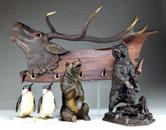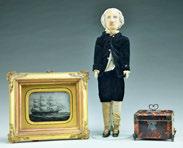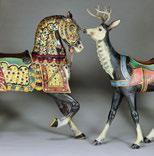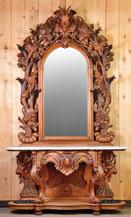August 16, 2024
by The Bee Publishing Company, Newtown, Connecticut

August 16, 2024
by The Bee Publishing Company, Newtown, Connecticut





Q&A: James Rohrbach
Coeur D’Alene’s Best Of The West Auction Corrals $17 Million
Haid, Fannon, Kangas Collections & More Propel Guyette & Deeter’s July Auction To Nearly $5 Million
Carrell’s Sale Of Gary Long’s Bicycle Collection Wheels Out Rarities
Variety Was Key At Burchard's Sizzling Summer Auction
Book Reviews
Dallas Museum Of Art — Frida: Beyond The Myth
Landscapes, Lalique & Lighting Light Up At Magnusson
New Mexico’s Unique Culture Shines At Santa Fe Art Auction
Prints, Paintings & Photographs Punctuate La Belle Epoque Summer Auction
Looking Fashionable At Tremont — Louis Vuitton, Chanel & Designer Jewelry Shine In Couture Auction



Live bidding to begin Sunday, August 18th at 11AM.
Preview Friday and Saturday, August 16th & 17th from 10-4PM.





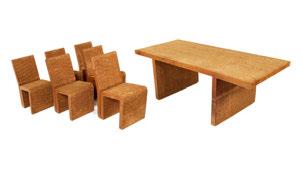






Hans
For

&


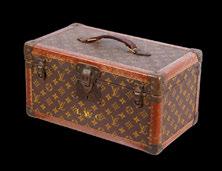






The carefree days of summer bring another fine auction from Amero Auctions to be held on August 18th, 2024, in Sarasota, FL. This auction features the second phase of the liquidation of Duck and Dolphin Antiques store from Key West, the Alexander Raydon Gallery art collection, and the sword collection of Bob McGregor, plus many more items curated from estates throughout the country. Art highlights bringing the heat include “Explosion” from Portfolio 9 by Roy Lichtenstein, 3 Stephen Rolfe Powell glass sculptures, Alberto Gironella triptych, school of Sebastian Bourdon portrait, Querubim Lapa ceramic plaque, Rockwell Kent original sketches, bronzes, and carved marble sculptures. A bonanza of French parcel gilt bronze pieces, mid-century to include Frank Gehry Easy Edges dining table and chairs, Hans Wegner chair, 1970’s Eames lounge chairs and ottomans, midcentury artwork. Luxury goods including Hermes, Rolex, Cartier, Jaeger-LeCoultre, a 4.12 carat diamond solitaire necklace, Tahitian pearls, diamond & gemstone necklaces and bracelets all represented. Early French and Italian furniture and mirrors, period American and English Furniture, nice collection of rugs, and Americana. Chinese and Japanese ceramics, lamps, and a stunning large marble inset center table. Bidding available in-house, by phone, or poolside on the internet.
























On June 28, The American Folk Art Museum (AFAM) announced the election of entrepreneur, investor and artist James Rohrbach to its national Board of Trustees. He is the 30th member to be welcomed onto the Board. On top of his resume in the entrepreneurial and real estate fields, Rohrbach is an artist and a passionate advocate for the arts and artists alike. Antiques and The Arts Weekly caught up with him after his election and got the scoop on his goals as a Board member, his inspirations and passions, and what he’s looking forward to.
What initially drew you to AFAM’s Board of Trustees?
I have loved and collected folk and self-taught art almost my entire adult life, and thus have frequented the museum for many years. In 2023, I connected with some members of the staff, which led me to learn more about the organization. Once I met director Jason Busch and heard his exciting vision for the future, I was keen to get involved and do my part to support the museum in realizing its goals.
How do you believe your extensive background in the real estate world will benefit you in your new position on the Board?
I started my career as a management consultant, and then spent more than a decade as an entrepreneur at the intersection of education, culture and technology before transitioning into real estate in 2019. I’m particularly interested in questions such as, “How does the museum grow its audience and impact materially but sustainably? How should its strategic plan evolve over the next decade? and What resources, processes and organizational structures do we need to support that plan?” I hope over time I’ll be able to bring to bear the skills and expertise I’ve acquired across the full breadth of my career on questions such as those.
On top of your already impressive resume, you are also an artist yourself. Can you explain what your creative process is like, perhaps sharing an example?
I make art at the intersection of text, performance and conceptual practices. My fundamental interest is in exploring what Allen Ginsburg called “the mysterious river of tears under the streets.” I interpret that line through a Jungian lens. Our society is built on these profound self-delusions regarding what guides our decisions and actions (rationality, conscious emotions, etc.), when really we all carry within us these vast expanses of psychic pain and subconscious feeling that actually drive so much of our lives, and yet which we rarely attempt to understand, much less publicly excavate. I create egalitarian and participatory performance pieces as pathways to access that world. For example, in one piece you are

invited to participate via the prompt: Sit down in front of a mirror. You can’t get up until you cry. The work can then manifest as videos and photos of the experience, written reflections after the fact, group discussions, etc. The works are open to anyone, constantly evolving and continuously available — anyone interested in participating in one should just contact me.
You have a passion for advocacy, especially when it comes to the arts and fellow artists. How has that passion shaped your career path, and what about your advocacy work do you hope to bring to the Board at AFAM?
I have two longstanding preoccupations in this area: cultural accessibility and opportunity. My first startup was a platform that helped undergraduates study abroad, and another was an adult language school — so both helped people have a broader set of cultural experiences. On accessibility, I am also a trustee of Studio in a School, which is such a powerful positive force for K-12 arts education, and I do a bit of writing about art, with an intended tone of “serious but accessible” — as a small rebuttal against artspeak and in the

hope that perhaps it will inspire appreciation for and curiosity about art in new hearts.
On opportunity, I believe artists are done a gross disservice in that they are generally not taught the business side of an artistic career (for example: marketing, operations, basic budgeting and strategic planning), or indeed even encouraged to think of themselves as capable in those areas. So I try to share my business knowledge to help artists thrive, specifically as a mentor at NEW INC and as an advisor to Paddy Johnson’s VVrkshop.
AFAM is a very natural place for me to continue this work. Folk and self-taught art is definitionally accessible — in who makes it and for whom it is intended. Relatedly, these artists are also a priori unsupported — outside of the commercial art system. So, in my mind, two core missions for the museum are to put this approachable art in front of as large and diverse an audience as possible, and, through both that amplification and through intentional programs, to provide support to the artists themselves. Finally, I think AFAM has a special opportunity to expand its impact in these areas in the decades ahead. The lines between folk and self-taught art and the traditional fine art world are rapidly blurring. Look at how many major museums have held shows of self-taught work in the past few years; at how many blue chip artists are explicitly inspired by and responding to self-taught work; at how our entire society is reflecting profoundly on questions of inclusion and exclusion. And then add AI (artificial intelligence) art into that heady mix. Isn’t AI art the next frontier of self-taught art, opening up radical new opportunities and posing thorny questions? The moment is ripe for AFAM’s leadership.
What are you most looking forward to in your tenure on the AFAM’s Board of Trustees?
First, I very much hope to have a positive impact. I want to make a difference, and specifically to help the museum grow its reach and influence. Additionally, I’m really looking forward to getting to know my fellow trustees and the staff, all of whom seem so wonderful, and to deepening my knowledge of folk and self-taught art through focused study and attention.
—Kiersten Busch
R. Scudder Smith, Founder (1963) Helen W. Smith
Sherri Smith Baggett Co-Publishers
PUBLISHED EVERY WEEK BY The Bee Publishing Company Newtown, Connecticut 06470
Periodicals Postage Paid at Newtown, Connecticut 06470
Madelia Hickman Ring, Editor W. A. Demers, Senior Editor Laura Beach, Editor At Large Carly Timpson, Assistant Editor Rick Russack, Contributing Editor Cindie Gannon, Advertising Manager 203-426-8036 (antiques advertising only) or 203-426-3141 (subscription and other information) or Fax. 203-426-1394 email (advertising) - ads@thebee.com email (subscriptions) - subscriptions@thebee.com email (editorial) - antiques@thebee.com
ADVERTISING RATES
Display: $19 per column inch Auction: $25.20 per column inch
(Early) Auction: $22.50 per column inch for ads received prior to 10 am Thursday, for the next
Payment must accompany ad unless credit has been established
display advertising and editorial material must be received by Friday at 10 am; Auctions by Monday at 10 am (except Early Auctions - see above) for the issue dated the following Friday. PAGE LOCATION MAY BE REQUESTED AND WILL BE FOLLOWED IF POSSIBLE
ADVERTISING POLICY
Antiques and The Arts Weekly reserves the right to refuse any advertisement submitted for publication. Further, it cannot guarantee the quality of services advertised in its pages, nor the unquestionable authenticity of objects advertised and it cannot accept any responsibility for misunderstandings that may arise from the sale or purchase of services or objects advertised in its pages. Advertising position is not guaranteed - will be honored, if possible.
POSTMASTER: Send address changes to THE BEE PUBLISHING CO, 5 Church Hill Road, Newtown, CT 06470-5503
SUBSCRIPTION
Other Rates Available, Please Call 203-426-8036 or subscribe online at www.antiquesandthearts.com
EFFECTIVE March 1, 2023













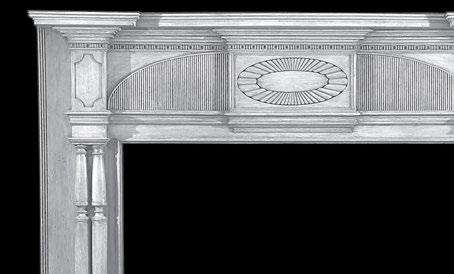



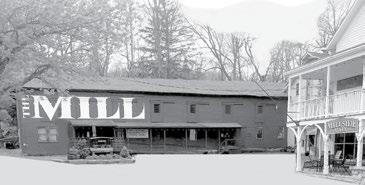



COPAKE, N.Y. — On Saturday, August 24, Copake Auction will conduct an unreserved estate auction of more than 900 lots. The sale starts at 10 am Eastern Time and auctioneer Seth Fallon has been known to sell as fast as 120 lots per hour. Live bidding is in person, by phone and through LiveAuctioneers and Invaluable. More absentee bidding options are available. Gallery preview is Thursday and Friday, August 22-23, from 10 am to 4 pm.
The sale features two prominent collections with additions from other regional estates. Contents of a 40-year collection from antiques dealers Ed and Anita Holden will be offered, including a selection of weathervanes, period furniture, folk art, fine art, clocks, decorative items, samplers, hooked rugs, metalware, china, crocks, quilts, several Native American items, fishing items/lures and boat dioramas. Several standout items include a Cushing & White cow weathervane, a pair of Nineteenth Century ancestral portraits in tiger maple frames, a Nineteenth Century wooden polychrome painted countertop cigar store figure, a signed Frank Christian Muller (1860-1938) oil on canvas seascape, an Eighteenth Century Pennsylvania inlaid tall chest, a Nineteenth Century Maine pine paint decorated chest, a set of six


Nineteenth Century Windsor chairs, a half hull boat model marked “Cable Steamer,” “Pouyer-”Quertier,” “C. Mitchell & Co. Builders Newcastle On Tyne 1879” and much more, totaling 300 lots dispersed throughout the catalog and indicated as part of the collection in every description. Also on offer is the second
session of the estate of actor Edward Herrmann (1943–2014), known for his portrayals of Franklin D. Roosevelt in both the miniseries Eleanor and Franklin (1976) and 1982 film musical Annie , Richard Gilmore in Gilmore Girls (2000–2007) and a ubiquitous narrator for historical programs on the History Channel

and in such PBS productions as Nova. Herrmann was an eclectic collector of militaria, including posters and fine art, medals, trunks and uniforms. Items from Herrmann’s estate also includes automobilia — advertising signs, posters, signed memorabilia, trophies and awards, photographs, car illustrations, ad cut-outs and training models — and a large selection of toys, such as W. Britain horses and jockeys, soldiers, car, bus, plane and truck models, Marx tin litho wind-up and trains and accessories. One of the prizes of Hermann’s collection will be offered in a future sale — a presentation Turkish Jambiya dagger with 1918 inscription and carnelian stone given to Lowell Thomas from Col. T.E.
DALLAS — On July 30, The Meadows Museum, SMU, announced that it has acquired two Seventeenth Century works by women artists: a still life by Josefa de Ayala (circa 1630–84) and a painted cell cross by María Josefa Sánchez (active 1639–52). Ayala was a seminal figure in Iberian Baroque art who achieved recognition and numerous commissions during her lifetime, and was one of the few independent, documented women artists from the period. Together, the acquisitions are indicative of a vibrant artistic climate on the peninsula which did allow women some freedom of expression. Both
were purchases made with funds from The Meadows Foundation, and both will be on view in the Meadows’ galleries by the fall.
“We are thrilled to add these significant works to our collection,” said Amanda W. Dotseth, Linda P. and William A. Custard director of the Meadows Museum. “The exquisite example of Ayala’s work showcases the artist’s masterful technique and her strength at infusing still-life compositions with both aesthetic beauty and profound symbolic meaning, while Sánchez’s moving cell cross not only demonstrates her artistic skill but also highlights her role in fashioning

the religious expression and spirituality of the time. We look forward to the educational and research opportunities that will stem from these acquisitions, and what we will uncover about the lives of women artists in the Seventeenth Century.”
These two paintings — now the earliest in the collection known to be by women artists — join the growing number of works by women artists in the collection, which include Luisa Roldán (1652–1706), Francisca Efigenia Meléndez y Durazzo (1770–1825), María Blanchard (1881–1932), Helen Escobedo (1934–2010) and Cristina García Rodero (b 1949).


Lawrence (of Arabia). Also included in the sale will be a large selection of antique banks, Japanese wood block prints a selection of Elijah Slocum furniture, a Louis Vuitton trunk, a folk art Uncle Sam carving (48 inches high), a Henri Gustave Jossot (18661951) poster, a large (72 inches long) cast metal panther statue, an Edith Sommerville (British, 1858-1949) hand-colored Nineteenth Century equestrian print and more. Copake Auction is at 266 E Main Street. For information, 518-641-1935 or www.copakeauction.com.
The Meadows Museum, SMU, is at 5900 Bishop Boulevard. For additional information, 214-7682516 or www.meadowsmuseumdallas.org.



MINT ITEMS
•ANYTHING BY TIFFANY
•ALL STERLING SILVER & JUDAICA

•ALL ENTERTAINMENT MEMORABILIA
•ANY BETTER AUTOGRAPHS, LETTERS DOCUMENTS
•THE RARER AND MORE UNIQUE, THE



ST PETERSBURG, FLA. —
On July 21, Burchard Galleries conducted its Estate Antiques, Fine Art and Jewelry Auction, which offered 517 unique lots, including a partial selection of
the lifelong collection of Charles and Sylvie Lightfoot. The Lightfoots are hoteliers who have lived in more than 20 different countries in their lifetimes. “The sale went pretty good,” reported
Adam Shown, Burchard’s online auction coordinator. “We had an air conditioning unit that was not working, but a lot of our buyers are loyal enough that they came and pushed through it.”

Headed to Miami, Fla., was this set of five antique oil on canvas paintings of the four cardinal virtues and a shepherd. They were removed from a Parisian train station during renovation and ranged in height from 5 feet 10 inches to 6 feet 10 inches. The set sold for $6,150 ($8/12,000).

On either side of this gilt console table and mirror are a pair of Sèvres-style hand-painted urns with their matching pedestals, which crossed the block for $4,920. Cataloged as “incredible museum quality” and “palatial,” the pair of urns both depicted figural festival scenes signed by the artist and were surmounted by pinecone finials. The pair had provenance to the Lightfoot collection ($12/15,000).

“Roseate Spoonbills” by Jim Foote (American, 1925-2004), oil on canvas, 29¼ by 35 inches framed, signed lower right, was a hit at Burchard: “We like Jim Foote here. Our director [Jeffrey Burchard] has a particular affinity for his work. It’s gorgeous and really well executed,” commented Adam Shown. It flew to $4,613, nesting within its estimate ($3/5,000).

“Duet” by Harry Aaron Kernoff (Irish, 19001974), oil on board, 9¼ by 11¼ inches framed depicted two figures in a tavern with an accordion. It had a Vincent Price collection label affixed verso. “I personally liked this one,” said Adam Shown. “For what it sold for, it’s really not that big. You can tuck it under your arm and take it out the door.” The painting played its way to its new home for $4,613 ($800-$1,200).
Review by Kiersten Busch, Assistant Editor
Photos Courtesy Burchard Galleries

This 14K gold ruby and diamond necklace and bracelet set earned a sparkling $4,305. In the Cartier style, the set was mostly made of yellow gold, but, between both pieces, included 12 diamonds and 12 rubies. Adam Shown called the set “A very elegant piece of jewelry” ($3,85/4,500).
“There was a good mix of online, absentee, phone and inperson bidders,” said Shown. Around 50 buyers came to bid in person, while Burchard reported around 50 bidders spread throughout phone, absentee and online bidding as well. All of the top-selling lots were very different, providing a diverse spread of offerings for bidders. Leading the sale was “Soliel Couchant,” a lithograph after Marc Chagall. The lithograph, an interpretive work based on one of Chagall’s paintings, was done by his trusted friend, Charles Sorlier. According to the auction catalog, “These so-called afterworks are currently some of the most valuable and sought-after works of Chagall’s entire artistic oeuvre.” The print was signed lower right and numbered “87/150” lower left. It crossed the block for $7,073, within estimate. It was “a neat little Chagall piece that is not quite entirely Chagall, but a little bit of someone else too,” Shown explained.
A set of five antique oil on canvas paintings from a Paris,

“Soleil Couchant” a lithograph after Marc Chagall (American/French, 18871985) by Charles Sorlier, 29¼ by 20¾ inches, numbered “87/150,” signed in pencil lower right, was secured for $7,073, the highest price of the sale ($5/8,000).

This vase with a tug-of-war scene between octopi, frogs and crabs was made by Maria Longworth Nichols (American, 1849-1932), the founder of Rookwood Pottery in Cincinnati, Ohio. It measured 11 inches high by 7½ inches at its widest point and hopped its way to a $6,150 finish ($8/12,000).
France, train station made $6,150. Described as “quite the conversation starter” in the auction catalog, four of the five works depicted the four cardinal virtues: prudence, justice, fortitude and temperance, while the fifth painting depicted a shepherd. “These came out of a particular high-end estate that we are handling… they were apparently in train station somewhere in Paris, then taken off the walls while the station was being renovated and sold to collector,” said Shown, who shared his enthusiasm for the pieces, adding, “They are very neat.” The set of five were sold from Paris to a New York jeweler and eventually came to reside in a Naples, Fla., mansion before being consigned. They will stay in Florida with their new buyer, but are traveling to a new city, Miami.
Despite some hairline cracks and previous repairs, bidders raised a Rookwood Pottery vase designed by founder Maria Longworth Nichols to $6,150. Categorized as “rare” in the auction catalog, the vase had impressed geometric designs on its rim and foot and featured a “whimsical” hand-painted tugof-war scene with octopi, frogs and crabs on its body. On the underside, it was signed “M.L.N.” and stamped “Rookwood, 1882.”
“We usually try to get at least two or three complete, or mostly complete, silverware sets in every auction,” said Shown, when asked about the 53-piece sterling silver Tiffany & Co., flatware service in the San Lorenzo pattern, which landed at the high end of its $3/5,000 estimate. “This [set] wasn’t loose, it had the original case and was in very good condition. It was going to go to a good home with a private buyer.” In total, the set weighed approximately 70 troy ounces and included dinner and luncheon knives, dinner forks, soup spoons, teaspoons, large serving spoons, sold handled butter knives, a cream spoon and a pickle fork. It closed the lid for $4,920.
Burchard Galleries’ next sale will take place on August 17.
Prices quoted include the buyer’s premium as reported by the auction house. For information, www.burchardgalleries.com or 727-821-1167.

Sold to a private buyer for $4,920 was this 53-piece
OAKLAND, CALIF. — Clars will present its jewelry and timepieces auction on Friday, August 15, starting at 9:30 am Pacific time. This auction features a collection of both antique and contemporary jewelry, perfect for adding a touch of elegance to one’s summer wardrobe. Highlights include Art Deco pieces such as a diamond and 14K white gold bracelet and rock crystal brooch ($700/900); a diamond and 14K white gold engagement ring with guard ($500/700); and an Art Deco diamond and 14K white gold pin ($300/500).
In addition, Clars will offer items like a pair of cultured pearl, diamond, platinum and white gold day/night clip earrings ($8/12,000); an emerald and 14K gold necklace ($5/7,000); and multi-color sapphire, diamond and 18K gold hoop earrings ($3/4,000). Other notable pieces include an amethyst and 14K gold necklace (3/5,000); a tanzanite, diamond and 18K white gold ring ($2/3,000; a mabé cultured pearl, diamond and 18K gold earring and ring set ($1,2/1,800); a multi-hue South Sea cultured pearl and 14K gold necklace ($1,2/1,800); and a tiger eye men’s ring ($1,2/1,800).
The gallery sale will showcase a diverse array of items including silver, porcelain, glass, furniture, Indigenous art and carpets. Among the standout pieces are collections of Meissen porcelain and contemporary Inuit masks of substantial size, as well as a carved Renaissance cabinet and a Louis XVI-style brass inlaid roll-top secretary desk. Additionally, classic furniture selections from Old Hickory and McGuire will complement the sale. Clars will feature a variety of fine art, including works by international artists in painting, sculpture and printmaking. A highlight of the auction is an oil on canvas by Dutch painter Barend Cornelis Koekkoek, known as the “Prince of Landscape Painting.” Koekkoek, a prominent figure in Dutch Romanticism, created lush, light-infused landscapes that captivated roy-



Doug Hyde (Assiniboine/American, b 1946), “Hopi Butterflies,” bronze, 31 by 56 inches ($10/15,000).
the sea. This work, given by Zhang to Harvey CV Liu, conveys a poignant farewell.
Another significant piece is Daqian’s “The Scholar,” showcasing his skillful character delineation and elegant figure portrayal. Additionally, Pu Ru’s fan painting “Secluded Dwelling in Autumn Mountains” will be featured. Known for his refined and meticulous brushwork, Pu Ru’s painting renders a harmonious landscape, a gift from Pu Ru to a collector’s father.
items, enamel pins and watch fobs, as well as Panama Canal memorabilia. Felt pennants, photographs, and presentation articles related to exposition president Charles C. Moore, San Francisco mayor James Rolph Jr and US President William Howard Taft are also available. Complementing the historical collection, this monthly sale also boasts a wide array of contemporary and antique furniture, decorative arts and rugs.
alty and influenced later artists.
The painting in this auction depicts travelers strolling through a verdant countryside, with natural light casting dramatic pink and golden hues.
Another notable piece is by modern American artist Jane Wilson, known for her expressionist landscapes. Wilson’s work, including the 1955 painting “Summer Breakfast,” blends elements of expressionism with her Midwestern background.
This piece portrays a contemplative scene of two women at breakfast, reflecting the moody, emotive quality characteristic of Wilson’s style.
Also featured is a bronze sculpture by Native American artist Doug Hyde. Born of Assiniboine, Nez Perce, and Ojibwe heritage, Hyde’s work often draws from Indigenous mythology and history. The bronze sculpture titled “Hopi Butterflies” captures a group of women in traditional
Maine Antiques Dealers To Hold 25th Annual Coastal Maine Antiques Show At New Location In Waldoboro
WALDOBORO, MAINE — The Maine Antiques Dealers Association (MADA) is conducting its 25th annual Maine Coastal Antiques Show on Wednesday, August 14, in a new location at Medomak Middle School, 318 Manktown Road in Waldoboro. The show runs from 10 am to 3 pm and will feature a wide array of antiques and art offered by MADA members. The show will be air-conditioned and have food and onsite catering available.
“We are excited to have the 25th anniversary of our Maine Coastal Show in Waldoboro. It’s a great central location on Maine’s midcoast, and the school building allows us to have all of our dealers in one space,” said Joe Bent, MADA president. For more information on the MADA Maine Coastal Show, contact Eizabeth DeSimone at edesimone@goosefarentiques.com.

dress engaged in conversation, showcasing Hyde’s modernized yet respectful interpretation of Indigenous subjects.
Clars will host an Asian fine art auction. The auction includes contemporary Chinese ink paintings, Tibetan black-ground thangka of Vajrabhairava, Chinese cloisonné enamel burners, a pair of Chinese jade and hardstone lacquer panels, jades, porcelains, embroidery and other diverse items.
Key highlights include Zhang Daqian’s “Setting Sail,” a 1977 ink and color hanging scroll depicting cottages and boats by
The Warehouse Sale on Saturday, August 17, 9:30 am offers an extensive private collection of items from the 1915 PanamaPacific International Exposition in San Francisco. The collection includes original glass Novagems, sterling trophies, exhibit



Bidding for Clars’ August auctions is available by phone, absentee bid and live online at www.live.clars.com and through www.liveauctioneers.com and www.invaluable.com. Clars Auction Gallery is at 5644 Telegraph Avenue. For information, www. clars.com or 510-428-0100.

back buttons, ribbons, banners, paper, photographic badges, 3-D & unusual.





DANVERS & BEVERLY, MASS. — Kaminski Auctions will conduct a unique onsite auction event on August 17 at 11 am, showcasing the contents, garden ornaments and stunning stained glass windows of the monastery of the Carmelite Nuns in Danvers.
Established in 1958 on land formerly occupied by a golf course, the Danvers monastery was opened under the guidance of His Eminence Richard Cardinal Cushing, DD, LL.D. A year later, Bishop Fenwick High School was constructed on the adjacent property, which sits at the intersection of Danvers, Salem and Peabody. The chapel of the monastery is now permanently closed, and this auction marks a rare opportunity to acquire items that once held sacred significance within its walls.
Kaminski Auctions will feature a range of notable items from the chapel, including large multi-sectional stained glass windows, an elegant marble altar, various lighting fixtures, chalices, candlesticks and monstrances, alongside garden statuary. Many of these items reflect the Brutalist style, offering a unique appeal to midcentury collectors seeking distinctive pieces for their collections.
Note that buyers will be responsible for the removal and associated costs of transporting purchased items. Kaminski Auctions will provide recommendations for two experienced companies specializing in glass removal and transport to facilitate this process.
The auction will take place at the Carmelite Monastery, 15 Mount Carmel Road, Danvers, Mass. The preview for this auction will take place on August 14-16, 9 am to 5 pm at the monastery. Interested parties are encouraged to attend to experience the remarkable beauty and craftsmanship of these items firsthand.



Sunday, August 18, at Kaminki’s gallery in Beverly features a selection of contemporary, midcentury and European art and a unique collection of Harlem Renaissance art by the painter Romare Bearden from the estate of Anthony Cromwell Hill of Cambridge, Mass.
A top lot of the auction is a Paul Jenkins (American, 19232012) contemporary painting titled “Phenomena Lure of Cardinal Red.” The painting is acrylic on canvas, 72 by 56 inches, and is from the estate of the late Maurice and Myna Perlstein of La Jolla, Calif., and Chicago. In the contemporary category, there is also a Peter Max oil on canvas, signed and dated 1988, measuring 30 by 40 inches. From the German expressionist Hans Richter (German, 1888-1976), a gouache on paper, titled “Composition,” and initialed H.R. lower right. There are also several entries by Rich-
ard Pettibone. Contemporary sculpture features Jeff Koons’ blue “Balloon Dog.”
European highlights include a signed watercolor/gouache, dated 1914 by Emil Nolde (German-Danish, 1867-1956), titled “Manam Motu,” Papua New Guinea (200/300,000). Other artists represented include Frank Helmut Auerbach (German-British, b 1931), Karl Schmidt-Rotluff (German, 18841976), Albert Marquet (French, 1875-1947) and Pieter Willem Sebes (Dutch, circa 1827-1906).
Another notable entry is an Eighteenth Century oil on canvas attributed to Giovanni Antonio Canal (Canaletto) from a Palm Beach, Fla., estate.
American painters represented in the auction include Ralston Crawford (1906-1978), Philip C. Curtis (1907-2000) and from the American Impressionist artist Mary Cassatt, a still life study of grapes, an oil on board from the
Debra Gold collection, Godel & Co., Fine Art, New York. American sculpture includes a bronze sculpture of a boy holding flutes by M.A. Aldrich and a bronze titled “Girl Contortionist” by Paul Granlund (American, 19252003). There are several ceramic pieces by David Gilhooly from the estate of the late Maurice and Myna Perlstein.
The silver category has a Tiffany & Co., sterling Chrysanthemum pattern flatware service totaling 287 pieces and Georg Jensen collectors will note a sterling flatware service of Acanthus, a seven-piece place setting for 12 with serving pieces.
Art glass in the sale features a red L.C. Tiffany Favrile, #665H, signed, from a Sherman Oaks, Calif., collection.
Jewelry highlights include a Touchon & Co., platinum and diamond pocket watch with 14K white gold and diamond book-

ARLINGTON, TEXAS — The Arlington Museum of Art (AMA) presents the continuation of its ongoing collaboration with the Rubell Museum through the presentation of a new exhibition of work by women artists curated from the Rubell Museum’s expansive contemporary art collection. “She Said, She Said: Contemporary Artists from the Rubell Museum” premieres on August 17 as part of the AMA’s opening year in its new location within the Arlington Entertainment District.
“She Said, She Said” features more than 50 works spanning painting, photography, sculpture, video and installation by more than 30 artists of different generations, cultures and disciplines. Presented thematically as well as with several galleries dedicated to solo presentations, “She Said, She Said” examines topics that include representations of
the body, appropriation and subversion, self-portraiture and gestural abstraction. Highlighting the significant contributions to the canon that women artists continue to make, the exhibition also offers focused explorations of work by contemporary practitioners such as Solange Pessoa, Beverly Semmes, Cajsa von Zeipel and Allison Zuckerman. “She Said, She Said” is curated by the Rubell Museum’s Alexandra Perez and will remain on view through November 3.
“Through our continued collaboration with the Arlington Museum of Art, we are able to bring our collection to new and broader audiences, reflecting our mission to showcase and encourage public dialogue about work by a wide range of contemporary artists,” says Mera Rubell. “Advancing our commitment to supporting and championing artists, ‘She Said, She Said’ showcases diverse
form fob and 14K white gold chain.
Asian highlights feature a Nineteenth Century China Trade painting, “The Hongs at Canton,” thought to be Sunqua, in an oval frame with flags of America, Britain, Denmark, France and German states, and a Chinese watercolor scroll of a landscape signed Baoshi by Fu Baoshi.
This August 18 estates auction will occur at the Kaminski Auctions gallery, at 117 Elliott Street, Route 62, in Beverly, starting at 11 am Eastern time. The preview will take place at the gallery Monday through Friday, August 12-16, 9 am to 5 pm, and on the day of the auction, starting at 9 am. The preview is open while the auction is live.
Bidding is available in person, by phone or absentee bid and online with KaminskiLIVE. For information, 978-927-2223 or www.kaminskiauctions.com.
perspectives and illustrates the important contributions of women artists working today.”
“She Said, She Said” represents the third collaboration between the Arlington Museum of Art and the Rubell Museum. In 2019, the AMA presented “Keith Haring: Against All Odds,” a retrospective spotlighting works ranging from the artist’s best-known imagery to more personal pieces, timed to the 50th anniversary of the Stonewall Riots. In 2021, the AMA presented “30 Americans,” a powerful showcase of works by 30 emerging and established African American artists that examines issues of racial, sexual and historical identity in contemporary culture and the powerful influence of artistic legacy and community across generations. The Arlington Museum of Art is at 1200 Ballpark Way. For information, 817-275-4600 or www. arlingtonmuseum.org.


Circa 1875 George Jones majolica full nest game tureen with a hen and her chicks atop a bed of leaves and ferns as the cover 14 inches long ($12/15,000). Minton majolica vulture and snake teapot and cover, circa 1874, designed by Henry Hope Crealock, modeled as a vulture fighting a python ($20/25,000).
WOLCOTTVILLE, IND. —
The third and final auction dedicated to the majolica collection of Edward Flower (1929-2022) and his wife Marilyn (1930-2017) will be conducted on Tuesday, August 20, beginning at 10 am Eastern time, online and live at the Strawser Auction Group gallery.
As in both prior auctions, the third sale will feature many of the finest names in all of majolica production: Minton, George Jones, Holdcroft, Wedgwood, Hugo Lonitz, Palissy, Massier, T.C. Brown Westhead Moore & Co., Copelands and others — 223 lots in all. The collection comprises more than 600 pieces.
A strong candidate for toplot of the auction is an iconic Minton majolica vulture and snake teapot and cover, circa 1874. It was designed by Henry Hope Crealock and modeled as a vulture fighting a python — a raptor with a pink neck and head battling a struggling green serpent on a rocky base; the teapot, with a $20/25,000 estimate, sits at 10 inches tall.
A rare George Jones majolica centerpiece, 14 inches tall, should hammer for $12/15,000. Modeled as a giraffe and a stag eating from a tree beneath a large bowl and emerging from a small burrow, the centerpiece is one of only two known and is arguably the most desired George Jones piece.
A circa 1875 George Jones majolica game tureen, features a hen and her chicks atop a bed of leaves and ferns as the cover, a base with rabbits in a meadow and branch handles with oak leaves and acorns ($12/15,000).
A large, circa 1875 Minton majolica carp tureen is 7 inches in height and 23 inches long. The cover is formed as a large carp, and the handle is formed as a lemon; it has a presale estimate of $8/12,000.
An 18¾-by-16-inch Charles Avisseau majolica Palissy Art of the Earth dish, circa 1865, has the oval basin covered in fauna, leaves, lizards, snails, a frog, a large fish, crayfish and a pike at its center, ($8/12,000).
A monumental circa 1865 Minton majolica Renaissance
Revival ever on a stand designed by Hughes Protat and painted by Thomas Kirby — with a panel of hand-painted putti in clouds to the center, a seated cherub and dolphin on fluted shoulders, an arched handle formed as conjoined serpents supported by cherubs and an entwined serpent above a circular base — should hit $6/9,000. This is the only known painted example.
A Minton majolica Neoclassical vase and cover, circa 1865, the fluted Eighteenth Century Sevres-style body having three rams’ heads conjoined by draped laurel, with three satyrs around, the domed lid with a putti with pan pipes finial, all on a circular pierced platform base, is one of only three known examples ($6/9,000).
A rare Hugo Lonitz majolica figure modeled as a hawk, circa 1880, perched on rocky ground and standing 16 inches tall, is expected to fly away for $6/9,000.
A scarce Medieval Revival Minton majolica triple horn flower stand — modeled as three white hunting horns entwined about a central brown trumpet, the stem molded and applied with fir branches and cones on a yellow banded circular foot, the horns banded and conjoined by metal chains, standing at 28½ inches tall — should hit $4/6,000.
A monumental and rare Minton Conservatory jardiniere, circa 1865, is modeled as a three-seated Melusine draped with garlands facing outward against a column of four outfacing herons, their wings supporting a large circular deep bowl wide border of lilies, all upon three scroll feet. The jardiniere is expected to find a new owner for $3/5,000.
A hard-to-find, circa 1875 George Jones tortoise cuspidor, formed as a tortoise, the top of the shell forming the cover, is 5 inches tall and 10½ inches long ($3/4,000). This piece was in the “Majolica Mania” exhibition, presented 2020-22 at the Bard Graduate Center in New York.
A George Jones majolica Aesthetic Movement
sparrow jardiniere, circa 1875, should garner $800-$1,200. The body is molded with bold leaves and blossoms with large java sparrows all upon plump leaf feet.
A preview will be conducted in the Strawser Auction Group gallery at 200 North Main on Monday, August 19, from 4 to 6 pm Eastern time. For information, 260-854-2859, 260336-2204 (cell) or www.strawserauctions.com.
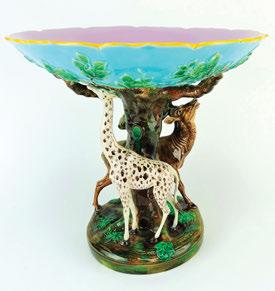
Rare and important George Jones majolica centerpiece, 14 inches tall, modeled as a giraffe and a stag eating from a tree beneath a large bowl ($12/15,000).
Village
Mashpee, Cape Cod • at Steeple St & Job’s Fishing Rd • Naukabout Beer Garden will be selling during the show. Enjoy a craft brew while shopping for Fine 18th, 19th & early 20th c. furniture, silver, jewelry, Americana, glass, china, Nautical, prints, paintings, garden, decorative, & more Adult Admission from 10 - Noon: $6.00; With This BEE Ad $5. After 12 pm, Admission is FREE Goosefare Promotions, 800-641-6908 goosefare@gwi.net

•
• GENEROUS REFERRAL FEES PAID
• SWIFT PAYMENT TERMS
• DETAILED AND ACCURATE CATALOG DESCRIPTIONS WRITTEN BY PROFESSIONAL GUN PEOPLE









DALLAS — This August, the Dallas Museum of Art (DMA) premieres “Frida: Beyond the Myth,” bringing together approximately 60 works by Frida Kahlo and her contemporaries to explore the life of one of the most revered artists of the Twentieth Century. Lifting the veil of myth that obscures our understanding of the artist as an individual, the exhibition delves deeper into the defining moments of Kahlo’s life as depicted through her self-portraits, still lifes, key biographical drawings and captured in photographs by the friends and fellow artists who knew her best. Cocurated by Dr Agustín Arteaga, the DMA’s Eugene McDermott director, and Sue Canterbury, the Museum’s Pauline Gill Sullivan curator of American art, the exhibition is on view at the DMA from August 18 through November 17. “Frida: Beyond the Myth” is organized by the Dallas Museum of Art and is presented by Texas Instruments.
“The mark of a great artist is their ability to translate into art what’s in their hearts and souls, so that others may understand; Frida Kahlo is a great example of this,” said Andy

Smith, executive director of the TI Foundation and TI director of giving and volunteering. “She was a brilliant artist whose themes around identity are still influential today. We are honored to sponsor this exhibition of Kahlo’s works so that others can learn from how she expressed her reality and apply it to their own self-discovery. This is yet another example of groundbreaking exhibitions that the Dallas Museum of Art is bringing to our city, continuing to build their and Dallas’ reputation around the world.”
Despite her position as one of the most documented artists of the Twentieth Century, Frida Kahlo (19071954) remains an elusive figure, clouded by a mythology that focuses on her significant personal challenges: her relationships, her injuries and many surgeries and the lifelong pain she endured over her short life. Even the works she created — which expressed her emotive responses to these powerful events — hinder our understanding of Kahlo as an individual, as she constructed a persona of opposing characteristics: seductive and innocent, strong and vulnerable. However, through the lens of Kahlo’s

family, friends, lovers and fellow artists who captured different aspects of her life and personality, we are granted additional perspectives on the woman behind the myth.
“Frida Kahlo has always received a warm welcome at the DMA. From our 2017 blockbuster exhibition ‘Mexico: 1900-1950’ to the more focused presentation of five of her works that we exhibited three years ago, audiences flocked to the Museum to behold the work of this cultural icon,” said Arteaga. “Though Kahlo is beloved for her vibrant and emotional paintings, there is still much to learn about who she was as a person. Through this exhibition, we hope to peel back some of the layers to reveal more about the individual who continues to captivate audiences here and around the world.”
“Frida: Beyond the Myth” brings together a selection of nearly 30 of the artist’s paintings, drawings and prints that she embedded with symbolic representations of her emotional state at various points in her life These self-portraits and still lifes are complemented by prints and photographs of Kahlo by those closest to

her, including Diego Rivera, Nickolas Muray, Henri Cartier-Bresson, Lola Álvarez Bravo, Julien Levy and more. Together, these works offer a closer examination of the events that shaped Kahlo’s life and how she responded to them, progressing chronologically from her early childhood in Mexico, to her tumultuous marriage to Diego Rivera, her blossoming career between Mexico and the United States and her difficult final years — as well as the devastating injuries, illnesses and chronic pain she suffered most of her life.
“Frida Kahlo was incredibly selfaware, carefully constructing the persona that she uses to represent herself in her artworks. Through this persistent self-fashioning, Kahlo was, in essence, the architect of her own myth — a myth that she was ultimately devoured by,” said Canterbury. “It is only through the eyes of those around her that we are able to get closer to who she really was, seeing her as she was seen and not only as she saw herself.”
The Dallas Museum of Art is at 1717 North Harwood. For information, 214922-1200 or www.dma.org.

WILLOW, N.Y. — Small watercolors and oils on paper by Julianna Cox will be making a return engagement to the James Cox Gallery at Woodstock in a special exhibit on view from Friday, August 16, through Friday, September 20. In November 2019, the artist debuted her miniature paintings in an exhibit at the gallery titled “Small Marvels.” Encouraged by the success of this introduction to her paintings, which ranged in size from 1½ by 3 inches to 5 by 7 inches, Cox has continued to pursue subjects that translate well on a small forma
The artist is no stranger to the Hudson Valley. She and her family moved to Woodstock from Brooklyn, N.Y., in the summer of 1990. That autumn Julianna’s father, James Cox, opened his eponymous gallery on Elwyn Lane, eventually relocating his showrooms to the family’s property in nearby Willow.
Though the artist pursued a professional career in animation, graduating from School of Visual Arts with a BFA in that field in 2003, she has always maintained an interest in fine art. She studied portraiture with Lois Woolley, life drawing with Dean Keller, watercolor with Staats Fastholdt and landscape painting with her mother, Mary Anna Goetz, all prominent faculty members at the Woodstock School of Art.
The artist’s new exhibit, titled “Fleeting Moments,” will again feature miniature works. When asked about the advantages of working on a small format, Cox pointed to “portability.” On a more aesthetic note, she added, “I love holding a miniature world in my hands.” Many pieces in the exhibit were painted while the artist traveled by train from Canada to New York. “Portability is definitely a plus here,” she quipped.
When asked how she manages to capture so much information while moving swiftly past her subjects, Cox explained that she “generalizes” the scene, making loose line drawings and adding color and compositional notations in the margins. The next step is creation of the actual


watercolor paintings. The artist explained that she usually works on two or three paintings on each train trip, waiting for the paint to dry and the train to stop long enough to add crisp details. Finishing touches are applied in her studio.
Cox’s’ subjects range from rural locations to cityscapes of New York. Many of her landscapes feature the farmland near her home in Elora, Ontario, which she depicts in all seasons of the year. Cornfields are a particularly intriguing subject for the artist. Whether covered with snow, forming undulating patterns or spreading beneath a luminous moonlit sky, each of these scenes of the Canadian countryside is a unique jewel.
The breathtaking Catskill landscape that surrounds Cox’s family home in Willow also provides a rich source of material for the artist. Several pieces in the exhibit were painted along scenic Sickler Road, including an expansive winter view of Mount Tobias. Other Willow motifs include a cozy cottage illuminated on a cloudy night and the Willow Methodist Church, which is situated on a hill at the gateway to the small hamlet.
On frequent trips to New York Cox enjoys painting cityscapes, though she prefers quiet country settings to the noise and congestion of working in an urban environment. However, she is quick to point out that she loves the balance achieved by exploring both worlds. Among the New York
subjects featured in the upcoming show are iconic views of the Brooklyn Bridge and the World Trade Center. A more tranquil effect is created in a painting of New York Harbor, a spare composition with delicately rendered details of masts and vessels docked along the water’s edge.
Two appealing pieces in the exhibit don’t fit either category. One is of an aging moonlit building in Fergus, Ontario, near the artist’s home in Elora. The other is an interior scene of a popular hangout in Cox’s childhood home, Catskilll Mountain Pizza in Woodstock.
Julianna Cox and her husband, Payton Curtis, are wellknown artists in the field of animation. They met on the film set of Coraline, a dark stop-action animation production based on the novel by Neil Gaiman, who also lives in Woodstock. Both continue to work on animation projects and own the town movie house in Elora, the Gorge Cinema. Cox believes that her training in animation has had a positive effect on her painting technique, explaining that the focus and observation skills honed learning to see things “frame-by-frame” have been helpful in creating compositions in watercolor and oil.
Many painters, including the Chinese figure painter Jin Gao, Woodstock watercolorist John Pike and well-known Canadian landscape painter Tom Thompson have influenced the artist. However, it is a Disney animation artist who

has had the greatest impact on Cox’s work. She credits Tyrus Wong, who painted the background scenes for the classic Disney film Bambi , with helping her develop a rich, layered quality in her paintings. “The multi-plane technique Disney used added so much depth,” she observed.
“A sense of depth is what I most want to achieve in my work.”
The public is invited to a gala opening reception for the artist on Friday, August 16, from 5 to 8 pm at the James Cox Gallery at Woodstock, at 4666 State Route 212 in Willow. For information 845-679-7608 or www. jamescoxgallery.com.





Nineteenth Century Chandelier Swings To Top At Kaminski BEVERLY, MASS. — Kaminski Auctions’ July Estates Auction was conducted July 20-21, featuring a lifetime collection of antiques from a Boston brownstone and additional objects from Palm Beach and Miami, Fla., estates, including luxury handbags, accessories and jewelry. Leading the 844-lot sale was a Nineteenth Century French chandelier, possibly by Baccarat. The five-branch crystal fixture had teardrop and beaded swags throughout and came from the Boston collection. Measuring 54 inches long by 35 inches wide, it sold for $5,100 ($2,5/3,500). For information, www. kaminskiauctions.com or 978-927-2223.

1940 Flash Comics #1 Makes Speedy Sum At PBA Galleries
BERKELEY, CALIF. — PBA Galleries’ August 1 auction, the DC Universe Collection Part 3: The Golden Age sale, featured 500 lots of World War IIera comic books, including some of the rarest, most iconic, most eagerly sought-after four-color treasures of all time. Top lot honors were captured by Flash Comics #1, January 1940, CGC 6.0 Resto, which carried the first appearance of Flash and Hawkman. It fell short of its estimate ($50/80,000) but still yielded a robust $39,000. For information, 415-989-2665 or www.pbagalleries.com.

Set of 12 Nineteenth Century Dining Chairs
Prove Delish At George Cole Auction RED HOOK, N.Y. — George Cole Auctions recorded some outstanding highlights from a July 27 auction that presented more than 400 lots of fresh-to-themarket antique and estate merchandise hand-picked from the Hudson Valley. Leading it all was a set of 12 Nineteenth Century carved oak and leather upholstered dining chairs (shown) that sold for $5,760. Other standouts were a Nineteenth Century gilt bronze and marble Louis XIV-style gueridon that brought $1,778 and a pair of Twentieth Century Regency-style black lacquer and faux bamboo twodoor cabinets that closed at $1,722. For information, www.georgecoleauctions.com or 845-758-9114.


All prices include buyer’s premium.
Wiederseim Bidders Light Up For Italian Chandelier PHIENIXVILLE, PENN. — Wiederseim Associates’ 315-lot Summer Fun Sale, which was conducted on August 2, was led by a two-tiered Italian chandelier. With 25 candle lights, the 18K gold over bronze fixture was stamped “F.B.A.I Mod. Dep. Art. 2593 C.C. Made In Italy” and measured 44 inches high by 45 inches at its widest. Estimated $2/3,000, the chandelier sold to an in-person bidder for $3,7250. For information, www.wiederseim.com or 610-827-1910.

Amazing Man Comic Leads Heritage’s Golden Age Comics Rarities Auction DALLAS — On August 1, Heritage Auctions presented 145 lots in its Rarities of the Golden Age Comics Showcase Auction, followed by an additional 114 lots in an online-only sale on August 2. A 1941 Amazing-Man Comic #22 in CGC GD-1.8 condition but with split spine and detached front cover did not deter bidders from taking it to $24,000 and the sale’s highest price. For information, www. ha.com or 214-528-3500.

Illustrated Edition Of Camus’ ‘L’Etranger’ Tops Kennedy Galleries’ Sale By Nadeau’s WINDSOR, CONN. — Nadeau’s Auction Gallery realized $3,300 for L’Etranger by Albert Camus with lithographs by Sadequain, and published by Les Bibliophiles de L’Automobile Club de France, 1966. The sale was the Kennedy Galleries Reference Library Auction on July 30, which offered coffee table and fine books in a 179-lot auction. The wellknown Camus classic, in which he explains his philosophy of Absurdism, which holds that individuals must find their own ways to confront the indifference and meaninglessness of life, was estimated just $400/800, but someone obviously found meaning in owning the wildly illustrated edition. For information, www.nadeausauction.com or 860-246-2444.

Monumental Victorian Fountain Makes Big Splash At Fontaine’s Heritage Auction CANAAN, N.Y. — Ralph Fontaine Heritage Auctions sold more than 450 lots on July 28, mostly fresh out of estates. Garden items, including fountains, were in demand as evidenced by the sale’s top lot, a monumental solid bronze 8-foot musical ladies dome fountain and underbowl. Selling for $17,500, the breathtakingly large piece of plumbing featured women playing instruments, clusters of grapes with six open mouth lions that spit water. More splashing fun was delivered by a large dome with women and urns with cupid and dolphins on the dome top, all of which splashed water into a 7-foot zinc bowl. From a Pennsylvania estate and in nice condition with a great green and white patina from years outside, the fountain is said to have been previously purchased by the seller for approximately $30,000. For information, 518-781-3650 or www.fontaineheritage.com.

Holder Painting Holds Top Price For NH Auctions & Appraisals
GOFFSTOWN, N.H. — Nearly 300 lots crossed the block at New Hampshire Auctions & Appraisals’ August 2 Summer 2024 Auction, led at $11,875 by an unframed oil on canvas painting of two Black women attributed to Geoffrey Holder (1930-2014), that sold to a buyer in New York City. The auction catalog noted that Holder was a dancer, choreographer, actor, composer, designer and painter, using his talents to infuse the arts with the flavor of his native West Indies; the 18-by-22-inch composition epitomized that. Co-owner Mike Reopel, reached for comment after the sale, said the buyer may have been a relative of the artist. For information, www.nhauctionsandappraisals.com or 603-731-9876 or 603-680-1676.
Chimney Cupboard Smokes Estimate, Earns $7,800 for Flying Pig WESTMORELAND, N.H. — More than 400 lots from the Harwinton, Conn., estate of Elizabeth “Betty” Rybak were the center of attention at Flying Pig Auctions on July 22. Earning the most and smoking its $1,000 high estimate, a chimney cupboard in dark red paint brought $7,800 from a phone bidder in Ohio. Measuring just 15¼ inches wide but standing 71½ inches tall, the simply constructed piece had H-hinges and four shelves inside. For information, 603-543-7490 or www.flyingpigantiquesnh.com.

BALTIMORE, MD. — The Baltimore Museum of Art (BMA) presents “Dana Claxton: Spark,” a solo exhibition that focuses on the artist’s large-scale, backlit, color transparency photographs.
Claxton (Wood Mountain Lakota First Nation) refers to her photographs as “fireboxes,” playing on the commonly used term “lightboxes” to capture the elemental energy that she finds embedded in the form and to root her work in Indigenous sensibility and perspectives.
In addition to Claxton’s photographic works, “Spark” includes objects from the artist’s imagery as well as historical works from the BMA’s Indigenous art collection. By including the physical works, the exhibition provides audiences with an opportunity to draw connections between the beauty and value of the objects and the experience of the photographs. “Dana Claxton: Spark” will remain on view through January 5, as part of the BMA’s wide-ranging initiative, “Preoccupied: Indigenizing the Museum.”
“Dana Claxton believes beauty is medicine,” said co-curators Dare Turner (Yurok Tribe) and Leila Grothe. “Her vibrant vision and the finely tuned skill of her works demonstrate the powerful bond within Indigenous communities, from person to person and generation to generation.”
Claxton’s practice explores Indigenous beauty, the body and socio-political expressions and happenings. For her “Headdress” series, she portrays Indigenous women as cultural carriers. Their figures are covered in elaborate beading that incorporates objects and symbols preserved within their families for generations as well as contemporary items reflective of their communities today. The exhibition includes several prior works from the series along with a new firebox commissioned by the BMA, titled “Headdress — Shadae and Her Girlz” (2023). Here, Claxton celebrates generations of Indigenous women in both inherited and newly made regalia. The standing figures
“Headdress—Shadae and Her Girlz” by Dana Claxton (Wood Mountain Lakota First Nations), from the “Headdress” series, 2023, LED firebox with transmounted chromogenic transparency, 74 by 62 by 8 inches. Commissioned by the Baltimore Museum of Art, support by Art Fund established with exchange funds from gifts of Dr and Mrs Edgar F. Berman, Equitable Bank, N.A., Geoffrey Gates, Sandra O. Moose, National Endowment for the Arts, Lawrence Rubin, Philip M. Stern and Alan J. Zakon, BMA 2023.113. ©Dana Claxton. Courtesy of the artist.
— a mother and her two daughters — wear ribbon skirts that communicate Indigenous pride and honor the resilience of Indigenous ancestors. The mother also holds a newborn, lovingly swaddled in its cradleboard, with ceremonial feather fans protecting her face. The image spotlights some of the many ways that Indigenous women — particularly mothers — maintain traditions and cultural knowledge through time.
The exhibition also includes examples from Claxton’s “NDN Ponies” series, including “Easy Rider NDN” (2022). In these works, Claxton positions her figures in an open space that evokes the vastness of the Great Plains and references the Plains warrior societies. The protagonists are outfitted in ways that capture the aesthetics of male-centric identities and converge the symbols of warrior, cowboy, hip hop and lowriding culture. By engaging contemporary and historical imagery, Claxton examines the ways in which violent conflicts, past and present, continue to shape North American Indigenous experiences. Among the other works by Claxton in the show are “The Uplifting” (2016), a single-channel video that reflects on the struggle and ultimate triumph of Indigenous existence, and the firebox “Cultural Belonging” (2016), which is inspired by her sense of Indigenous womanhood and sovereignty.
The historical works in the exhibition drawn from the BMA’s holdings include two pairs of moccasins by unidentified Lakota (Sioux) artists from the late Nineteenth Century; a beaded pouch by an unidentified Lakota (Sioux) artist from the late Nineteenth Century; a woman’s dress by an unidentified Cheyenne art-
LOS ANGELES — The Los Angeles County Museum of Art (LACMA) presents “Magdalena Suarez Frimkess: The Finest Disregard,” which runs from August 18 to January 5, 2025.
“Magdalena Suarez Frimkess: The Finest Disregard” is the first museum exhibition of LAbased and Venezuelan-born artist Magdalena Suarez Frimkess (b 1929). Trained in painting, printmaking and sculpture in Venezuela, Chile and New York, Suarez Frimkess’s most recognized works are made in clay. Spanning over five decades, “The Finest Disregard” features ceramics, paintings and drawings, including an important
ist from the Nineteenth Century; and a cradleboard from circa 1880-1900 by an unidentified Cheyenne artist — an important object across Indigenous cultures that was created to represent the warm embrace of loved ones and is typically adorned with designs reflective of Indigenous identity. The historical works in the exhibition were selected by Claxton to amplify themes and ideas within her practice.
The exhibition is part of the BMA’s Preoccupied: Indigenizing the Museum initiative that significantly increases the presence of Native voices, experiences and works across the museum. Unfolding over the course of 10 months, “Preoccupied” includes nine solo and thematic exhibitions, interpretative interventions across the museum’s collection galleries, the development of a publication guided by Indigenous methodologies, and public programs. It represents an exceptionally expansive museum presentation of Native artists and thinkers, with nearly 100 individuals contributing to and represented across the initiative. The project was led by Dare Turner (Yurok Tribe), curator of Indigenous art at

mer BMA assistant curator of Indigenous art of the Americas; Leila Grothe, BMA associate curator of Contemporary art; and Elise Boulanger (Citizen of the Osage Nation), BMA curatorial research assistant, in consultation with a 10-mem-
ber community advisory panel that includes artists, scholars, designers and community leaders.
The Baltimore Art Museum is at 10 Art Museum Drive. For information, www.artbma.org or 443-573-1700.


selection of works made collaboratively with her husband, Michael Frimkess. Although her work is usually considered to stand outside the California ceramic tradition, this exhibition demonstrates otherwise. With many works shown in public for the first time, “The Finest Disregard” offers insights into the artist's fascination with art history books, popular media, cartoons, animation, autobiography and the humor found in the folds between the layers of everyday life.
The Los Angeles County Museum of Art is at 5905 Wilshire Boulevard. For information, 323857-6000 or www.lacma.org.

“Place de la Concorde” by Jean Dufy (French, 1888-1964), oil on canvas, 30 by 35 inches framed, signed lower right, bearing inventory label on back, topped the sale at $46,875 ($20/30,000).

Earning $20,000 was this Jean Dufy oil on canvas of a band of musicians, with additional musicians in the background. The 22½-by-26-inch painting was signed lower right and bore inventory labels on the back ($15/25,000).

This kinetic outdoor mobile sculpture by Christopher Hiltey (New Jersey, b 1953), which measured 96 by 164 inches. It spun to $11,250, more than doubling its $3/5,000 estimate.
Review by Kiersten Busch, Assistant Editor Photos Courtesy Roland N.Y. Auctioneers & Appraisers

Manufactured by German-based company Uta Elektroakustik Magstadt was this coin operated Bimbo Box monkey band jukebox, which the auction catalog categorized as “very unique.” The unit sang and danced to $13,750 ($5/7,000).
GLEN COVE, N.Y. — Over
750 lots of fine and decorative arts, antique and vintage furniture, textiles, silver and gold jewelry, rugs, collectibles and lighting, among others, were offered at Roland N.Y., Auctioneers & Appraisers’ July 2024 Estates Sale, which took place on July 27.
“Place de la Concorde,” an oil on canvas by Jean Dufy, led the sale, earning $46,875 against a $20/30,000 estimate. The painting showed a scene of the Place de la Concorde — one of the major public squares in Paris, France — depicting fountains and a horse and carriage. The Eiffel Tower is also visible in the far right corner. Measuring
30 by 35 inches framed, the painting was signed lower right and bore an inventory label on its back. Another painting by Dufy, an oil on canvas depicting a band of musicians with additional musicians in the background, trumpeted the secondhighest price of the sale at $20,000.
Various forms of art continued to be popular with bidders, with a kinetic outdoor mobile sculpture by Christopher Hiltey drawing interest from bidders. Labeled as “monumental” in the auction catalog, the three dimensional and palatial sculpture was adorned with various multicolored industrial shapes and sold for $11,250.
A “very unique” find, according to the auction catalog, was a coin operated Bimbo Box jukebox with seven automaton monkeys inside. The group made up a band, each one playing a different instrument. The 54½-by-30by-24½-inch jukebox was manufactured by the German-based company Uta Elektroakustik Magstadt and included a plaque on its base with the manufacturer’s logo. The seven monkeys played the piece to $13,750, almost doubling its high estimate of $7,000. Prices quoted include the buyer’s premium as reported by the auction house. For information, 516-759-9400 or www.rolandauctions.com.
SANTA FE, N.M. — “Storytelling within Native Hawaiian culture often revolves around layers of deep meaning embedded within pattern symbolism,” says Kānaka Maoli interdisciplinary artist Lehuauakea, explaining that the beautiful patterns and motifs found on things like kapa (barkcloth) and traditional tattoos carry profound significance specific to place, genealogy, personal narrative and more.
Lehuauakea’s work centers traditional kapa and hand-painted patterns in earth pigments, exploring themes of environmental relations, Indigenous cultural resilience and contemporary Kānaka Maoli identity through these traditional craft practices. Their partner, Ian Kuali’i, is a self-taught interdisciplinary artist of Kānaka Maoli and Mescalero Apache ancestry who works in murals, large-scale hand-cut paper and site-specific installation, blending urban contemporary art with his ancestral iconography and history. Drawing from occult symbolism, Indigenous politics and Native Hawaiian cultural practices, he creates portraits and compositions from single sheets of paper using only an x-acto blade to render delicate lenticular linework.
Both artists currently split their time between Santa Fe and their ancestral homelands in Hawai’i. The title of their upcoming show speaks to their partnership and collaborative relationship, as well as to shared themes of contemporary Native Hawaiian identity in flux, diaspora, cultural reclamation and righting the wrongs of history and (mis) representation.
Both artists navigate a tension between Western and Kānaka Maoli attitudes towards making. Lehuauakea points out that Hawaiian language doesn’t have a word for art because, like many non-Western cultures, “art” is considered to be part of daily life, whether it be utilitarian, spiritual or otherwise.
“Because the foundation of my work is

rooted in a traditional practice of making material for clothing, bedding, burials, ceremony and more, I don’t think my practice can be separated from the customary works of my ancestors,” they say. They emphasize the cultural and environmental sustainability of their work, as well as its ties to countless previous generations of knowledge and its position in the ongoing evolution of Native Hawaiian visual storytelling within contemporary Native art as a whole.
“Ian Kuali’i & Lehuauakea: Wai Ulana (Woven Waters)” will be on display through September 2.
Hecho A Mano is at 129 West Palace Avenue. For information, 505-916-1341 or www.hechoamano.org.
WATERBURY, CONN. — The Mattatuck Museum’s “Stitching the Revolution: Quilts as Agents of Change,” on view through August 25, brings together a collection of historical and contemporary quilts, meticulously curated to showcase the pivotal role of quilts as mediums of radical expression, offering a unique perspective on revolution. The Mattatuck Museum is at 144 West Main Street. For information, 203-753-0381 or www.mattmuseum.org.
BROOKLYN, N.Y. — A group of 12 repousse sterling silver goblets from A.G. Schultz in Baltimore, a pair of Cartier multi-gemstone 18K gold interchangeable bar cufflinks and two Tiffany & Company sterling silver flatware sets will headline SJ Auctioneers’ onlineonly Black Americana, Jewelry, Silver and Toys auction slated for Sunday, August 18.
The auction, starting at 6 pm Eastern time, features nearly 300 lots of items by famous designers and makers, such as Cartier, Tiffany & Company, Judith Leiber, Herend, Hermes, Buccellati, Versace, J. E. Caldwell, David Yurman, Kirk & Son, Baccarat, Georg Jensen, Swarovski, Del Conte, Steuben, Lalique, Lebkuecher, Watrous Mfg. Co., K. Uyeda, Royal Doulton, Maitland-Smith, Stringray, Daum, Bvlgari, Van Cleef & Arpels, Hasbro, Marx, Hasbro and Tootsie Toy.
Bidding is available online now at liveauctioneers.com. Prebidding is also available, meaning for those who are unable to attend the online auction, they can still leave their bids now. This auction uses Autopay by liveauctioneers.com.
No sooner had SJ Auctioneers closed the books on any further consignments, a collection of 25 jewelry items fell into the firm’s lap and they simply had to fold them into the sale. The items have presale estimates of $2,500 at the low end up to $15,000 at the high end.
Included in the group is a solid 18K white gold Bvlgari
Astrale Cerchi necklace; an 18K yellow gold and enamel mythical dragon bracelet; a Bvlgari 18K yellow gold and stainlesssteel Pisces zodiac sign pendant; an 18K yellow gold ring with retro charm by Maison Chaumet; and an 18K yellow gold 1.64-carat diamond and Tahitian pearl statement ring. Also in the group is a Chanel 18K yellow gold pearl trio ring with a domed band; a Piaget

Set of 12 repousse sterling silver goblets by A. G. Schultz of Baltimore, just over 6½ inches tall. The group has a combined weight of more than 80 troy ounces ($12/14,000).
Possession 18K yellow gold necklace, 36 inches long; an 18K white gold 4.30-carat diamond bracelet; a bold Chopard 18K white gold 1.0-carat diamond heart ring; a Cartier Panthre 18K yellow gold chalcedony Vedra ring; and a vintage Patek Philippe Gobbi-Milan square watch.
The set of 12 repousse sterling silver goblets by A.G. Schultz of Baltimore could easily end up being among the list of top lots. Each goblet stands just over 6½ inches tall and the group has a combined weight of more than 80 troy ounces ($12/14,000).
The 86-piece Tiffany & Co., sterling silver Faneuil flatware service is a rare fish set, with 12 sterling handle fish knives and 8½-inch all sterling fish forks ($6,5/8,000). The 75-piece Tiffany & Co., sterling silver Flemish flatware set features 12 knives, forks, salad forks, teaspoons, cream spoons and butter spreaders, plus three other pieces ($5,6/6,500).
The pair of Cartier multi-gemstone 18K gold interchangeable bar cufflinks with the original box contains lapis, malachite

Bold 18K yellow gold mythical dragon bracelet, detailed with blue, amber, green and black enamel, with gemstones for eyes, in a gift box ($6,5/15,000).
and more ($4/7,500). Also, a David Yurman 18K necklace pendant enhancer charm Albion turquoise with diamonds, the turquoise being 14mm, boasts 18K yellow gold with pave diamonds ($2,5/3,500).
Tiffany & Co., jewelry pieces will include a 14K 1940s-era late Art Deco men’s (or unisex) link bracelet consisting of elongated curved links in groups of three, connected by pairs of shorter links ($4/5,500); and a midcentury, retro style diamond and ruby pendant (or brooch), co-centered by a ruby and diamond cluster with accents ($3/4,500).
Black Americana is popular with collectors, and this auction is loaded with many fine examples. These include a tin poster advertising sign for Aunt Jemima Pancake Flour, made by Aunt Jemima Mills Co., (St Louis, Mo.). The sign, with a great Aunt Jemima graphic, measures 12 by 9 inches ($100$1,000).
Other lots of Black Americana include a cast iron Aunt Jemima bank, 11 inches tall ($90-$1,000); a 1920 Aunt Jemima pictorial review, 14 by 11 inches ($50-$1,000); a folk art eye doll with baby doll ($50-$1,000); an Aunt Jemima porcelain teapot with lid ($60$1,000); a girl eating water-
NEW ORLEANS — The New Orleans Museum of Art (NOMA) has installed a sculpture by artist Jim Hodges in front of the museum, where it will be on view through June 2025. In a statement about the 2023 work titled “Craig’s closet,” Hodges noted, “For those of us with the good fortune to have a place to hang our things, a closet is a magical container, a collection of materials, arranged by each of us that at a glance can reveal our values, desires, cares and even our deepest secrets. Time itself is frozen inside a closet in contrasting meters and timelines, fragmented in things accumulated and arranged in juxtaposed order, stacked and aligned, quickly thrown or casually dropped there to be taken care of later. The scene is set, and the narratives that blossom come alive whenever the doors swing open, giving us a reading, a reminder, an understanding of who we are and where we have been, secrets and dreams we hold. Boxes concealing our heart’s contours, scribbled messages scratched on folded notes and cards, photos, records, files, all the stuff worth saving for the reason that each thing
nifies, all these choices contained in the holding space: the closet.”


Piaget Possession 18K yellow gold necklace, 36 inches long, with lobster clasp and O-shaped links, can be worn as a long necklace or wrapped twice for a layered look ($6,5/15,000).
melon figurine ($50-$1,000); a porcelain chef head ($50-$100); and salt and pepper shakers, soap holders, thimbles and figurines/magnets.
The toys category will be led by a pair of circa 1964-69 GI Joe figures by Hasbro, one an Action Marine 7700 figure and the other an Action Pilot 7800 figure, both with the original box (each $500/750); and a Marx tin litho wind-up Amos ‘n’ Andy Fresh Air toy taxi that works, made in Japan ($350/500).
Other toys will feature a Tootsie Toy Midgets 0510 set of eight toy cars and trucks from 1930 in the original box ($300/500); a vintage circa 1964 Hasbro Talking GI Joe doll and
footlocker with accessories and Army manual ($250/500); and a group of 24 vintage Agglo tin friction vehicles ($250/500). For information, 646-450-7553 or www.sjauctioneers.com.





RENO, NEV. — Western American art often reflects two dominant if extreme motifs: the savagery and activity of the Wild West, and the serenity of sweeping, often uninhabited, landscapes. Both were in full force in Coeur d’Alene Art Auction’s annual Best of the West sale, which took place in Reno on Saturday, July 27. The 405lot affair offered paintings, sculpture and an occasional print, about 90 percent of which sold for a grand tally that
exceeded $17 million.
“It isn’t a record but one of our highest totals over the last five years; it’s a good sign and we’re thrilled,” confirmed partner
Mike Overby. “The number of registered bidders was off the charts due to online bidding; we had 20 percent more registered bidders than last year and many of them are new to us.”
He confirmed institutions were active participants, joining private collectors and dealers vying throughout the auction.
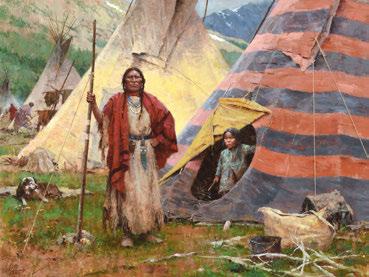
Howard Terpning’s “Lady of the House,” 2006, oil on canvas, 30 by 40 inches, was the winner of the Oklahoma Centennial Award and had been exhibited at the Autry National Center (Los Angeles), the National Cowboy & Western Heritage Museum (Oklahoma City, Okla.) and The Owings Gallery (Santa Fe, N.M.). It sold for $484,000 ($500/700,000).


In July 2022, Coeur d’Alene established the record for Philip R. Goodwin (American, 18811935) at $968,000; while that record still stands, the house set the next-highest price for a work by the artist, realizing $786,500 for “Dangerous Sport.” Following time spent in Glacier National Park and the Canadian Rockies, the artist depicted bear hunts several times, including “A ‘Bear’ Chance” for Nabisco’s Cream of Wheat and “A Strenuous Fight,” which appeared on the December 1924 cover of Outdoor Recreation. In “Dangerous Sport,” which the catalog notes as “none better…filled with unparalleled tension and uncertain-
ty,” the artist captures a grizzly, its mouth open and claws extended, lunging towards a crouching hunter and dog. Formerly published and with two prior auctions in its history, the painting sold to a private collector.
“Embarrassed (Range Pony in Town)” by William R. Leigh scored a second-place finish at $665,500. Previously sold at auction at Parke-Bernet Galleries (1941) and Christie’s New York (2010), the oil on canvas had been handled additionally by Babcock Galleries (New York) and Biltmore Galleries (Scottsdale, Ariz.) and claimed private ownership in Massachusetts, New Jersey, Texas
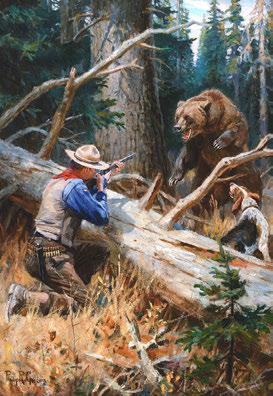
“Dangerous Sport” by Philip R. Goodwin (1881- 1935), oil on canvas, 40 by 28 inches, sold to a private collector for $786,500, the highest price of the day and the secondhighest result for a work by the artist ($250/350,000).

and Wyoming. A private collector in Nebraska had the winning bid.
Coeur d’Alene holds the existing world record ($5.6 million) for Charles Marion Russell (American, 1864-1926) and the July 27 event featured 16 examples — in oil, watercolor and bronze — for collector of the artist to chase. “The Ambush” capped this group with a $605,000 price realized, just beating its high estimate. The auction catalog noted that Russell’s choice to live with Native Americans — the Blackfeet of Canada — allowed him to depict them and scenes of their everyday life sympathetically.

Deborah Butterfield (American, b 1949), “Jane, 1997, bronze, 39 inches high, had been exhibited at the Buffalo Bill Historical Center in Cody, Wyo., from 1995-97; it sold for $145,200 ($80/120,000).


“The Ambush” by Charles M. Russell, oil on canvas, 18½ by 29½ inches, was accompanied by a 1992 bill of sale from the J.N. Bartfield Galleries, New York City. A Santa Fe, N.M., dealer, bidding for a client, took it to $605,000 ($400/600,000).

John Clymer (American, 1907 - 1989) described his “Trader at Pierre’s Hole Rendezvous” as “a popular site and a perfect spot for a rendezvous.” Oil on canvas, 20 by 40 inches, and with exhibition and publication history, it finished at $332,750 ($300/500,000).
The artist’s “Bronc Rider,” a watercolor on paper composition, claimed provenance to the Museum at the Bighorns in Sheridan, Wyo., and leapt past its $150/250,000 estimate, finally settling at $272,250.
Capturing a spiral of movement and demonstrating a mastery of anatomy, action and expression, “The Rattlesnake” quickly became one of the most popular works by Frederic Remington (American, 18611909). Cast at the Roman Bronze Works and numbered “21,” the 24¼-inch-tall model was published in four books on the artist from 1966 to 1996. It achieved $484,000.
The vastness of the American West was perfectly rendered by Western old master Thomas Hill (English American, 18291908) in “On the Banks of the Merced River.” The catalog describes the scene’s “seeming spontaneity, yet (the colors and effects) so beautifully handled that they seem at first to exist in and of themselves, in an impressionistic manner. But as the viewer contemplates the vista, and is drawn into it, the colors and brushstrokes harmonize and blend into a unified whole, evocative and mysterious, like the great Yosemite Valley itself.” Bidders agreed, taking the 1905 oil on canvas to an above-estimate $272,250.
Howard A. Terpning (American, b 1927) is an artist who is familiar to collectors and connoisseurs, and Coeur d’Alene set the record for the artist ($2.36 million) in July 2023. With seven lots by the artist in the sale, bidders had their pick. The latest of these — a brightly colored genre scene titled “Lady

“We had phone and online interest from all over the world on it but it sold to the room for $217,800,” Mike Overby said of “Portrait of a Girl by Nicolai Fechin (Russian-American, 1881 - 1955), oil on canvas, 14 by 10½ inches ($40/60,000).

“Rolling Through the Longhorns” by Oleg Stavrowsky realized $272,250, a new world auction record for the artist. The oil on canvas, 30 by 50 inches, was won by a bidder in the room ($8/12,000).
of the House” from 2006 — had been awarded the Oklahoma Centennial Award at the 2007 Prix de West. The catalog essay for the lot noted the angles in the composition, about which the artist wrote “this Blackfoot woman is definitely the keeper of her domain and proud of it. This painting provided me with the opportunity to portray a strong woman in her own environment. She is fulfilling her role as a member of her Blackfoot Nation by caring for her family and tending to all the hard chores that went with her responsibilities as lady of the house.” The work’s previous exhibition and publication history gave bidders additional reason to pursue it and it closed at $484,000.
“The Blackfeet Wall” by Tom Lovell (American, 1909-1997) is a static composition that nonetheless crackles with the anticipation of dramatic movement. Indeed, the lot essay explains the animosity the Blackfeet felt towards white settlers after two of their hunters were killed in 1806 by members of the Lewis and Clark expedition. Exhibited and illustrated, the 1978 painting achieved $302,500.
The sale saw world auction records set for two artists. Modern New Mexican artist, Dorothy Eugenie Brett’s (English American, 1883-1976) “The Sundown Dance,” was accompanied by a copy of Jamison Gallery’s (New Mexico) exhibition catalog, The Brett: Fifty Years of Painting in New Mexico, 1924 -1974 and rose to $84,700.
Realizing $272,250 and shattering the previous record of $70,000 was Oleg Stavrowsky’s

The top bidder paid $272,250 for “Bronc Rider” by Charles M. Russell, 1922, watercolor on paper, 13½ by 9 inches that had descended in New York and Wyoming collections ($150/250,000).

The only print in the sale was this screenprint on board titled “Teddy Roosevelt” by Andy Warhol (American, 1928 -1987), 36 by 36 inches, from Warhol’s “Cowboys and Indians” series and from an edition of 250. It achieved $229,900 ($30/50,000).
(American, 1927 - 2020) “Rolling Through the Longhorns,” which incited a prolonged bidding war between a phone bidder and collector in the crowd who ended up getting the painting.
Coeur d’Alene Art Auctions’ next sale will be an online-only sale on November 9, followed in March by a two-day live sale in Great Falls, Mont.
Prices quoted include the buyer’s premium as reported by the auction house. For information, www.cdartauction.com or 208772-9009.

The new world auction record for Dorothy Eugenie Brett is now $84,700, realized for her 1967-68 oil on board painting “The Sundown Dance,” which measured 32 by 48 inches ($30/50,000).
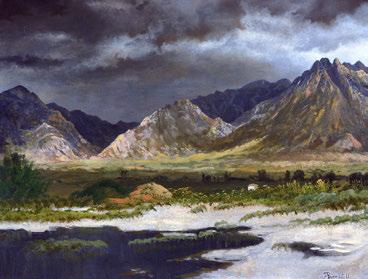
“Rocky Mountain Valley After Rain” was one of six works by Albert Bierstadt (German-American, 1830 -1902) but earned the most: $133,100. Done in oil on paper, it measured 13½ by 18½ inches ($40/60,000).
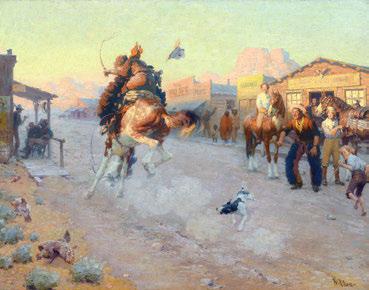

“Venice Fountain” by Emma Ciardi (Italian, 1879-1933), 1912, oil on board, 13 by 16 inches framed, signed and dated “Emma Ciardi Venezia 1912” lower left, flowed to $4,938, almost quintupling its high estimate ($500-$1,000).

With its stained glass floral and leaf motifs and sculpted plant root bronze base, this antique Wilkinson table lamp grew to $1,813 against a $750-$1,250 estimate.

Earning $1,938 was this handmade, one-of-a-kind turtleback stained glass table lamp by Michael Melia, which stood at 21 inches tall. It was in excellent condition ($1/2,000).

This pair of Lalique frosted crystal glass swans, perched on mirror plateaus, flew to $3,688, despite a $500-$1,000 estimate. Each swan measured 9¾ by 11¾ by 6 inches.

This Flemish School painting depicting a hunting scene, oil on canvas, unsigned, 38½ by 53 inches framed, shot to $7,125, making it the second-highest selling lot of the sale ($750-$1,500).

“Walfbanger,” a large bronze sculpture by Amandus Heinrich Adamson (Estonian, 1855-1929), 20-17/20 by 8-3/5 by 11¾ inches, speared down its $1/2,000 estimate to reach $31,563, the highest price of the sale.
Review by Kiersten Busch, Assistant Editor Photos Courtesy The Magnusson Group
Crossing the block for $3,375 was this pair of Lalique Chene oak leaf glass sconces, measuring 11 by 9¾ by 6 inches each. They were “ready to install” ($1/2,000).
MORRISTOWN, N.J. — On July 24, The Magnusson Group conducted its Fine Art To Favrile Summer Auction, which offered 200 lots of fresh-to-market items from three prominent New Jersey estates, including the Rulle estate, the estate of Frederick Kraissl and that of a private New Jersey collector. “It was a really strong result with great prices realized across a range of categories,” said Nathan Buchek, operations director for The Magnusson Group, when asked how the sale did. “Several terrific single-owner collections formed the heart of the sale, and those collections were rich in fresh-to-market artworks, furniture and decorative objects that proved to be desirable in the market.”
With a 92 percent sell-through rate, the sale totaled $149,739. “Generally speaking, most of the buyers of the top 16 lots were geographically near [the firm], including New York, New Jersey, Pennsylvania and DC, but there were buyers from California, Maine and Europe,” reported Buchek.
While the majority of bidders were located in the United States, Buchek also reported registered bidders from around the world, hailing from places such as the European Union, Canada, Asia and the Middle East, among other regions. “There were several bidders in Estonia, which we assume is related to interest in the bronze sculpture by Amandus Heinrich Adamson,” Buchek explained, noting that Adamson was an Estonian artist.
Leading the sale was Adamson’s “Walfbanger,” weighing approximately 35 pounds. The large bronze statue depicted a bearded man with a harpoon and was signed and dated “1898” on the top of its base. “The biggest surprise for our team was the hammer price for the bronze sculpture by Amandus Heinrich Adamson,” reported Buchek, “There are only a handful of previous sales by this artist, so the interest was a pleasant surprise.” It speared down a $31,563 finish, landing at almost 16 times its high estimate of $2,000.
Fine art was especially strong in the sale, with a Flemish School oil on canvas selling for $7,125, the
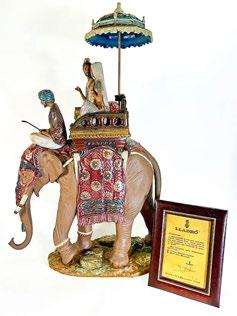
Part of the limited edition “Road to Mandalay” series from Valencia, Spain-based Lladró was “Elefante Real,” a porcelain sculpture made by Vincente Martinez. It came with its original Lladró certificate and was numbered “#648” of 750. The sculpture crossed the block for $2,250, just over estimate ($1/2,000).

second-highest price of the day. It depicted a Flemish hunting scene and appeared unsigned. The painting also had provenance to the Rulle collection. Another figural scene that performed well, earning $4,938, was “Venice Fountain” by Emma Ciardi, the daughter of Italian painter, Guglielmo Ciardi. According to the auction catalog, Ciardi’s “expressive brushwork and sensitive eye for color captured imagined views of a courtly Eighteenth Century Venice and Italy which were particularly well received by English and American patrons.” The oil on board depicted several Italian women of the court near a fountain and was signed “Emma Ciardi Venezia 1912” on the lower lefthand side.
Lalique glass sculptures were also very popular with bidders. A pair of frosted crystal glass swans flocked to $3,688, signed by Lalique and measuring approximately 9¾ inches tall. Both swans came on mirror plateaus. Another pair — this time Chene oak leaf glass sconces with provenance to the Rulle collection — grew to $3,375, surpassing their $2,000 high estimate. The auction catalog noted that the sconces were “ready to install” and in good condition. The highest finish in the lighting category was a one-of-a-kind, handmade turtleback stained glass table lamp designed by Michael Melia (New Jersey, active from 1976). Its shade was made with goldstained square and rectangular glass tiles and had larger rectangular turtleback glass pieces banded around the lower end. With provenance to the Rulle collection, the lamp was in excellent condition and signed “Melia” on the inside of the shade’s rim. In addition, an antique Wilkinson table lamp with a floral stained glass shade and sculpted plant root bronze base sold for $1,813, surpassing its high estimate of $1,250.
The Magnusson Group’s next auction will be its Fall Coin Auction, which will take place in either September or October.
Prices quoted include the buyer’s premium as reported by the auction house. For information, www. themagnussongroup.com or 973-425-1550.
Celebrate the enduring spirit of American craftsmanship at the Bedminster Traditional Artisan Show, which brings together more than 40 of the finest artisans working in traditional Americana and folk art. Meet the artisans and shop for handcrafted treasures, including fraktur, furniture, paintings, quilts, hooked rugs, pottery, baskets, woodcarvings and more. With everything from fine art to folk art, the Bedminster show is one of the top traditional artisan shows in the United States.

The show will take place on Saturday, August 17, from 10 am to 5 pm, and Sunday, August 18, from 11 am to 3 pm. Proceeds from the show will benefit Historic Trappe, a nonprofit organization whose mission is to preserve and share the historic places, landscapes and heritage of southeastern Pennsylvania. The Bedminster Traditional Artisan Show will

be conducted at Perkiomen Valley Middle School East, 5 Tammanund Circle, Collegeville. Show admission includes free

guided tours of Historic Trappe's Center for Pennsylvania German Studies and Muhlenberg House—located
just a mile from the show. For information and a complete list of artisans, www.traditionalartisanshow.com.
WILLIAMSBURG, VA. — Weeks after the Revolutionary War ended by the terms of the 1783 Treaty of Paris, the newly incorporated city of Charleston, S.C., began to pass laws. The population of the city was overwhelmingly African American with more than 8,000 people in the community, and the vast majority of them were enslaved; only about 600 were living there as free citizens. Ever fearful of insurrection, the city’s administration continued to implement policies designed to constrain the lives of all of its African American residents. An ordinance from November 22, 1783, regulated the employment or “hiring out” of skilled and unskilled enslaved workers in which an individual went to work for an entity other than their enslaver, who was paid a fee for the service provided. An annual fee of five to 40 shillings was to be paid to the city by the enslaver for the right of an enslaved person to be hired out, and a badge or ticket was required to be worn by the laborer. While no examples of “slave” badges dating to 1783 are known to exist today, 10 “free” badges from later in the 1780s have been located and are either in private or museum collections. The Colonial Williamsburg Foundation has recently acquired one of these “free” badges; it is now on view in the Lowcountry section of the exhibition, “A Rich and Varied Culture,” in the Nancy N. and Colin G. Campbell Gallery of the DeWitt Wallace Decorative Arts Museum, one of the Art Museums of Colonial Williamsburg.
“It’s an important piece — and an emotional one,” said J. Grahame Long, The Colonial Williamsburg Foundation’s executive director of collections and deputy chief curator. “Obviously, it’s a terrific addition to Colonial Williamsburg’s permanent collection, but it goes much further than that. It’s a critical component in telling America’s whole story.”
The Charleston “hiring out” law did not pertain to enslaved
workers only. It went further to affect the free African American population as well by stating: “… every free negro, mulatto or [mestizo] living or residing within this City, shall be obliged…to register him, her or themselves, in the office of the City Clerk, with the number of their respective families and places of residence … every free negro, mulatto, or mestizo, above the age of 15 years, shall be obliged to obtain a badge from the Corporation of the City, for which badge every such person shall pay into the City Treasury the sum of Five Shillings, and shall wear it suspended by a string or ribband, and exposed to view on his breast.”
Through these dehumanizing requirements, the city of Charleston levied a fee on the right of free people of color to live and work there, which was a stinging irony when considering the root causes of the American Revolution. The penalties for breaking this law were harsh: failure to comply could cause a free person to be fined £3, which if not paid within 10 days could force the person to the workhouse (jail) and work for up to 30 days. Enslaved individuals caught wearing a “free” badge

Charleston “FREE” Badge, engraved by Thomas Albernethie, Charleston, S.C., circa 1787-89, copper. Museum Purchase, The Friends of Colonial Williamsburg Collections Fund and Partial Gift of John Kraljevich, 2024-171.
were subject to whipping, by up to 39 lashes, followed by an hour in the stocks.
“I can’t help but see the parallels between these Eighteenth Century ‘free’ badges and the yellow stars worn by Jews during the Holocaust,” said Erik Goldstein, Colonial Williamsburg’s senior curator of mechanical arts, metals, and numismatics. “Both survive as reminders of horrific ideologies, and how humanity must do better going forward.”
Of the 10 known “free” badges, with one exception, all are made of copper. Their iconography is misleadingly uplifting: they featured the “Phrygian” cap and pole, symbolizing the lofty ideals of liberty since ancient times and were rendered in high relief and emblazoned “FREE.” Each of these badges carries a unique sequential designator as they were intended to be instruments of tracking, control and a revenue source. The badge acquired by Colonial Williamsburg is engraved “No.. U,” and is part of a succession, possibly limited to 26 or fewer badges with letters instead of numbers. To date, the only other badge inscribed with a letter is “No.. X,” and the other eight examples are numbered between 14 and 341.
Research conducted by Goldstein at Colonial Williamsburg reveals new insights into how these badges were made. What further unites badges “U” and “X” are the copper pieces, or planchets, that they were struck on. Both exhibit portions of text engraved in retrograde or “mirror image” on their backs, showing that they had previously been part of a printing plate relating to money. Once reversed, the readable portions contain words like “PENCE,” “TREASURY,” “DEPOSIT” and “RENTS.” This detail offers a surprising clue to their numismatic origin; the only paper currency circulating in South Carolina in the 1780s that carried these specific terms were the City of Charleston’s emissions of July 12 and October 20, 1786, only current until July 21, 1788.
It can therefore be said with certainty that the badges “U” and “X” were made of copper recycled from the out-of-date printing plates for these two issues. As of mid-2024, unique examples of only the “Two Pence” and the “Five Shillings & Three Pence” bills from the 1786 issues of Charleston’s paper money have been recorded. Given that the text engraved on the reverses of badges “U” and “X” match neither, they were for the printing of bills of unknown denominations that are not known to survive.
“The fact that two of the ‘free’ badges were made from reused copper printing plates is an exciting discovery, since few printing plates from Eighteenth Century American currency issues survive, in any form. But it also makes sense, using governmentally owned material for an official purpose,” said Goldstein.
A law passed on June 16, 1789, eliminated both of Charleston’s badge programs for African Americans. When the city reimplemented a significantly enlarged system of regulation in 1800, it required the purchase and wearing of badges for enslaved people only. Between then and the end of the Civil War in 1865, more than 187,000 “slave badges” were made, sold and worn by Charleston’s “hired
out” enslaved workers. Though “FREE” badges were never again mandated by the city, the poor condition of some of the surviving examples suggests they may have been worn well past their obsolescence. It is speculated that their owners sought to display their status as dignified, free individuals in an open and proud manner for all to see. For more information, www. colonialwilliamsburg.org, 855296-6627 or by following Colonial Williamsburg on Facebook and @colonialwmsburg on Twitter and Instagram.



and
By Justin W. thomas NEWBURYPORT, MASS. —
The Western New York region produced some of the most skilled and dramatic glazed red earthenware made anywhere in the United States in the Nineteenth Century. Preceding the opening of the Erie Canal in 1825 — when the port cities of Rochester and Buffalo allowed for greater distribution of not only potted red earthenwares but also the cobalt-decorated stonewares that were also produced in Ontario County, N.Y. — it was the period from 1825 through the 1860s that saw the most production of red earthenware pottery. Outside of Newstead, Mill Grove, West Seneca and Aurora, N.Y., which had potteries in operation for extended periods of time either in multigenerational families or unrelated owners, little is known about other red earthenware potters in Erie County. These include Collins and Colden, which had red earthenware businesses and which little is known today.
Collins, N.Y., located about 35 miles south of Buffalo, N.Y., is the southernmost town in Erie County. The first settlers who came to this area in the early 1800s were primarily English Quakers from New England; the second wave of settlers



“Sherman + Graham” listed as manufacturers in the Coldon, Erie County, N.Y., 1850 Federal Census as producing 50,000 pieces of earthenware annually from 25 tons of clay and 1,200 pounds of lead.

arrived from Germany, beginning in 1830. Originally called Concord, Collins was formed on March 16, 1821, when it was named after the Collins family, local dairy farmers. The town lost land to create Brant, in 1839, and North Collins, in 1852, which were both formed partially due to the large concentration of dairy farms that the area once contained. By the 1850s, there were 10 cheese and milk factories in the town. Cattaraugus Creek also ran through the area, which was vital to the settlers, as they used it as a means of transportation and trade; with it they were able to reach Lake Erie, as well as other destinations.
Dairy production was among the industries that often went hand-in-hand with utilitarian red earthenware production in the Northeastern United States. For example, red earthenware milk pans were some of the most commonly produced forms made by country potters surrounded by farming and dairy communities in the Eighteenth and Nineteenth Century.
Little is known about red earthenware production in Collins in the Nineteenth Century.
The only record of a potter in Collins appears in the 1850 US Federal Census and is a 24-year-old man named George Graham, who lived there with his 24-year-old wife Lydia and two young children. He may be the same George Graham who made an important Nineteenth Century large red earthenware jug that is inscribed on the base “George B. Graham Maker, Ont. Co. New York.” The jug is also impressed four times with the maker’s mark of Alvin Wilcox (1801-1862), an important red earthenware potter in West Bloomfield, Ontario County, N.Y. The use of four strikes may suggest it was a four-gallon example.
This jug is in the personal collection of New York archaeologist and museum specialist, George R. Hamell. Hamell is responsible for the majority of the archaeology from potter’s sites in Western New York, which is now stored at the Rochester Museum & Science Center in Rochester, N.Y. Hamell once owned one of the most impressive collections of New York red earthenware ever assembled by a private owner, most of which is now either in the collection of the Rochester Museum or was sold years ago by New York City ceramic specialists Garrison and Diana Stradling, and more recently, by Crocker Farm in Sparks, Md., on March 5, 2011. This jug is the only piece of redware still in his collection.
It is important to the history of red earthenware production in Western New York and has always been one of Hamell’s prized objects. It has been cited in publication just once — when William C. Ketchum Jr., briefly described it in text in his book, Potters and Potteries of New York State, 1650-1900: Second Edition (1987); an illustration of it has never been previously published.
The marks on this jug suggest that Graham may have been an apprentice at Wilcox’s business in the 1840s, where he proved his skill on the potter’s wheel. Similar to other potters throughout the United States, Graham may have desired to own his own pottery business and the booming dairy industry in Collins presented an ideal location for a red earthenware company. The growing population in Buffalo in the mid-1800s may have also been an appealing factor; in 1840 there were 18,213 people living in Buffalo, while that number jumped to 74,214 by 1855.
According to the US Federal Census in 1850, there was a group of potters employed in West Bloomfield, N.Y., which was a destination for some potters who had moved there from Germany and New England to seek employment or to work at Wilcox’s newly-established tile factory. While some potters’ names are better known today than others, those in West Bloomfield include Edwin Prosser, George Prosser, Jefferson Hans, Edward Hans, Jacob Backenston, John Backenston, Fred Backenston, Alvin Wilcox, Ava Hulburt, Marvin Smith, James Ellsworth and John Jerorn. This list may be incomplete as some listed their primary occupation in census records as “farmer,” rather than “potter;” it is likely many supplemented their yearly income as a farmer with producing pottery.
While George Graham does not appear in later census records on his own, he may be the one mentioned in a partnership in the 1850 census for Colden, Erie County, N.Y., as “Sherman + Graham.” Manufacturers of utilitarian pottery, the firm produced 50,000 pieces of earthenware annually from 25 tons of clay and 1,200 pounds of lead about 20 miles away from Collins. Scholarship on this potter is virtually nonexistent outside of the census records.
Sherman may be John Sherman (circa 1797–1888), who was born in Rhode Island but was involved in various business ventures and partnerships in Erie County, N.Y., through the 1860s. According to H. Perry Smith’s (ed) History of the City of Buffalo and Erie County, with Illustrations and Biographical Sketches of Some of Its Prominent Men and Pioneers (1884), Sherman established a store in North Collins with his brother in 1829. He is listed in the 1830 census as a resident in Collins; by 1850, he is listed as a “merchant” in Collins; by 1860, a “merchant and farmer” in North Collins; and in 1870, the census lists him as a “retired merchant” in North Collins.
The scholarship on red earthenware production in Western New York it is a subject that deserves more attention today, not only identifying the potters and their production, but also taking into account the influx of people relocating from elsewhere in the United States and migrating from other countries.
EASTON, MD. — The July 25-26 auction at Guyette & Deeter featured the second part of the Alan and Elaine Haid collection of decoys, along with decoys and folk art from the Gene and Linda Kangas collection and Oscar Peterson carvings from the Dave Fannon collection. There were numerous carvings by Elmer Crowell, the Ward Brothers, Gus Wilson, Joe Lincoln and many others, as well as contemporary carvings and Mason Factory decoys. Shorebirds, sinkbox decoys and cigar store trade figures were also included. The indexed 367page catalog had dozens of biographies of carvers, as well as information on the collectors and stories behind duck hunting; much of which was not
available in the online catalog.
Six decoys each sold for more than $100,000, while more than 85 others achieved prices exceeding $10,000. The sale grossed more than $4.9 million with the highest-priced lot, a black duck by Elmer Crowell, selling for $258,000. A world record price of $66,000 was achieved for an elaborately carved storage box made by Frank Finney. Decoy specialist and folk art dealer, Russ Goldberger commented on the sale, saying, “It certainly demonstrated the strength of the market with a lot of new collectors entering the market. With the decoy sale earlier this month (covered in the August 2 issue of Antiques and The Arts Weekly), there have been close to $7 million worth of decoys sold in the month of July.

Gene and Linda Kangas approached decoys as folk art and wrote numerous books and articles on them. Several of the very “folky” decoys in this sale were from their collections and more will be offered in upcoming sales.
Review by
Rick Russack, Contributing Editor
Photos Courtesy Guyette & Deeter

That says something.”
There were between 150 and 200 people at the preview party the evening before the sale and more than 100 were in the gallery as the auction began the following day. Many stayed the whole day and were active bidders. Two food trucks onsite provided complimentary lunch for those in attendance.
The late Alan and Elaine Haid started collecting together in 1967. Their aim was to acquire the rarest and finest examples of waterfowl decoys they could find.
Alan Haid wrote two books on decoys, Decoys of the Mississippi Flyway (Schiffer Publishing Limited) in 1981 and, in 1993, he coauthored with Russ Goldberger, Mason Decoys: A Complete Pictorial Guide (Decoy Maga-

These three shorebird decoys were made by the Mason Decoy Factory (Detroit, Mich.). The large special-order curlew on the right earned $63,000, the wooden billed snipe on the left achieved $45,000 and the split tail ruddy turnstone with glass eyes realized $8,100.

This great blue heron with relief wing carving, carved eyes and extended head feathers measured 33 inches long and had an original painted surface that was worn down to bare wood. From the Kangas collection, it was one of several decoys made by Gus Wilson and brought $33,000 from a
zine); an updated edition was published in 2014. Guyette & Deeter sold 60 lots and the first part of the Haid collection, in the firm’s April 2024 auction, which totaled $3.8 million.
Gene and Linda Kangas began researching and writing about decoys in 1969, authoring more than 200 essays and five reference books on the subject. According to Jon Deeter, the Kangases “regarded decoys as folk art and were often more interested in form than paint. Their collection includes many
other pieces of folk art, several of which are in this sale, and we’ll be including more items from their collections in upcoming sales.”
Dave Fannon’s collection of Oscar Peterson objects are the result of a three-decade pursuit of his finest fish plaques, vases and decoys. Many of the pieces had never been offered before at public auction. It wasn’t a surprise that five of the six highest priced items in the sale were achieved by decoys from the Haid collection. The 55
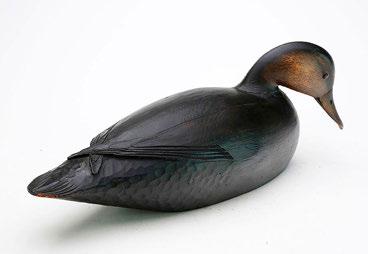
Finishing at $258,000 and leading the sale was this feeding black duck by Elmer Crowell, his only known example with a down-turned head. Of additional interest were its carved wing-tips and chip carving on the breast and tail.
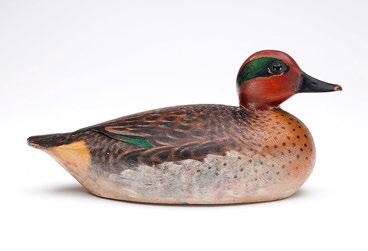
This green wing teal drake by Elmer Crowell, from the Haid collection, had been published in four books and brought $168,000. It had relief carved, crossed wing-tips and tail feathers.
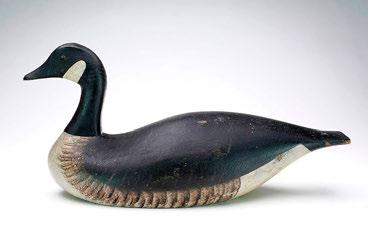
off to a
and

This exceptionally carved wooden eagle had a 49-inch-wide wingspan and stood 32 inches tall. The auction catalog speculated that it might have been made in Boston in the early Nineteenth Century. It flew to $25,200.

of
$120,000, its high estimate.

Phone lines were active when this Charles Birch (Virginia, 1867-1956) working swan decoy from the Haid collection was offered. One of those bidders won it for $108,000.



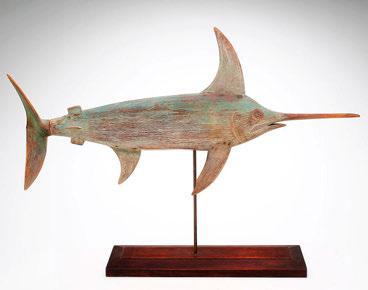
swordfish


The catalog entry for this lot read “The only known ‘Page’ cigar store tobacconist trade figure in zinc by William DeMuth.” Cast in Brooklyn, it stood 72 inches tall and sold for $30,000.
lots in this sale realized a total of $2,184,000. The printed catalog devoted 106 pages to their collection, and the firm’s website included a video of the couple discussing their collection.
Three of the six Haid collection decoys that exceeded $100,000 were made by Cape Cod carver Elmer Crowell (1862-1951), including the sale’s top lot. A phone bidder paid $258,000 for his feeding black duck with a slightly turned head in a downward looking pose. The catalog stated that this may be the only one known with its head in this position. The duck had relief feather carvings on the raised wing-tips and tail feathers along with time-consuming chip carvings on the breast and tail area.
The second-highest price of the sale was a green wing teal drake by Crowell that earned $168,000. It had a slightly turned head and relief-carved crossed wingtips and tail feathers. One of Crowell’s shore birds, a yellowlegs in a feeding pose with relief carved primary feathers, earned $105,000.
A red-breasted merganser, made by Captain Edwin Bachman (Nova Scotia, 1872-1917), that was found in a Nova Scotia home brought $156,000. This decoy was unusual in that it had carved eyes and an oversized carved crest. Most often, crests are carved separately and inserted into the head; in this instance, the head and crest were carved from one piece of wood. The remaining two six-figure lots from the Haid collection were a rare pair of mallards, showing the hen in a preening pose. The pair was made by Illinois carver Charles Perdew (1874-1963), painted by his wife, Edna, and brought $120,000. An outstanding hollow-carved working swan decoy, made by Charles Birch (1867-1956) of Willis Wharf, Va., brought $108,000.
A special-order curlew topped selections made by the Mason Decoy Factory. It had been modeled after curlews carved by William Bowman on Long Island, showing deep relief-carved wings and raised wing-tips. It sold for $63,000. Working decoys by other


The Fannon collection included two carved vases by Oscar Peterson. This one depicted five species of fish and sold for $24,000. An early carved butcher’s shop trade sign in the shape of a bull’s head sold for $33,000. It was 35 inches wide and had applied ears, carved eyes and real steer horns.
well-known masters of the craft were in abundance and also did well. A turned-head mallard hen by Illinois carver Robert Elliston (1847-1925) realized $90,000. The same price was achieved for a rigmate pair of red-breasted mergansers with slightly turned heads by George Boyd (18731941), who is considered by many to be New Hampshire’s premier decoy maker. The pair had provenance to the Bert and Nina Flectcher Little collection.
One of New Jersey’s premier carvers was Harry Shourds (1861-1920); his rare, red-breasted merganser drake — hollow carved with tack eyes and extended crest feathers — earned $75,000. The Cobb family of Cobb Island produced some of the finest carvings in Virginia. A swimming brant with raised wing-tip carving by Nathan Cobb Jr (1825-1905) brought $66,000. Obediah Verity (18131901) produced some of Long Island’s finest shorebird decoys. His large curlew with deep relief wing carving and carved eyes sold for $63,000. All of these mentioned were from Alan and Elaine Haid, illustrating the breadth of their collection.
Carvings by contemporary craftsmen have a large and growing following. The sale included several decorative carvings by Mark McNair of Crooksville, Va. Born in 1950, McNair is the only living carver whose works are included in the collection of the Shelburne Museum (Shelburne, Vt.). The highest spent for one of McNair’s carvings was $14,400 on an unusual weathervane he’d made in 2012. It took the form of a 32-inch-long swordfish, signed and dated, with relief gill, eye carving and a tail that revolved in the wind. A 24-inch-long hollow-carved Canada goose — with a slightly turned head and relief carved wing-tips — sold for $4,500. A merganser with relief carved wing-tips and an extended crest made $3,900. Of the eight brants made by Jim Schmiedlin (19452015), only one earned $15,000. A carved sculpture titled “Early Morning Glory” depicted a pair of flying ruby-throated hummingbirds approaching morning glory flowers. Signed and dated “2010,” it had been made by Steve Weaver (b 1950) and went out for $9,600. There were also several carvings by contemporary folk artist Frank Finney (b 1947). Painted in Finney’s distinctive colors, an


The head of this merganser is turned and carved from a branch or root. It was done by Roger Williams (1784-1851), Long Island, N.Y., and sold for $9,600. Adele Earnest, referring to it in her book, Art of the Decoy, (Bramhall House, 1965) said, “The oldest decoy I own is a Long Island root head dating from the late Eighteenth Century.”

Oscar Peterson often traded his carvings for drinks at local taverns. While it isn’t known who made this 48-inch doublesided pike trade sign from the Haid collection, bidders chased it to $42,000.
imaginative storage box highlighting a family of frogs canoeing on a pond sold for $66,000; this set the new world auction record for a carving by him. Bringing $21,600 was a life-size bobcat with a full-size quail in its mouth. The quail was painted with individual feather carvings and was removable from the bobcat’s mouth. For those with a smaller budget, miniature bird carvings by Finney could be taken home for less than $600.
From Crisfield, Md., and the Ward Brothers was a circa 1930 pinch-breast pintail hen with a raised and slightly turned head that flew to $69,000. It had provenance to the collection of James and Lyda Madden, as well as a 1982 auction with Richard Bourne.
Among the Oscar Peterson (1887-1951) fish carvings and decoys from the Fannon collection, two vases — heavily carved with fish — were the most popular with bidders. A 9½-inch-tall
example depicted five species of fish and earned $24,000. Bringing the same price was a slightly smaller vase carved with a muskie. Peterson’s ice fishing decoys ranged in price from $840 to $8,400; the latter made on an 11-inch walleye with unpainted copper fins.
There were about 40 items from the Gene and Linda Kangas collections that reflected their interest in folk art. A preening surf scoter made by Gus Wilson (1864-1950), had reliefcarved wings and minor gunning wear; it earned $28,800. Wilson’s great blue heron decoy, from another collection, was also folky and had an old, weathered surface; it flew to $33,000.
After the sale, Jon Deeter said, simply, “What’s there to say? It was a great sale.”
Prices quoted include the buyer’s premium as reported by the auction house. For information, 410-745-0485 or www.guyetteanddeeter.com.

These penguins, sold separately, were made by Charles Hart, Gloucester, Mass. (1862-1960). From the left: a 10-inch penguin ($2,100), a 7½-inch penguin ($2,100), a 7-inch Adele penguin ($2,400), a 7-inch example ($2,400) and a 6½-inch one ($1,620). The small pair, made as paperweights, achieved $1,500.

Of the more than 30 examples of sporting art in the sale, Ogden Pleissner’s watercolor of a salmon fishing scene brought the highest price: $57,000.

This full-body copper weathervane of a rockfish or striped bass, dating to the early Twentieth Century and 36 inches in length, was bought by a veteran folk art dealer for $60,000.
SUDBURY, MASS. — On July 28, Tremont Auctions conducted its Designer Fashion & Couture auction, offering 225 lots from a single-owner collection of fine couture, jewelry and accessories, including handbags, shoes, clothing and scarves. Most of the lots were unworn and many included their original boxes.
“We were very happy with the auction, considering what it was,” reported Cameron Ayotte, auction manager at Tremont, when
Antiques and The Arts Weekly caught up with him after the sale. “Any time we can have over a $1,000 average lot value is a good sign.” With a 97 percent sellthrough rate, the auction totaled $256,828. While Ayotte did not report any specific demographics for the buying pool, he did note that most of the lots were purchased by domestic buyers.
Leading the sale was a set of three Louis Vuitton cruiser bags in the signature monogram pat-
tern. The bags, in sizes 50, 55 and 60, were able to fit one inside the other, and came with their original locks and keys. Both the largest of the trio, measuring 19 inches wide and 14 inches high, and the smallest came with a dust bag. All three were in never used condition. Despite some staining on the leather trim of the largest bag, bidders still pushed the trio to $6,985, surpassing their high estimate.
Also in the signature Louis

Leading the sale at $6,985 was a set of three Louis Vuitton cruiser bags which fit neatly into one another. In the signature Louis Vuitton monogram pattern, the trio came with locks and keys and were in never used condition ($3/5,000).

Adorned in the classic Louis Vuitton monogram pattern, this carry tote and pochette case earned $2,286, surpassing their $800-$1,200 estimate.

to $2,413, almost
estimate,
Vuitton monogram pattern were a carry tote and pochette case, which earned $2,286. The carry tote had one exterior and interior zippered pocket, as well as two additional open pockets in the suede interior. Its two leather handles measured 10 inches high at their center. The pochette case contained a cloth interior and included an attachable strap. Both pieces were in neverused condition.
Other Louis Vuitton offerings included a papillon trunk leather handbag, created in collaboration with Japanese artist Takashi Murakami. The classic monogram pattern on the bag also included smiling pink cherry blossom flowers, Murakami’s trademark design. The studded leather-trimmed purse retained its original stuffing paper and came with an attached hanging key case and keys. Surpassing its $2,500 high estimate, the
bag bloomed to $3,810. Bags, shoes and other accessories from Chanel made up almost one quarter of the lots offered from the collection. An assortment of leather quilted handbags were popular with bidders, with prices ranging from $1,905 to almost $5,000. The highest-price realized was for a classic leather quilted handbag in the camel color, which crossed the block for $4,826. The purse was adorned with the iconic “CC” logo clasp and had an attached single chain link strap. Included with the lot were the bag’s black dust bag, original stuffing paper and certificate of authenticity card. A Chanel python snakeskin clutch in deep gray attracted bidders and sold for four times its high estimate. Labeled in the auction catalog as “exotic” and “sensual,” the purse was fastened with the traditional “CC” clasp and could be worn as a clutch or

Achieving almost seven times their high estimate was this large lot of 15 pairs of ladies’ leather and suede gloves, which fit just right at $2,032. The gloves, most in neverworn condition, came from various makers, including Ferragamo, Fendi and Capretto ($200/300).

The second-highest selling lot of the sale was this 22K gold and sapphire Gurhan necklace, which weighed approximately 71.4 grams. Both the clasp and the back of one link were marked with the Gurhan logo. Earning $6,350, it just surpassed its high estimate ($4/6,000).
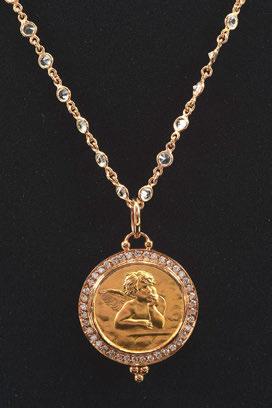
This 18K gold and diamond Temple St Clair pendant necklace was set with white sapphire or topaz stones and contained a Temple St Clair charm and hallmarks. The 18-inch-long necklace sparkled at $5,842 ($2/3,000).

This 18K gold and heavy diamond Roberto Coin bracelet finished at $5,856, the thirdhighest price of the sale. The 90.7 gram white and yellow gold bracelet had a woven design and a ruby mounted clasp ($3/5,000).

Blossoming to $3,810 was this Louis Vuitton papillon trunk leather handbag created in collaboration with Takashi Murakami (Japanese, b 1962) ($2/2,500).
an over-the-shoulder bag by using the included chain-link strap. It came with a certificate of authenticity and a small, sealed Chanel envelope. The 10½-inchlong purse slithered to $4,064. Also popular with bidders was the assortment of Chanel shoes offered. The highest price to cross the block, $2,413, belonged to a set of two pairs of Chanel Mary Jane flats in their original boxes, with dust bags. One pair was a

This Roberto Coin 18K gold and diamond chain link bracelet with a lock finished at $2,618. The 29.2-gram bracelet was marked with hallmarks and “18K,” and had a white gold and diamond encrusted clasp ($2/3,000).

A 22K gold, sapphire and semi-precious stone bracelet was part of a matching set with the Gurhan necklace. It was fastened with cabochon sapphires and other blue stones of varying sizes and sold for $3,556 ($2,5/3,500).
pale pink lambskin, and the other was light beige textured leather. Both never-worn pairs were size 39 and had black leather toes, a quintessential design choice for Chanel Mary Janes.
Leading the jewelry category was a Gurhan necklace made with 22K gold and sapphires. The 17½-inch long necklace consisted of smooth surface sapphires, together with additional semiprecious blue stones. The central
FLA. — The Galloway’s Furniture Showroom of Sarasota opened in 1959. The building was designed by Victor Lundy, an architectural innovator and central figure of the Sarasota School of Architecture — a regional movement that adapted modernist principles to the geography, climate and socio-cultural context of South Florida’s Gulf Coast. A twostory, highly transparent glass cylinder with exposed wood “morning glory” structure and suspended mezzanine, Galloway’s became an instant local landmark. A 1980s renovation concealed the original structure, windows and much of the original materials and details.
This exhibition uncovers this modernist masterpiece by first exploring the building’s architectural and cultural significance in the context of the Sarasota School of Architecture and the pioneering work of Victor Lundy.
The physical and digital analysis examines the building’s wood-laminated structure and extant architectural
features. The exhibition concludes with design concepts for rehabilitating, expanding and adaptively using the former Galloway’s structure prepared by architecture students from Hampton University — a project of the Hub. Architecture Sarasota’s Hub initiative supports innovative design that helps transform places and inspire lives.
The exhibition is organized by Sarasota Art Museum of Ringling College of Art and Design and curated by Marty Hylton, president, Architecture Sarasota; Dr. Sujin Kim, assistant professor of architecture, Hampton University in Hampton, Virginia; and Damien Blumetti, founding principal, Damien Blumetti Architect.
“Modern Masterpiece Uncovered: Galloway’s Furniture Showroom by Victor Lundy” will be on view at the Sarasota Art Museum until October 27.
The Sarasota Art Museum is at 1001 South Tamiami Trail. For information, 941-309-4300 or www.sarasotamuseum.org.
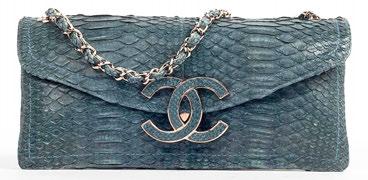
Listed as “exotic” and “sensual” in the auction catalog, this Chanel python snakeskin clutch purse, 10½ inches wide and 5½ inches high, went for $4,064, four times its high estimate ($800-$1,000).

This camel-colored classic quilted leather Chanel handbag, 10 inches wide and 5 inches high, earned the highest price for a bag from the fashion house, at $4,826 ($2/3,000).
sapphire did not appear bigger than the others but was instead marked by the tiny diamonds that surrounded it. The necklace realized $6,350, the second-highest price of the sale. Its matching 22K gold bracelet and earrings sold as separate lots, earning $3,556 and $762 respectively. According to Ayotte, the set will stay complete as, “all three pieces sold to the same buyer.”
Rounding out the top three lots
of the sale was a Roberto Coin 18K gold and heavy diamond bracelet, which sold for $5,856, surpassing its $5,000 high estimate. The bracelet had a white and yellow gold woven design with diamond-encrusted caps. The clasp, which also contained diamonds and was mounted with a ruby, was marked “Roberto Coin.” The backside of the jewelry piece had hallmark symbols “18K” and “Italy,” and fea-
tured a hidden ruby in an openwork design. Tremont’s next auction will take place on September 8. The sale will offer art, antiques, jewelry, silver and a large collection of signed and antique books and historical documents.
Prices quoted include the buyer’s premium as reported by the auction house. For information, 617-795-1678 or www. tremontauctions.com.

EDINBURGH — Indulge your wanderlust with “An Irish Impressionist: Lavery on Location,” at the National Galleries of Scotland’s summer exhibition at the Royal Scottish Academy in Edinburgh, running through October 27. Dip your toes in the sun, sea and society of the late Nineteenth and early Twentieth Centuries, viewed through the works of renowned Glasgow Boy, Sir John Lavery (Irish, 1856-1941).
Take a trip through the extraordinary life of the Belfast-born artist, from Scotland to New York via Paris and Morocco. Lavery never traveled without his painting kit, and the exhibition explores some of the key locations shown in his art. See sumptuous portraits, impressionistic landscapes and idyllic scenes of leisure against a backdrop of Tangier, St Jean de Luz, Palm Springs and the Venice Lido. Be whisked away to Switzerland, Spain, Ireland and Italy, as well as to cities such as Glasgow, Seville, Monte Carlo and New York. From the highly finished to the swift impressionist sketch and a uniquely personal style, the range of subjects on show is staggering.
Move through the exhibition to experience the glamour of a lost era, with visits to the races, tennis matches and the golf course or simply relaxing on warm days with Lavery’s family and friends. With 90 magnificent artworks to explore, “Lavery on Location” brings together an array of his most notable paintings along with many works from private collections not usually seen by the public. You will be able to discover nearly 20 paintings exclusively on display in Edinburgh. Immerse yourself in beautiful seascapes of Tangier from the Ulster Museum, as well as spectacular portraits such as “Idonia in Morocco” from Glasgow Museums and “Hazel in Black and Gold” from the Laing Art Gallery.
Themed rooms allow visitors to immerse themselves in Lavery’s oil sketches for the Glasgow International Exhibition of 1888, where he had his big break and was commissioned to paint the State Visit of Her Majesty, Queen Victoria. Then visitors can journey through Lavery’s travels in North Africa, with mesmerizing paintings of snake charmers and camps on his adventures to Fez. For more than 20 years, his villa in Tangier, surrounded by beautiful gardens, would become a winter retreat. Then experience Lavery’s time as an Official War Artist with scenes in hospitals, submarine pens and air raids during World War I. Lavery’s constant devotion to recording everyday life allows us to step inside a bygone era, capturing leisure activities such as sport, sunbathing and sight-seeing with the artist’s friends and family.
Born in Belfast, where his father ran a small wine and spirits shop in North Queen Street, Lavery was

orphaned at the age of three, and moved to his uncle’s farm at Moira before being sent as a ten-year-old to a distant relative in Saltcoats, Ayrshire. He first ran away to Glasgow at the age of 15, and went on to take early morning and evening drawing lessons at the Haldane Academy, completing his training at the Académie Julian in Paris.
Along with a number of his fellow Scottish students, Lavery worked at the colony of Grez-sur-Loing, near Fontainebleau, which is the focus of the first room of the exhibition. Then, back in Scotland in 1885 he became one of the leaders of the much-loved group of artists known as the Glasgow Boys. The Glasgow Boys rebelled against the stuffy Edinburgh-based art establishment and challenged the Academy’s emphasis on historical painting. Instead, their subjects were drawn from everyday life, often painted outdoors. Lavery quickly attained an international reputation in his early 30s when he received a gold medal at the Paris Salon, the most prestigious art exhibition in the world at the time. Enjoying great success after his

move to London in 1896, Lavery combined his talents as a portrait painter with an interest in contemporary events and was later knighted in 1918.
Having traveled a great deal, always with his easel, Lavery recorded everything — from daylight raids on London during the First World War to tennis parties in the South of France. But despite his travels worldwide, Lavery’s connections to Scotland and Ireland remained strong throughout his long career.
Senior curator professor Frances Fowle said, ‘Lavery was a versatile painter who was equally at home in Scotland, North Africa and the French Riviera. His paintings offer, on the one hand, a nostalgic glimpse of a bygone era and, on the other, a modern world of sunshine and leisure. Technically he was a true Impressionist, intent on capturing a particular moment or atmospheric effect — perhaps night falling on Tangier, or early morning light, dancing on the crest of a wave.”
Guest curator Kenneth McConkey said, “In a career that spanned more than 60 years, Lavery’s output was immense. He saw carthorses become ‘horse-power,’ windjammers transform into steamers and flying machines reborn as air liners. Against a backdrop of immense social and political change, in the land of his birth, he witnessed the first cracks in the British Imperial entablature. Visual reporting skills, perfected in Scotland, took him to extraordinary situations and while his works develop in fascinating ways, their basic premises — setting down what was before him — remained constant. The same remarkable hand that brought us a Dutch Cocoa House in 1888 takes us to a tea-table in Palm Springs in 1938.”
Director of the National Gallery of Ireland, Dr Caroline Campbell said, “I am thrilled to see ‘An Irish Impressionist: Lavery on Location’ opening at the National Galleries of Scotland. This exhibition is a perfect partnership between the National Gallery of Ireland, National Galleries of Scotland and the Ulster Museum. It demonstrates the strength of our collections, our relationship and our commitment to working together. John Lavery was born in Belfast, spent his formative years in Ayrshire and Glasgow, was a regular visitor to Dublin and spent his final years in Kilkenny, Ireland. This wonderful exhibition focuses on the people, locations and sensations that John Lavery encountered in a life rich in travel and experience and shows a new dimension to the work of this much-loved painter.”
This exhibition is organized by the National Gallery of Ireland, Dublin, in collaboration with National Museums NI and the National Galleries of Scotland.
The Royal Scottish Academy is at The Mound and Princes Street. For information, www.nationalgalleries.org.
NICOSIA, CYPRUS (AP) — Cyprus on Monday, July 22, put on display artifacts — some of them thousands of years old — that were returned after a Turkish art dealer looted them from the ethnically divided island nation decades ago.
Aydin Dikmen took the artifacts from the country’s breakaway north in the years after Cyprus’ split in 1974, when Turkey invaded following a coup mounted by supporters of union with Greece. The antiquities were kept in Germany after authorities there seized them in 1997, and protracted legal battles secured their repatriation in three batches, the last one this year.
Addressing the unveiling ceremony at Cyprus’ archaeological museum, President Nikos Christodoulides said the destruction of a country’s cultural heritage as evidenced in recent conflicts becomes a “deliberate campaign of cultural and religious cleansing that aims to eliminate identity.”
Among the 60 most recently returned artifacts put on display include jewelry from the Chalcolithic Period between 3500-1500 BCE and Bronze Age bird-shaped idols. Antiquities that Dikmen also looted but were returned years ago include 1,500-year-old mosaics of Saints Luke, Mark, Matthew and James. They are among the few examples of early Christian works to survive the Iconoclastic period in the Eighth and Ninth Centuries when most such works were destroyed.
Cyprus’ authorities and the country’s Orthodox Church for decades have been hunting for the island’s looted antiquities and centuriesold relics from as many as 500 churches in open auctions and on the black market.
The museum’s antiquities curator, Eftychia Zachariou, told the ceremony that Cyprus in recent years has benefited from a shift in thinking among authorities in many countries who now opt to repatriate antiquities of dubious provenance.
By Silvia Stellacci & leila el ZaBri
ROME (AP) — The daughter of the late Colombian artist Fernando Botero has helped to turn the streets and piazzas of the Italian capital into an open-air museum to display eight of her father’s famously voluminous, whimsical sculptures.
The exhibition was organized as a tribute to Botero, who died September 15, 2023, at 91 in Monaco, where he kept a studio. The artist also lived for many years in the Italian town of Pietrasanta in the Tuscany region, where he was buried next to his third wife, the artist Sophia Vari.
“I am sure my father would be very moved because Italy was always like a second home coun-
try for him,’’ his daughter, Lina Botero, told private Italian television TV2000.
Botero created all of the statues shown in the exhibition while he was in Italy. His affection for Italy came in part from his artistic affinity for the Renaissance masters.
While his imposing bronze sculptures have been shown in parks and avenues of many European and Latin American capitals, this is the first time they are being seen on this scale in Rome. The exhibition closes October 1.
Art lovers can follow a Botero trail starting from the central Villa Borghese park, where Lying Woman gazes across Rome’s rooftops toward St Peter’s Basilica from the Pincio Terrace.
In the Piazza del Popolo, the sculptures Adam and Eve face each other. Horse with Bridle is on the central Roman shopping street, the Via del Corso, and the journey ends near the Piazza di Spagna with Seated Woman.
“We could tell from afar those are Boteros,” said Sara Belloni, a resident who paused to photograph “Adam and Eve” from below. “The aesthetic is completely the opposite compared to what one usually sees around. Where skinny is beautiful, he does the exact opposite.”
Lorenzo Zichichi, who represents one of the exhibition’s coorganizers, said it would be a mistake to call the sculptures fat.
“Botero has always said that he has never painted a fat woman

Botero’s “Sleeping Venus” sculpture, installed in Rome’s Pincio Terrace, Friday, July 19, 2024, appears to be in front of St Peter’s Basillica at The Vatican. Rome’s storied streets and piazzas have become a vibrant canvas for Fernando Botero’s exuberant sculptures, turning the city into an open-air museum of voluminous forms and daring artisty (AP Photo/Gregorio Borgia).
and he has never sculpted a fat woman,” said Zichichi, president of the Il Cigno publishing house, which presented the exhibition
along with the Fernando Botero Foundation and BAM art events.
“What fascinated him was the volume.”
By Brian Melley & Hilary Fox
LONDON (AP) — Taylor Swift fans who missed her world tour or those who can’t get enough of her can catch her at the museum this summer.
As a celebration of her double run of sold-out shows in London on her Eras Tour, real items from Swift’s different musical eras have been integrated into galleries at the Victoria and Albert Museum in London.
Costumes, guitars and other memorabilia from the pop star’s archive have been curated into a “Songbook Trail” that opened Saturday, July 27, and runs through September 8.
“There’s so many really iconic objects and looks worn by Taylor across her career from her breakout moment in country,” said Kate Bailey, senior curator of theater and performance at the V&A.

“It’s wonderful to be able to share her musicality and her microphone. So, many, many things.”
The exhibit is not the first museum treatment of Swift.
Last summer, the Museum of
Arts and Design (MAD) in New York City presented “Taylor Swift: Storyteller,” featuring a different array of costumes and objects spanning her career.
Die-hard Swifties may recog-
A guitar and stage costume from previous concert tours are displayed at the “Taylor Swift Songbook Trail Exhibition” at the Victoria & Albert Museum, on Wednesday, July 24, 2024, in London (Photo by Scott A Garfitt/Invision/AP).
nize items in a display case dating back to an early tour in 2007 when she was a supporting act: pale blue heart-adorned cowboy boots, turquoise dress and a Taylor acoustic guitar made of koa wood.
The exhibits are set among priceless works in a museum that houses collections of art, fashion, photography, furniture, performance, architecture and ceramics.
A purple skirt and pink and green sequined jacket from the 2015 tour of her Grammy-winning 1989 album are in a case next to a painting by the High Renaissance artist Raphael. A sweater from the “Cardigan”
INNSBRUCK, AUSTRIA — We are all different. Diversity has always existed, even in the Sixteenth Century. When humans increasingly took center stage in the Renaissance, it was not just their ideal that was of interest, but also their inexhaustible diversity. With its look back at history, this year’s special exhibition at Ambras Castle Innsbruck presents depictions of the most varied people. The points of reference are the Ambras collections of Archduke Ferdinand II. Here the whole world was illustrated, as was common in chambers of art and wonders. Many unusual paintings, fascinating descriptions and scientific objects have
remained preserved to the present day.
But why did the “Portrait of a Disabled Man” find its way into the Ambras Chamber of Art and Wonders? Who is behind the ‘hair family’? And why do portraits of ‘court giants’ and ‘court dwarves’ move us? The paintings run the risk of being dismissed as mere curiosities. The special exhibition, in contrast, tells the stories of these people who do not fit the norm, taking as its theme the question of whether, and if so, how encounters with them took place.
“Today, we have to ask ourselves how we deal with these depictions and what view of the people depicted is appropriate today. It’s
about the path from object to subject, from curiosity to individual,” said Veronika Sandbichler, director, Schloss Ambras Innsbruck.
From a modern-day perspective, putting people on display is seen as voyeurism. The special exhibition invites visitors to reflect on their own perception and confronts them with the question: Is it allowed to look?
Treasures of art- and culturalhistorical value encounter current viewpoints by means of audio and video contributions. Adapted font sizes and exhibition objects placed on different levels are aimed at
reducing barriers and making it possible for a variety of visitor to experience “Looking Allowed?”
Furthermore, the installation of a lift in the upper castle offers easy access for the first time to the special exhibition rooms located on the second floor.
“Looking Allowed? Diversity from the Sixteenth to the Eighteenth Century” is on view at Ambras Castle through October 6.
Abras Castle Innsbruck is at Schloßstraße 20. For information, www.schlossambras-innsbruck.at/en.
Portrait of Petrus Gonsalvus (b 1556), unknown painter, around 1580, oil on canvas, approximately 75 by 31 inches.
video from her folklore album sits in front of a piano in a gallery of landscape paintings.
The Cinderella-like yellow gown from the “Bejeweled” music video from the Midnights album is displayed in the Prince Consort Gallery. A stage costume from her Reputation Tour, complete with snake microphone, is in the British Gallery.
“The V&A feels like the perfect stage for a Taylor Swift trail,” Bailey said. “I think there’s so many touchpoints within Taylor’s work that respond to art, literature, history. ... There’s so many ways that we can kind of interpret and layer and present Taylor’s work here.”


NEW YORK CITY — La Belle Epoque Auction House offered 439 lots of fine art, decorative arts, furniture, Asian antiques and collectibles from estates in its July 27 Multi-Estates Summer 2024 auction. More than 1,000 bidders from around the world were registered for the auction online and “We were pleased to welcome many in person bidders in the room successfully winning” some of the top lots, shared La Belle Epoque’s gallery manager, Molly Carew. “We were very pleased with the results of the sale and so were our consignors.”
Andy Warhol’s screenprint of “ Daily News 1967” surpassed its high estimate of $12,000 and finished as the highestpriced lot of the sale. Selling to an online buyer for $14,080, this example was one of a limited edition series of 35 prints from the Warhol Factory, New York City. With neon green, pink, red and orange color blocking and floral adornments, the print featured the partially obscured November
13, 1967, headline: “LBJ To Kremlin, Y’All Come.” The work was featured in Andy Warhol Prints: A Catalogue Raisonné , edited by Frayda Feldman and Jorg Schellman (New York: Ronald Feldman Fine Arts, Inc., 1985). Warhol is always a highly sought-after artist and Carew provided some insight to the success of this particular print: “It was a limited edition of 35, so there are not many available in the retail market. The vibrancy of the color and the condition of the poster were very good.” It sold to a private collector, “though there was interest in the print from multiple Warhol galleries around the world.”
The only original painting to finish among the top 10 lots was William Moore Davis’ “Montauk Point.” Being by a highly collected artist, the oil on canvas depicting a hazy sunset scene was sure to draw some attention. With water cresting over rocks in the foreground, a lighthouse and sailboat decorate the horizon of


Achieving the sale’s highest price, $14,080, was Andy Warhol’s (American, 1928-1987) “Daily News, 1967,” Warhol Factory, New York City, screenprint, one of 35, 50 by 30 inches ($8/12,000).

A cased first edition proof set of Flags of the United Nations sterling silver ingots from the Franklin Mint included 134 pieces housed in a two-drawer display cabinet that measured 24½ inches tall by 22¼ inches wide by 18 inches deep. The set, with one silver flag missing, sold for $3,520 ($1,5/2,000).
This signed ceramic pottery vase by Joan Miró (Spanish, 1893-1983), 14 inches tall by 24 inches wide, brought $3,520 ($800-$1,200).
the cloudy scene. “Montauk Point” went out at $5,760.
Several black-and-white photographs earned top spots in the auction, led by Oscar Graubner’s circa 1930 shot of “Margaret Bourke-White atop the Chrysler Building.” Graub-


ner worked as the darkroom assistant of Bourke-White (1904-1971), a photojournalist known for her work with LIFE magazine and, according to Britannica, “She is recognized as having been the first female documentary photographer to be accredited by and work with the US armed forces.” In this photograph, her assistant captured her in action, perched atop one of the Chrysler Building’s iconic eagle gargoyles. An interesting tidbit about Bourke-White: “She was one of the only female photographers to ever scale the Chrysler Building to take photographs,” shared Carew. The framed photograph went out at $4,800.
“Two Kids Dancing,” a 1940 photograph by Helen Levitt sold to an in-person buyer for $3,200. Taken on the streets of New York, the photograph depicted “Two mixed-race children dancing together in the street.” Carew went on to explain, “There was so much segregation at that time in America, and particularly in Brooklyn, but these children see right past it. It was a really beautiful moment that Levitt captured.”
A vibrantly painted vase or ceramic vessel featuring Joan Miró’s characteristic bold col-
ors and abstract cubism was signed “Miró” and made $3,520. According to Carew, “It had Miró written on it but it wasn’t consigned with any certificate of authenticity. It was a really beautiful piece though, and we had multiple bidders actively bidding on it during the sale.”
A 19-inch-high example of Fernando Botero’s bronze “Horse” sculpture also galloped across the block. What drew bidders to Botero’s “Horse”? Carew noted, “It was a limited edition of eight, signed ‘Botero’ on the leg of the horse, was solid bronze, in excellent condition and highly decorative.”
Marked “3/8,” the chunky horse was bid to $3,200.
Two sets of collectible sterling silver ingots from the Franklin Mint, Flags of the United Nations and The International Locomotive, each with a certificate of authenticity signed by William F. Krieg, exceeded their estimates. Both sets were hallmarked First Edition Proof Sets, minted in limited edition. Dated March 15, 1974, the complete Flags of the United Nations collection included 135 ingots, guaranteed to contain 65,000 grains of solid sterling silver. However, in this set, one of the ingots,
the example with the flag of the Byelorussian Soviet Socialist Republic (now Belarus), was missing. Housed in a twodrawer mahogany display cabinet, the collection and accompanying information booklet sold for $3,520.
The other collector’s set, The International Locomotive, was dated August 5, 1974, and contained 52 solid ingots depicting “the most important locomotives of all time.” In total, the collection was guaranteed to contain 45,000 grains of sterling silver. A plaque on the case identifies the proof as being “struck by the Franklin Mint expressly for Albert P. Tarasuk, MD.” In a two-drawer
wooden case, the silver locomotives finished at $2,816. Both silver sets were sold to the same in-house bidder.

Soaring past its $600 high estimate to achieve $2,880 was a Herend fish dish. The oblong porcelain platter and strainer were painted in the Indian Basket pattern with blue, purple and orange flowers and a 24K gold rim. The Indian Basket pattern originated in the 1850s and, per the catalog, “Much of the Oriental porcelain exported to Europe was shipped via East Indian companies, and the Eastern influence is further reflected in the Japanesestyle arrangements portrayed here.” Both the dish and the strainer were stamped on the bottom with the blue “Herend Hungary Hand Painted” trademark, which dates the set to circa 1960-85, though it was purchased in 1982 directly from the Herend Factory.

“Montauk Point” by William Moore Davis (American, 18291920), oil on canvas, 28 by 40 inches framed, went out at $5,760 ($3/4,000).
Prices quoted include the buyer’s premium as reported by the auction house. La Belle Epoque’s next sale will be in the fall and dates are yet to be announced. For information, www.labelleepoque.com or 212362-1770.
BALTIMORE, MD — The Baltimore Museum of Art (BMA) announced that it has acquired more than 200 works across its encyclopedic collection. The acquisitions reflect the BMA’s ongoing commitment to expanding its holdings with works that represent global voices, across time and culture, as well as those by artists with ties to the Baltimore region. This approach to collection growth ensures that the museum can share with its audiences a depth of perspectives, experiences and artistic innovations, from its own arts community and well beyond.
Among the contemporary works acquired are paintings, sculpture, ceramics and mixed media objects by Bernadette Despujols, Rhea Dillon, Hew Locke, Roberto Lugo, Raúl de Nieves, Dyani White Hawk and Billie Zangewa and photographs and works on paper by Bethany Collins, Shihoko Fukumoto, Lyle Ashton Harris, Naoya Hatakeyama, Rinko Kawauchi, Nikki S. Lee, Samella Lewis and Stacey Lynn Waddell.
Works by artists from the Baltimore region include a suite of 25 black and white photographs by I. Henry Phillips Sr, that capture daily life in and around Baltimore in the 1950s and 1960s;
This 19-by-13-inch bronze “Horse” sculpture by Fernando Botero (Colombian, 1932-2023) was bid to $3,200 ($1/2,000). FREE PUBLICITY FOR ADVERTISERS AND SELECT NON-PROFITS
two major works by Joyce J. Scott, whose 50-year career retrospective recently closed at the BMA; photographic portraits of Joyce J. Scott and her mother Elizabeth Talford Scott by Carl Clark; an expansive installation made of found and collected fabrics by Erick N. Mack; a painting by Louis Fratino that explores queerness, love and intimacy within a domestic environment; and a mixed media work on paper by Jowita Wyszomirska that speaks to natural cycles of growth and decay that have occurred across the mid-Atlantic region for centuries.
Historical works entering the collection include the paintings “Portrait of Sultan Abdulhamid I (r. 1774-89)” (early Nineteenth Century) by an unknown artist who may have been a follower of Konstanin Kapidagli, “Peonies” (circa 1918) by Norwegian artist Margrethe Jensen and a pastel drawing of a “Young Girl with Headscarf” (circa 1885) by Henriette Daux; a vessel with human figure (b 1928) by Voania of Muba; decorative and functional objects such as a Deccan embroidered floor spread (late Eighteenth Century), a dandelion clock (1903) and two vases (circa 1903) by Alfred Daguet; and a cribbage board with high-relief

decoration of fish, a seal, a wolf and foxes (circa 1910) attributed to an unidentified Cup’ig artist. Additionally, the museum received two major gifts that expand the BMA’s already strong holdings, including 181 copper plates, three linoleum blocks and an illustrated book by French artist Henri Matisse.
The BMA is home to the largest public collection of Matisse works, and this transformational gift further provides scholars, researchers and conservators opportunities to learn about Matisse’s printmaking practice in the BMA’s Ruth R. Marder Center for Matisse Studies.
BMA Trustee Amy Gould and her husband Matthew Polk also
donated a remarkable group of historic and modern textiles representing the cultures of Africa, Asia and the Americas. These artworks help the BMA tell the stories of these peoples and their long histories of artistic excellence across time and space while making a significant step forward in the museum’s mission to present art that speaks for diverse cultures, past and present, across the globe.
“The BMA’s strategic collections roadmap prioritizes diversification through the lens of global experience, with a particular emphasis on women artists and artists working in the global south,” said Asma Naeem, the BMA’s Dorothy Wagner Wallis
Director. “It is not enough to add to our contemporary holdings of American artists. To achieve a real depth of creative expression and formal innovation within our collection, we need to think more expansively with consideration of the many narratives that have been left untold by Western museums. I am grateful to the thoughtful work of the BMA’s curatorial team and our donors as we move forward in this vision and look forward to sharing the exceptional objects announced today with our many audiences.”
The Baltimore Museum of Art is at 10 Art Museum Drive. For information, www.artbma.org or 443-573-1700.

Deadline For Ad Materials & Publicity: August 29, 2024 For Issue Dated: Oct. 4, 2024 (Paper mailed September 24, 2024)











SEND US YOUR AD: Email Barb Ruscoe at: Barb@thebee.com MAIL ALL NON-ELECTRONIC AD AND ARTICLE MATERIALS TO: Barb Ruscoe/The Gallery Antiques and The Arts Weekly 5 Church Hill Road, Newtown, CT 06470 For More Info: (203) 426-3141 A Special Fine Art Centerfold Section of Antiques and The Arts Weekly and www.antiquesandthearts.com, both in full color. Would you like to sell works of art to people who are passionate about art and acquisition? Bring in new clients? Reach out to collectors? These are all good reasons to submit an ad and an article for the Fall issue of The Gallery.



SANTA FE, N.M. — Santa Fe Art Auction’s annual sale dedicated to collectors of New Mexico material culture, presented July 24-25, offered 300 lots that spanned the state’s diversity. Early furniture, paintings, carvings, tin smithing and artifacts that developed from influences of Spain, Mexico and South America from the Sixteenth Century to today were featured. The sale totaled $265,000 with a 90 percent sellthrough rate. It has been a staple event at Santa Fe Art Auction for four years, according to Gillian Blitch, the firm’s president and chief executive officer.
“The sale was very successful,” said Blitch. I think it really exemplifies the unique diversity and mix of New Mexico culture. There’s nothing quite like it. You’ve got the mix of Spanish Colonial traditions with Pueblo and Native American. It covers all of those and even encompasses the folk art tradition here.”
On day two, Alcario Otero’s (b 1951) carved wood figure of “Nuestra Señora del Rosario,” 1999, sold for $7,380, the sale’s highest price. The figure with gesso, pigments and a silver crown by Juan López is derived from Catholic devotional

Derived from Catholic devotional themes, Alcario Otero’s carved wood figure of “Nuestra Señora del Rosario,” 1999, sold for $7,380. The figure with a silver crown by Juan López is known as a bulto and came from from the Paul Rhetts collection, a well-known scholar on Spanish Colonial art. It had a long exhibition history throughout New Mexico and the Southwestern US.

Gene Kloss “Laguna Pueblo” 1925, 1983, artist’s proof, earned $3,075. Kloss, well-known for her oils and watercolors, developed an etching form in which she painted acid directly onto the etching plate, allowing for a wide variety of tones and smooth color gradients. Her unique prints were characterized by sharply formed figures backed by halo-like light.
themes and was inscribed underside base, “Lady of the / Rosario / Alcario / Otero / ‘99.”
Measuring 36¼ by 22½ by 9 inches, the figure, known as a bulto, was from the New Mexico collection of Paul Rhetts, a wellknown scholar on Spanish Colonial art. It had a long exhibition history, from 1997 to 2002, throughout New Mexico and the Southwest in the exhibit “Our Saints Among Us: 400 Years of New Mexican Devotional Art” and the accompanying publication (1998). Blitch said it is staying local, the figure having been won by a Santa Fe collector.
On day one, Phyllis Kapp’s (b 1930) bold watercolor on handmade paper titled “Our Days in the Sun,” 2012, commanded bidders’ attention, selling at $6,150.
An American postwar and contemporary artist, Kapp’s richly colored abstract watercolor paintings present a fauvist view of New Mexico’s landscape. This work measured 38 by 29 inches.
A howling “Coyote” fashioned of carved cottonwood, sisal and hide was attributed to Felipe Benito Archuleta (1910-1991), a selftaught genius who grew up poor in New Mexico. Measuring 38¼ by 30 inches, the animal carving with attitude brought $4,613.
New Mexico artist Harold Joe Waldrum (1934-2003), celebrated for his New Modernist architectural style, was represented in the sale by “Sábado de Gloria,” 2000, a slashing red

Attributed to self-taught artist Felipe Benito Archuleta, “Coyote,” fashioned of carved cottonwood, sisal and hide, left the gallery at $4,613.

A fauvist view of New Mexico’s landscape, this watercolor on handmade paper titled “Our Days in the Sun,” by Phyllis Kapp, 2012, was bid to $6,150.
abstract form against a black background. The etching, aquatint, ink on paper was edition 26 of 63. Measuring 16¾ by 16½ inches, it bested its $1,5/2,500 estimate, realizing $3,998.
New Mexican folk art came to the fore on day two with Pedro Antonio Fresquís (1749-1831) and his “Our Lady of Carmen,” circa 1790-1800, eliciting $3,998. Carmen, also known as Saint Theresa of Jesus, was a Spanish Sixteenth Century mystic and religious reformer. Here she was depicted on wood with gesso and natural pigments, measuring 10½ by 6¾ by 7/8 inches. Fresquis, considered to be the first folk artist in New Mexico, is known for figures that are flat, rendered in simple outline and often portrayed with long, narrow noses and oval or crescentshaped eyes.

“Sábado de Gloria,” 2000, a slashing red abstract form against a black background, was by New Mexico Modernist artist Harold Joe Waldrum, surpassed its $1,5/2,500 estimate and went out at $3,998.

Fetching $2,768 was “Our Lady of Guadalupe with the Four Apparitions,” a Nineteenth Century devotional work on painted tin. The image depicts the Virgin’s three appearances to Juan
of her image imprinted on his cloak.

The highest priced work by Gene Kloss aka Alice Geneva Glasier was “The Gift Dance,” 1940, an etching, drypoint, edition of 50, depicting a Native ritual, which earned $3,690.

This comical bit of folk art on cardboard from a private New Mexico collection, “Horse + Bird,” by Navajo folk artist Mamie Deschillie, beat its $800-$1,200 estimate and sold for $3,075.
New Mexican folk artist Pedro Antonio Fresquís depicted his “Our Lady of Carmen,” circa 1790-1800, on wood with gesso and natural pigments, eliciting $3,998. Carmen, who sold for $3,998, was also known as Saint Theresa of Jesus, a Spanish Sixteenth Century mystic and religious reformer.
A notable furniture lot crossing the block was a New Mexico painted pine trastero, or storage cupboard. The circa 1930 carved and painted pine piece measured 75 by 41 by 16½ inches and left the gallery at $3,690.
Two works by Gene Kloss (1903-1996) found favor, one of them surpassing its estimate. The 1940 drypoint etching, “The Gift Dance,” was a limited edition of 50 and depicted a Native ritual; it was bid to, $3,690. An artist’s proof of “Laguna Pueblo” earned $3,075. Kloss’s real name was Alice Geneva Glasier. She was born in in Oakland, Calif., according to the Medicine Man Gallery. She studied

The New Deal, enacted by US President Franklin D. Roosevelt between 1933 and 1938 to rescue the United States from the Great Depression, lifted many boats. One beneficiary was self-taught wood carver Patrociño Barela, whose work was shown at the Museum of Modern Art in New York with other artists of the Federal Art Project, a New Deal program. This carved wooden saint by Barela crossed the block at $2,768.

A furniture highlight was a New Mexico painted pine trastero, circa 1930, carved pine, measuring 75 by 41 by 16½ inches and selling for $3,690.
at the California School of Fine Arts from 1924-1925 and began visiting Taos, N.M., in 1925 with her husband, poet and composer, Phillip Kloss. Kloss, well-known for her oils and watercolors, developed an etching form in which she painted acid directly onto the etching plate, allowing for a wide variety of tones and smooth color gradients. Her unique prints were characterized by sharply formed figures backed by halolike light.
From a private New Mexico collection came Navajo folk artist, Mamie Deschillie’s (19202010) “Horse + Bird,” which was estimated $800-$1,200 but did

much better, settling at $3,075. The work on cardboard measured 22½ by 25¼ inches.
Catalog notes described Frank G. Applegate (1881-1931) as having partnered with writer Mary Austin to form the Spanish Colonial Arts Society, where they organized an annual market that still takes place today. No one knows when when Applegate began carving his own santos or religious figures, but he was considered the first Anglo “romantic revival” santero.
His carving of San Cayetano, a Sixteenth Century saint, which was completed circa 1923-24,

Frank G. Applegate was characterized as a “romantic revival” santero. His circa 192324 carving of San Cayetano, a Sixteenth Century Catholic saint, took $3,075.
measured 15-7/8 by 6-1/8 by 4¾ inches and rose to $3,075.
Nineteenth Century Mexico contributed “Our Lady of Guadalupe with the Four Apparitions,” a devotional work using iconography derived from traditional Catholic church art on painted tin. The image depicts the Virgin’s three appearances to Juan Diego at Tepeyac Hill, near Mexico City, and culminates in the revelation of her image imprinted on his cloak. The 13-1/8-by11-inch painting was estimated $600/900 but beat that expectation, taking $2,768.
A carved wooden saint by self-
taught woodcarver Patrociño Barela (1900-1964) took $2,768. The first Mexican-American artist to receive national recognition, Barela’s work was shown at the Museum of Modern Art in New York City with other artists of the Federal Art Project, a New Deal program. Prices given include the buyer’s premium as stated by the auction house. Next up is the firm’s annual Native American sale, August 13-14, timed to coincide with the Santa Fe Indian Market. For information, 505-954-5858 or www.santafeartauction.com.
By Kristin nord
All
PAintings By JAmie Wyeth ROCKLAND, MAINE
— “Jamie Wyeth, Unsettled” has just opened at The Farnsworth Museum of Art and it is a wash of vibrant color, and startling encounters with flora, fauna, land and sea. This show is a spirited immersion into the encounters and dreams of this contemporary Wyeth (b 1946), who continues to thumb his nose at trends in producing art according to his own inner compass.
Wyeth is part of a family legacy that extends from his largerthan-life grandfather, the legendary illustrator Newell Convers (N.C.) Wyeth (18821945), whose depictions of pirates, knights and swashbucklers shaped the dreams of many generations. An obsessive devotion to art coursed from N.C. through his progeny: Andrew, daughters, Henriette and Carolyn, and on to Jamie, nearly all of whom have found creative sustenance in the scenes and rhythms of life in and around Chadds Ford, Penn., and Midcoast Maine. Jamie grew up exposed not only to his father’s devotion to art and its daily practice, but to the props in his grandfather’s studio that inspired his illustrations for Kidnapped, Treasure Island and The Yearling To this day, dressed often in plus-fours like his aunt and his grandfather, Jamie looks a bit like his grandfather’s doppelganger. He gained notice early with his often-unnerving celebrity portraits and we see where his unflinching depiction of the legendary Dr Helen Taussig got him into hot water. “They

wanted a representation of women in medicine as sweet nurturing individuals,” said a clearly amused Amanda C. Burdan, PhD, senior curator at the Brandywine River Museum of Art, where the exhibition launched. “Perhaps they should have known that Wyeth often sees the depth and conflict in object and people — if they had they would have cho-

sen some other painter to do the work.” A later portrait of his good friend Andy Warhol was similarly honest, prompting Warhol to urge the portraitist to tone down the “pimple pink.” Lincoln Kirnstein, a family friend, had seen the makings of a young John Singer Sargent in Wyeth, but, by 1968, the artist was already shifting his laser focus from
humans to animals. Whether a ram looking out to sea, or a pig lulled into senescence by the recording of Mozart, Wyeth was mixing his virtuosic drawing and painting skills with acid colors. Unlike his father’s delicate and often deeply poetic meditations, Jaime is more likely to play cinematically with tableaus that hint strongly at the potential for danger
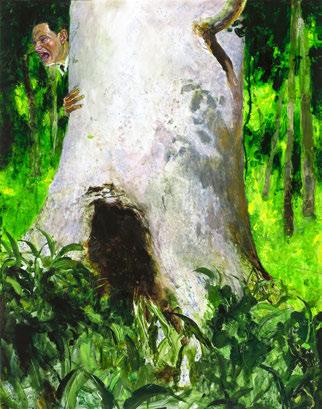
and violence.
Looking at the family history, one has to wonder if Jamie’s worldview is truly dark and unforgiving, or if, like a master magician, he is drawn to stagecraft, drama and spectacle. Some of his paintings, Burdan, who curated the exhibition, readily admits, “have the capacity to make the hair stand up on the back of one’s neck.” But, one also has to remember that Wyeth and the many generations of his family loved drama and were famous for a legendary faux-funeral procession that scared the dickens out of onlookers at a Thomaston, Maine, Fourth of July parade.
“Across the decades of his career, Jamie Wyeth has honed his attention onto these unnerving events, zeroed in on uncanny experiences and become a master of the unsettled by marshaling a wide range of disconcerting elements — subjects, compositional approaches and techniques — within his works. Developing a skillful, cinematic shorthand, Wyeth has the power to evoke anxiety in nearly every viewer,” Burdan said.
Take “Bean Boots” (1985), in which a falconer dressed in an oilskin coat and boots peers out from a hat that shades much of his face. As we absorb this scene, we encounter not only the caged raptor but a wall studded with the hunter’s trophies. These are not the run-ofthe-mill antlers one might encounter over a fireplace, but skulls with gaping eye sockets and snarling grins.
Or, “Carney Gull” (2009), a frankly terrifying portrait of a creature poised to attack its prey. “If I were to paint this


image in music,” the Scots composer Jennifer Margaret Barker wrote in the catalog that accompanies this show, “I would be obligated to score it for symphony orchestra. Wyeth may have painted a solo gull, but the force of the painting necessitates an 80-member musical ensemble.”
“The rich, vibrant hues of the somewhat abstract background stand in startling contrast with the neutrals of the realistically portrayed gull, swirling across the canvas with an intense ‘Dante’s Inferno’ of yellows and oranges to blacks and grays. One envisions a foreboding darkness within striking distance were the yellows and oranges to be peeled away. In every aspect, it is an unsettling scene, yet one so utterly compelling, too.”
Burdan notes that Wyeth creates tension with the use of two compositional techniques: Ruckenfigur — a backward-turned figure, which in his use, engages the viewer and “seems more of a provocation to come closer ‘if you dare’ — and its polar opposite, in which a confrontational figure

“Consommé,” 2013, enamel, gesso, gouache and watercolor on archival cardboard, 47¼ by 39¼ inches. Greenville County Museum of Art, Greenville, S.C. Purchased with funds through the 2017 art for Greenville campaign and the 32nd Antiques, Fine Art and Design Weekend, presented by United Community Bank. ©Jamie Wyeth / Artists Rights Society (ARS), New York City.
comes at the viewer head-on.
Wyeth’s houses feel as unsettled as his animals; even the still life, “Buzz Saw” (1969) leaves us with the sense that an inert object can become a rusty metal industrial carnivore. Consider those blades as menacing teeth!
“Perhaps not surprisingly, Wyeth’s eerie imagined creations are countered in the real world with the oddities of everyday life. He surrounded himself with unusual collections, many of which consist of precisely the types of objects that the average person might generally find strange. There are things in the world that are scary, even terrifying. Then some things are not quite frightening or upsetting — they are the prelude to fear, the unexplained feeling that something is not right,” Burdan observes.
“Snow Owl, Fourteenth in a Suite of Untoward Occurrences on Monhegan Island” (2020) might simply be a gorgeous example of animalia; that is, until one notices the swirl of birds circling overhead.
In “Portrait of Lady, Study #1” (1968), Wyeth draws us to the sheep’s eyes, which are anatomically correct but are also illustrating in Darwinian terms the animal’s need for utmost vigilance. Ditto with “Sheep Eyes” (1968), which feels like an abstract vision of terror.
One has to wonder if this Wyeth was an unabashed fan of Edward Gorey when we encounter his collection of Victorian era automatons and his own tableaux vivants , in particular the diorama he constructed for his own pleasure that enacts a bloody scene in a butcher’s shop. Automatons, robots, puppets, dolls, taxidermy, prosthetics… anything oddly real or in imitation of life has remarkably uncanny potential. “Bob et son Cochon Savant” is perhaps the creepiest of all in this exhibition. Made around 1880 by Gustave Vichy and his wife, Maria Teresa Berger, this large automaton centers on a clown with a taxidermy pig who is performing stunts in his lap from a miniature ladder. The




pig looks alarmingly real, twisting and turning to four songs while the clown claps to the music,
“Below the Barn” (1965) is rooted in an actual event (the death of a cow, and the need to
dispose of its body) and yet what perhaps intensifies the grim scene is the presence of two other very much alive cows who are bearing witness.
In “Dead Cat Museum” (1999), a boy has set up a concession



stand and is hawking views of taxidermized cats much as a kid would sell glasses of lemonade for summer pocket change.
Ghosts loom significantly in other paintings — whether it is Andy Warhol sipping consommé from a bowl (“Consommé,” 2013) or the luminaries from his life and friends and family who appear in his mixed-media screen door series, which he began after his father’s death.
Even when Wyeth paints a downed sycamore, it is imbued with human characteristics.
Wyeth has reveled in the physical pleasure of working in
oil and mixing freer brushwork with his masterly attention to detail. And he takes delight in bringing to life the role of gullsas-predators, as in his “Seven Deadly Sins” series.
The years in which Jamie came of age were tumultuous, with assassinations, the cold war and, ultimately, protests against the war in Vietnam. As unlikely as it seems, the artist became friends with Andy Warhol and actually worked in the factory for a time. What attracted Jamie to the then-controversial artist, he said, was Warhol’s genuine sense of wonder.


While their art could not have been more different, they had bonded and become genuine friends.
Wyeth was more traveled than his father and had studied anatomy and learned lithography during his years in New York City. These skills became part of an extensive artistic tool kit that evolved as an adjunct to the classical teaching he had received from his aunt Carolyn. To this day, he professes he lives and breathes for art…and his best work, he adds, succeeds when and if he becomes utterly absorbed in the character or subject.
“In ‘Jamie Wyeth: Unsettled,’ expect paintings that exude an ominous stillness, with postapocalyptic skies, frightening shifts in scale, and strange vantage points,” Burdan promises. Wyeth’s paintings may appear to be dreamscapes, but in a flash, they can fuel nightmares. With the completion of the Farnsworth’s run on September 24, the exhibition will move to The Greenville County Museum of Art in Greenville, S.C. (November 27-February 16), The Dayton Art Museum in Dayton, Ohio (March 15-June 8) and The Frye Art Museum in Seattle, Wash. (July 12-October 5, 2025).
The Farnsworth Art Museum is at 16 Museum Street. For information, 207-596-6457 or www.farnsworthmuseum.org.

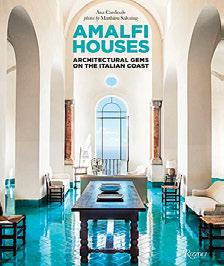


Amalfi Houses: Architectural Gems on the Italian Coast by Ana Cardinale, Photographs by Matthieu Salvaing. Rizzoli, New York City, July 2024, pp. 224, $70, hardcover.
A seemingly mythical place, the Amalfi Coast is home to dream villas within a unique landscape. Some of them have opened their doors for the first time, providing a unique opportunity to enter these exclusive homes.
the Amalfi Coast has always been a sought-after destination among artists and the international jet set thanks to its spectacular topography, which combines a rugged coast and cliffside villages overlooking the sea with the climate and the light of the Mediterranean, and the characteristic traditions and craftsmanship of the Campania region.
Visitors to The Amalfi Coast include major names that helped make it famous, such as Gore Vidal, Rudolph Nureyev, Greta Garbo, John Steinbeck, Gianni Agnelli, Jackie Kennedy and Lee Radziwill, Franco Zeffirelli, Maria Callas, Princess Margaret and Hillary Clinton.
This book gathers together beautiful houses from the Sorrento Peninsula and the stretch of coast that extends from Positano to Vietri sul Mare; the villas, each representing different eras and styles, some of which were decorated by famous designers and artists.
Each villa surprises the reader with its uniqueness: historic homes that have been transformed over the years and more contemporary villas, some with lush gardens, all equally fascinating thanks to their topographical position, architectural quality, furnishings and interior decorations, which include the
truly unique ceramic floors of Vietri.
All of them encapsulate curious stories related to the people who have inhabited and transformed them, tales traced by journalist Ana Cardinale with an abundance of detail.
The photographs were taken specifically for the book by renowned French photographer Matthieu Salvaing. They include the exteriors and spectacular landscape views, the interiors and furnishings, and numerous decorative details of the ceramic features.
Gregory Crewdson edited by Walter Moser. Prestel, New York City, in association with the Albertina Museum, Vienna, August 2024, pp. 280, $60, hardcover.
For more than three decades, Gregory Crewdson has been luring viewers into the worlds of his cinematic, highly detailed and assiduously crafted photographs. This retrospective catalog features images from nine series that represent a broad chronological spectrum of Crewdson’s oeuvre.
Included are selections from “Twilight,” the eerie and often darkly humorous photographs inspired by Stephen Spielberg’s Close Encounters of the Third Kind ; “Beneath the Roses,” which illuminates townscapes, forest clearings and broad, desolate streets with unsettling clarity; the black and white images of “Sanctuary,” shot on location at the legendary Cinecittà studios on the outskirts of Rome; “Cathedral of the Pines,” a paean to the beauty and tragedy of a gritty western Massachusetts town; and “Eveningside,” in which moments of alienation and wonder occur within the confines
of quotidian life. With the highest quality reproductions, paper changes and incisive essays by photography expert Walter Moser and other esteemed art historians, this exhibition catalog reveals why Crewdson’s powerful, elegiac and painterly photos draw comparisons to old master painting, staged photography and auteur cinema.
Never Ending: Modernist Painting Past and Future by Saul Nelson. Yale University Press, London, April 2024, pp. 224, $65, hardcover.
A new history of postwar painting that explores how the desire to look backward shaped some of the period’s most radical artmaking.
This incisive account of Modernism’s postwar development examines how painters, such as Joan Mitchell, Barnett Newman and Rose Piper, invoked tradition in order to respond to, participate in and disrupt the histories of the movement being written at midcentury. Saul Nelson argues that artists’ turn to the past, often dismissed as regressive, offers an important counternarrative to the notion of Modernism as always pushing forward. To be a Modernist, Nelson contends, was to live in doubt — about which aspects of the past were still needed and how they might be put to new use.
The story ranges across continents and historical boundaries, from India to Europe and the United States. It encompasses Grace Hartigan’s and Mitchell’s feminist reworkings of Matisse, the links between the work of Newman and nationalistic Nineteenth Century painting, the attempts of Piper to salvage a heritage from the
WASHINGTON, D.C. — The Smithsonian American Women’s History Museum has announced a $2 million gift from the CocaCola Company, a $1 million gift from The Hartford and a $1 million gift from Cassie Arison to support the development of the museum. The donations establish the Coca-Cola Company, The Hartford and Arison as founding donors of the museum, which aims to expand the story of America through the oftenuntold accounts and accomplishments of women—individually and collectively—to better understand the past and inspire the future.
“Building a national museum requires a national effort from both public companies and private individuals,” said Elizabeth C. Babcock, director of the Smithsonian American Women’s History Museum. “Support from
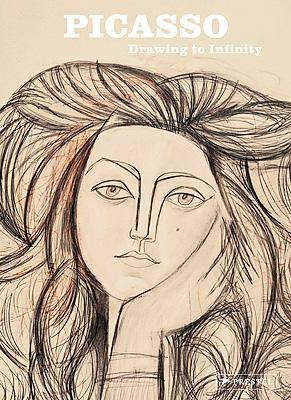
Harlem Renaissance and F.N. Souza’s interrogations of the legacies of colonialism. Never Ending presents a new history of postwar painting in which Modernism is reimagined as a practice of retrieval and reinvention, a ceaseless confrontation between tradition and the demands of the present.
Picasso: Drawing to Infinity by Anne Lemonnier and Johan Popelard. Prestel, New York City, August 2024, pp. 304, $60, hardcover.
From his early studies to his final works, drawing was, for Picasso, an ever-renewing exploration of the powers of the line. Comprising more than 300 reproductions from his massive oeuvre, this collection features both well-received and rarely seen works, as well as images from his extraordinary notebooks. It features 50 penetrating essays that examine the themes, symbols and techniques that echo throughout Picasso’s career — from monsters, crucifixions and selfportraits to crayon, crosshatching and ink. It includes book illustrations and plans for sculptures; color and figure studies; collage and journal entries. Stunning full-color reproductions allow readers to appreciate the enormous inventiveness and diversity of Picasso’s work, from serpentine lines to hatched drawing, from the delicate nuances of pastel to the deep blacks of ink.
Accompanying the largest-ever exhibition of Picasso’s drawings and engravings, this gorgeous volume is a must-have for students and fans of one of the greatest artists of the Modern era.
companies like the Coca-Cola Company and The Hartford alongside individuals like Cassie Arison is essential to building a space worthy of our mission to share women’s stories.”
“We are proud to build on our historical partnership with the Smithsonian by contributing to the launch of the Smithsonian American Women’s History Museum,” said Alba Castillo Baylin, vice president of stakeholder and social impact management, the Coca-Cola Company. “We encourage authenticity, curiosity and accountability at the Coca-Cola Company, and the women whose stories will be told at the museum embody the values that make our business, and the communities we call home, resilient.”
These donations represent another important step for the museum’s initial planning for
a building and facilitation of program development and digital content. As it builds momentum toward a future groundbreaking, the museum has already launched its first digital exhibition, “Becoming Visible: Bringing American Women’s History Into Focus,” which confronts how women’s stories have been in a constant state of becoming visible in American history.
“The Hartford is committed to advancing social equity and improving access to resources and opportunities that help create stronger, more resilient people, businesses and communities,” said Claire Burns, The Hartford’s chief marketing and communications officer.
“I am honored and proud to be one of many founders of this monumentally important museum,” Arison said.
Antiques of all kinds. Will buy for cash or will sell on consignment –no lot too large or too small.
B & S Auction Service
Thomas Barrows P.O. Box 141 Portland, Conn. Tel 860-342-2540


he Museum of Fine Arts, Boston (MFA), announced the appointment of Jared Katz as Pappalardo curator of musical instruments. He currently serves as associate curator of the Americas and Africa and assistant professor of the practice at the Raclin Murphy Museum of Art at the University of Notre Dame. Katz will assume his new role at the MFA on September 9, taking the lead in shaping the vision for the museum’s collection of 1,300 musical instruments from around the world, which ranges from ancient times to the late Twentieth Century.
The Portsmouth Historical Society welcomes Verity Boyer as a volunteer engagement and program assistant.

A life-long seacoast resident, Boyer looks forward to becoming more involved in the Portsmouth community through preservation and educational programs. She is currently pursuing a master’s degree in historic preservation with a concentration in American and New England studies from Boston University. Boyer is excited to learn more about Portsmouth and its unique history and cultural fabric.
AWASHINGTON, DC — The Smithsonian’s National Museum of Asian Art has announced that it is one of six recipients of the National Museum of Korea’s Overseas Korean Galleries Support Program. The award of $1.4 million — the largest grant yet awarded — supports the National Museum of Asian Art’s Korea program for four years and will enable the museum to expand the program, which aims to deepen audience interest in Korean art and culture.
The funding supports the following integrated set of activities that will take place over the next four years: Exhibiting and interpreting key objects from the collection of former Samsung Corp. chairman Lee Kun-hee in association with the National Museum of Korea as part of a major Korean art-loan exhibition that will be conducted at the National Museum of Asian Art 2025-2026; reinstalling the museum’s permanent collection of Korean art in a way that engages younger audiences and the community; creating public and scholarly programming that supports offerings in the galleries and operates as a nexus of activities on its own; instituting a program of staff exchanges that support other activities of the grant.
Alongside these activities, the National Museum of Asian Art will begin to define and design a strategy that increases the footprint of Korean art in the museum within the next five to seven years.
“Following our 2023 centennial celebrations, we are embarking in concert with our new partners on our

second century with great momentum,” said Chase F. Robinson, the museum’s director. “I thank the National Museum of Korea for this pacesetting gift that will allow us to continue to foreground the rich history of Korean arts and cultures as we begin a new chapter in our museum’s history.”
A recently appointed curator for Korean art and culture will lead and advise on the ambitious projects made possible by this grant. When the museum opened its doors as the Freer Gallery of Art in 1923, it was one of the first in the United States to display Korean art. The entire current Korean collection can be viewed online.
In its second century, the National Museum of Asian Art has taken an increasingly global turn. The award from the National Museum of Korea animates the museum’s four strategic plan goals: to expand, preserve and celebrate its collections; to identify, attract and serve new and diverse audiences through its physical and digital spaces; to foster an objectinspired understanding of the arts, communities, cultures and societies of Asia; and to build a museum culture that is creative, collaborative, transparent and resourceful.
The Smithsonian’s National Museum of Asian Art is at 1050 Independence Avenue SW. For information, 202-633-1000 or www.asia.si.edu.

t Morris Museum, Paul Muir is joining the organization’s executive team as its director of external affairs. A wellknown community leader and experienced cultural professional, he brings to the role a wealth of perspective and skill at a critical moment in the history of the museum. This appointment comes thanks to a thorough, region-wide search that drew more than 200 applicants. Muir is former chairman of the nonprofit roundtable of the Morris County Chamber of Commerce, currently leads the statewide advocacy group Preservation NJ and recently served as president of the New Jersey Council of Mayors.

The Norton Museum of Art has appointed Dr Regina Palm as the Harold and Anne Berkley Smith senior curator of Modern art. Palm will join the Norton September 30. In this role, she will be responsible for the American and European Modern art collections, including paintings, sculptures and works on paper from the Modern era. The Norton is internationally known for its collection of contemporary art, Chinese art and photography, as well as American and European art, which Palm will oversee particularly works created between the mid-1800s and 1960. Palm joins the Norton from the San Antonio Museum of Art.
SOUTH BEND, IND. — The Raclin Murphy Museum of Art announced that it has been awarded a $2.5 million grant from Lilly Endowment to enable the museum to continue to deepen engagement and scholarship on religion, spirituality and faith. The grant was made through Lilly Endowment’s Religion and Cultural Institutions Initiative, which aims to improve the public understanding of religion and in doing so foster greater knowledge of and respect for diverse religious traditions.
The Raclin Murphy Museum of Art opened in December 2023 as a new, 70,000-square-foot, state-of-the-art facility featuring 23 galleries and numerous public spaces, including classrooms, a chapel, a cafe and a bookshop. Situated at the corner of Eddy Street and Angela Boulevard, the museum serves as the entrance to the University’s Arts Gateway and encompasses more than 30,000 objects.
This is the second grant the university has received from Lilly Endowment through its national Religion and Cultural Institutions Initiative. A nearly $2.5 million grant in 2020 helped support the university’s strategic

efforts to explore the role of religion, spirituality and faith in its extensive collection of art and artifacts.
This new grant will allow Notre Dame to expand the Raclin Murphy’s capacity to engage its core constituencies in exploring, deepening and challenging ideas of religion and spirituality through its collections and exhibitions. The museum will do so with three key objectives in mind: strengthen and diversify holdings related to religion and spirituality through strategic acquisitions; provide opportunities for research and scholarship on museum holdings related to religion and spirituality; and conserve existing museum holdings related to religion and spirituality. A primary component of the grant will be used to support the acquisition of new objects.
“On behalf of all at the Raclin Murphy Museum of Art, I am profoundly grateful to all those at Lilly Endowment who have made this extraordinary grant possible,” said Joseph Antenucci Becherer, the museum’s director and curator of sculpture. “With great care and insight towards the understanding, scholarship and growth of our collections, this grant spotlights critical areas for the museum, including research, conservation and strategic acquisitions.”
With origins that date to 1875, the Raclin Murphy’s collection has grown into one of the most significant and extensive collections of any academic museum in the United States with works representing many of the principal cultures and periods of world art history. Its paintings, sculptures, ceramics, prints, drawings, textiles, baskets and decorative arts offer visitors a broad view of global proportions. The museum will celebrate its sesquicentennial in 2025.
“We’ve witnessed how important conservation is and what astonishing things can result,” Becherer said. “We’ve also committed ourselves to significant acquisitions in the sesquicentennial campaign, 150 for 150, and this gives us a great boost. We’ve also recognized the need for research support to live out this aspect of our being, and this is our first necessary step forward.”
Admission to the museum is free for all guests. For more information on hours of operation, exhibits and special events, visit www.raclinmurphymuseum.nd.edu.
Aug 2July 11July 18July 19July 22July 23
Aug 9July 18July 25July 26July 29July 30
Aug 16July 25 Aug 1Aug 2Aug 5Aug 6
Aug 23Aug 1Aug 8Aug 9Aug 12Aug 13
Aug 30Aug 8Aug 15Aug 16Aug 19Aug 20
Sept 6Aug 15Aug 22Aug 23Aug 26Aug 27
Sept 13Aug 22Aug 29Aug 30Aug 30Sept 3
Sept 20Aug 29Sept 5Sept 6Sept 9Sept 10
Sept 27Sept 5Sept 12Sept 13Sept 16Sept 17
Oct 4Sept 12Sept 19Sept 20Sept 23Sept 24
Oct 11Sept 19Sept 26Sept 27Sept 30Oct 1
Oct 18Sept 26Oct 3Oct 4Oct 7Oct 8
Oct 25Oct 3Oct 10Oct 11Oct 14Oct 15
LONDON — Bonhams has announced Chabi Nouri as global chief executive officer (CEO) of the international auction house. Nouri, who will be based in Bonhams’ headquarters in New Bond Street, London, will take up the position in October 2024 at the 14-saleroom auction house.
Bonhams, one of the four original Georgian London auction houses, was founded in 1793. It is owned by Epiris, the UK-based private equity company. With 14 salerooms across the globe, selling items in more than 60 collecting categories, Bonhams has one of the largest global networks. In 2022, it acquired four auction houses — Bukowskis in Stockholm, Bruun Rasmussen in Copenhagen, Skinner in Boston and Cornette de Saint Cyr in Paris

— all of which are now integrated into the Bonhams network.
Swiss-born, Nouri has deep knowledge and experience in international luxury and retail organizations — her previous roles were as CEO of Richemont-owned watch and jewelry company Piaget and where she stayed for seven years before joining the Mirabaud Group in 2022 as a private equity partner. She began her career at Cartier where she held several positions in the 10 years she was there, after graduating from Fribourg University in Switzerland.
Hans-Kristian Hoejsgaard, Bonhams executive chairman, said: “It is a great pleasure and privilege to welcome Chabi Nouri to Bonhams. Her experience and qualities make Chabi a perfect fit for the company. Having served as a CEO
of a leading luxury company, and in her most recent role as a comanager of a private equity fund, Chabi has proven abilities as a strong brand-builder, and for digital innovation. Her background in luxury also brings valuable experience and insight to one of the most important categories at Bonhams.”
Chabi Nouri said: “I am delighted to be joining Bonhams, which has a long heritage, rich history and strong values as an auction house, as well as a reputation as an innovator. Its focus on digital transformation, global reach and passion, nurtured by its extraordinary talents, makes it an exceptionally exciting and dynamic company. I look forward to building on these strong foundations and focusing on Bonhams’ core DNA.”
Every Thurs goldengavel.com
Golden Gavel 50
Every Tues Coventry, CT Weston’s.....................54 Thru 13, Aug thcauction.com Thomas Hirchak 52 9, Aug Jewett City, CT Leone’s Auction 2 11, Aug affinityantiquesauction.hibid.com Affinity Auction 51 11, Aug nathanre.com Nathan Auction 52 11, Aug..www.statelineauctionsandestateservices.com...State Line 50 12, Aug hudsonvalleyauctioneers.com...Hudson Valley Auctioneers 51 12-14, Aug michaans.com Michaan’s 48
13, Aug auctionninja.com SJD Auctions.................54 13, Aug madisonauctionserviceny.com Madison Auction C6 14, Aug eldreds.com Eldred’s 53 15, Aug nicholasauctions.com Nicholas Auctions 50 15, Aug eldreds.com Eldred’s 54
16, Aug merrillsauctions.com Merrill’s Auction 49
16, Aug michaans.com Michaan’s 48

10, Aug Mashpee, Cape Cod 7 12-18, Aug Bouckville, NY 13 14, Aug Waldoboro, ME 3 16,Aug-20,Sept....... Willow, NY 23
16-17, Aug clars.com Clars 45 17, Aug barridoff.com Barridoff 4C 17, Aug kaminskiauctions.com Kaminski 55 17, Aug midhudsongalleries.com Mid-Hudson Galleries 52 18, Aug ameroauctions.com Amero Auctions 2C 18, Aug kaminskiauctions.com Kaminski 46-47 18, Aug liveauctioneers.com SJ Auctioneers 52 18, Aug whitesauction.com White’s Auction 6C 20, Aug strawserauctions.com Strawser Auctions 55 21, Aug kodner.com..............................Kodner 54 23, Aug Jewett City, CT Leone’s Auction 2 23-24, Aug litchfieldcountyauctions.com...Litchfield County Auctions 2 24, Aug newfrontiershow.com New Frontier Show 53 24, Aug rolandauctions.com Roland Auctions 2 24, Aug rolandauctions.com Roland Auctions 13 24, Aug rolandauctions.com Roland Auctions 48 24, Aug thoscornellauctions.com Thos Cornell Galleries 2 24-25, Aug sarasotaestateauction.com Sarasota Estate Auction 3C 23-25, Aug thomastonauction.com Thomaston Auction 50 23-25, Aug thomastonauction.com Thomaston Auction 52 23-25, Aug thomastonauction.com Thomaston Auction 8C 27, Aug poulinauctions.com Poulin Antiques & Auctions Inc .7C 29, Aug bodnarsauction.com Bodnar’s Auction 54 8, Sept tremontauctions.com Tremont Auctions 54 25, Sept litchfieldcountyauctions.com Litchfield County 2 28, Sept fontainesauction.com Fontaine’s 5C 27, Oct tremontauctions.com Tremont Auctions 54 13, Nov litchfieldcountyauctions.com Litchfield County 2 17, Nov butterscotchauction.com Butterscotch Auction............2
24, Aug Westmoreland, NH 9 25, Aug Milford, NH 11 31, Aug-1, Sept.....Stormville, NY 2 3, Sept Brimfield, MA 2 5-7, Sept Brimfield, MA 9 8, Sept Milford, NH 11 12-15, Sept Atlanta, GA 5,11 14, Sept Westmoreland, NH 9 22, Sept Milford, NH 11 28-29, Sept Schoharie, NY 9 12-13, Oct Stormville, NY 2 19, Oct Westmoreland, NH 9 2, Nov Stormville, NY 2 30,Nov-1,Dec .......Columbus, OH 5,11
Weekly Events Thurs-Sun West Hartford, CT 3 Sun........................Jewett City, CT 2 Sun ......................New Milford, CT 2
LAMBERTVILLE, N.J. & CHICAGO — Rago Wright is set to revolutionize the collectibles market with the launch of Landry Pop Auctions (LPA), led by expert and TV star, Travis Landry.
This new venture will be the sixth stand-alone auction house under the Rago Wright umbrella, signaling the firm’s continued growth and diversification. With Travis Landry at the helm, LPA will introduce an exciting range of offerings in comics, toys, video games and trading cards, as the collectible market continues to accrue significant value and attract new buyers.
Travis Landry, known for his roles on PBS’s Antiques Roadshow (2017-present) and the Travel Channel’s Toy Hunter (2012-2014), brings his encyclopedic knowledge and passion for collectibles to LPA. His expertise in a range of culturally significant collectibles will expand Rago Wright’s offerings into new categories, providing services previously unmet within their network.
“Joining forces with Travis to form Landry Pop Auctions will revolutionize the collectibles market,” said Richard Wright, CEO of Rago Wright. “Travis’ extensive knowledge and passion for collectibles, especially in
comics, toys, video games and trading cards, aligns perfectly with our vision for growth and diversification. His unmatched expertise will elevate our offerings and provide our clients with unparalleled auction experiences. We look forward to this new chapter and the incredible opportunities it will bring.”
Travis began his auction career at just 12 years old and since then, has handled numerous high-profile items, including a 1999 Pokémon Base Set Shadowless Booster Box that brought $100,000 at market, a Marvel Comics Fantastic Four #1 (11/61) CGC 8.0 which sold for $150,000 and a Marvel Comics Werewolf by Night #1 (9/72) CGC 9.8 which sold for $51,250. The latter two above-mentioned comics were from the collection of Kevin Willis, CFO of Ashland Inc., which was sold at auction on New Year’s Day of 2022 and was part of the 20-lot auction selling for a total of $900,000.
Notably, Landry also handled the collection of Andy Yanchus, the project manager for Aurora (1965–1975) and colorist for Marvel Comics (1975-1992). His extensive experience and enthusiasm for discovering rare finds will be pivotal in driving LPA’s successes.
ESSEX, UK — More than a dozen letters and cards from Diana Princess of Wales to her family’s former housekeeper sold at auction in Essex on July 30, for a total of $66,230 (£51,850), including buyer’s premium. The collection included a trove of correspondence between the princess and the lady she knew simply as Collie (otherwise known as Violet Collison, head housekeeper to the Spencer family at Sandringham Estate). In a two-page letter, writing as the Princess of Wales on Kensington Palace notepaper on September 25, 1984, Diana thanked her former housekeeper for a gift to Prince Harry. She noted that, “William adores his little brother and spends the entire time pouring an endless supply of hugs and kisses over Harry.” Offered together with a Christmas card from the same year, this lot rose to $16,605 (£13,000), the highest price of the sale. It will be staying in the United Kingdom with its new owner. Luke Macdonald, director at Sworders Auctioneers, said the letters were “so intimate.” More highlights from this sale will be featured in an upcoming issue.

“Landry Pop Auctions will bring a fresh and dynamic approach to the auction industry,” said Landry. “With my deep passion for and expertise in comics, toys, video games and trading cards, and Rago Wright’s innovative stye and superior expertise, we will move the industry forward in new and exciting ways. I look forward to discovering and showcasing rare and extraordinary items, creating unparalleled auction experiences for collectors and enthusiasts alike.”
Over the past five years, Rago
Wright has demonstrated significant growth through strategic acquisitions and market expansion. From the merger of Rago and Wright in 2019 to the recent acquisition of Poster Auctions International, the firm has continually broadened its scope. The addition of LPA further diversifies its portfolio, catering to modern collectors and enthusiasts. Landry Pop Auctions will be launching its first auction in October.
Interested in selling your collectibles? Connect with Travis at travis@landrypop.com.

(St Petersburg, Fla.) Variety Was Key At Burchard’s Sizzling Summer Auction
(Glen Cove, N.Y.) Dufy Paintings Lead Diverse Mix Of Offerings At Roland
(Reno, Nev.) Coeur D’Alene’s Best Of The West Auction Corrals $17 Million
(Morristown, N.J.)
(Easton, Md.) Guyette &
(Sudbury, Mass.) Louis, Vuitton,
(New York City)
(Santa Fe, N.M.)
(Cincinnati,
(Santa Fe, N.M.)
(Sarasota, Fla.)
WINDHAM, CONN. —
Gerard Paul “Jerry” Giguere Jr died unexpectedly of natural causes on July 18, at his home in Windham, at the age of 76. He was born December 12, 1947, in Portland, the son of the late Gerard P. and Agnes D. (Grondin) Giguere.
Gerard graduated from Gorham High School, class of 1965. He graduated from the University of Maine in 1967 with a degree in Marketing and Finance. He served in the US Army Reserves and his early business career was concentrated in sales in the Boston area. While working for Richard P. Rita Personnel Services in Providence, R.I., he met and married Patricia M. Siembab in 1974. They celebrated 50 years of marriage on April 27, 2024. They lived in Coventry, R.I., for several years and later
moved to Milford, Mass. While living in Massachusetts, Gerard was employed by Technical Aid Corporation in Boston, an employment services business. It was in Massachusetts that his only child, Joy Marie, was born in 1980. In 1981, an opportunity to return to Maine arose and he became a vice president of Romac & Associates in Portland, Maine, an executive personnel placement business. In 1990, Gerard became a licensed auctioneer in Maine and he and his wife launched Giguere Auction Company, which they ran together for 33 years. Gerard established a reputation for excellence and integrity, both as an individual and as a business, and he was nationally recognized for his knowledge and expertise in many fields, most notably sporting collectibles and taxidermy.
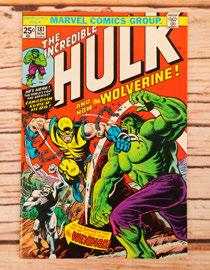

Gerard was a devoted Roman Catholic, a member of the Knights of Columbus and Our Lady of Perpetual Help parish in Windham. An avid outdoorsman, he enjoyed hunting, fishing and spending time on his

NEW BRUNSWICK, N.J. — Bodnar’s July 31 sale pleased comic collectors, while its August 1 auction targeted Barbie doll fashionistas. At the July 31 sale, The Incredible Hulk #181, considered to be “The Grail” for collectors, containing the first full appearance of Wolverine and with the Shanna the She-Devil value stamp intact, VF condition, sold for $8,100, including buyer’s premium.
boat on Sebago Lake with family and friends, most especially his two young grandsons. He was a member of various sports organizations — Ducks Unlimited, Trout Unlimited and Safari Club International, and served as an auctioneer at fundraising auctions for them and many other organizations and groups at their events over the years. He was an expert billiards player and played in various individual and team competitions over the years. He is survived by his wife, Patricia M. (Siembab) Giguere, and their daughter, Joy M. Giguere and her husband, Benjamin A. Proud, of Dallastown, Penn., two grandsons, Charles Gerard Giguere Proud and Raymond James Giguere Proud, three sisters, Suzanne Legere and her husband, John, of Windham, Mar-
tha Morrill and her husband, Robert, of New Gloucester, Maine, and Claire Berg of Westbrook, Conn., his father and mother-in-law, Raymond J. and Marie L. Siembab of Coventry, R.I., his brother-inlaw, Richard R. Siembab of Bristol, R.I., a nephew and many nieces and cousins. He was devoted to his family and friends and will be sorely missed by all who knew him. A Mass of Christian Burial was celebrated at Our Lady of Perpetual Help Church in Windham on Saturday, August 10, followed by a reception in the Parish Hall immediately thereafter. In lieu of flowers, donations may be made to The American Heart Association. To offer condolences and share memories with the family, please go to www.athutchins.com.
‘Captain America Comics’ #1 Packs A Mighty
YORK, PENN. — Prized Golden Age comics always lure collectors to Hake’s auctions, and the firm’s July 30-31 Premier online auction was no exception. Among the 2,120-lot selection was a star appearance by a CGC 5.5 fine- issue of Captain America Comics #1. It was a rare comic with a publication date of March 1941, and it contained the origin and first appearance of Captain America, Bucky Barnes and their sworn enemy, the Red Skull. And because World War II was roiling Europe, the cover depicts Captain America delivering a mighty punch to Hitler. The comic captured a winning bid of $172,221, including buyer’s premium.

“The July 31 sale was the better of both days,” said Joe Bodner, owner. “There were more than 3,000 registered bidders with 550 participating across three platforms, Bodnar’s Auction, LiveAuctioneers and Invaluable.” It was a “White Glove” sale with all 263 lots finding buyers and it totaled $62,680. More highlights from both days will be featured in a follow-on review.
The next day, a virtual Barbie runway was topped by a Silkstone Dahlia Barbie doll from a Barbie fashion model collection of a consignor who enjoyed and displayed many of her Barbies. With a Barbie Collector Platinum label and complete in a box, the doll sold for $1,320 with buyer’s premium.
HUDSON, NEW YORK —
Stair Galleries closed out July and entered August with two days of back-to-back auctions. On July 31, Indigenous Arts of North America presented 205 lots that “embody the sophisticated aesthetic sensibility of Native artists and artisans combined with their technical mastery of pottery, basketry, weaving and other Native arts.” Americana at Stair, on August 1, brought forth 287 lots “celebrating the history and diversity of the United States,” including furniture, folk art and decorations. Earning the top spot in the Indigenous Arts auction was a chief’s second phase

Zanne
ket, which was possibly Navajo, measured 63 by 50 inches and is heading to South Carolina after selling for $11,520 with buyer’s premium ($5/7,000). Leading the Americana sale was “The Abduction of Daniel Boone’s Daughter,” an oil painting by German-born Charles Ferdinand Wimar (1828-1862). The circa 1853 painting, depicting several Natives holding young Jemima Boone captive in a canoe, measured 21 by 25 inches framed. It sold to a Kentucky buyer for $52,480 with premium ($40/60,000). A comprehensive review of both sales will be in a forthcoming issue.
“This is not only a key Golden Age comic book with added historical significance, it’s also a key issue when compared to the entire realm of comic
books,” said Alex Winter, president of Hake’s Auctions. More highlights of the two-day auction will be included in a follow-on review.
CINCINNATI, OHIO — On August 1, Freeman’s | Hindman presented 226 lots in its third installment of auctions

from the barbershop collection of James Carpenter. Featuring occupational shaving mugs, barber bottles and other barbershop collectibles, the highest note of the day was $3,556 including buyer’s premium, realized for a porcelain occupational shaving mug estimated for $500/700. Depicting the opera singer and impresario, Mimi Imperator, gilt lettering and bearing the green “T&V” mark for Tressemanes & Vogt of France, the piece had additional provenance to the Linneman Collection of New York City. More highlights from the sale, which was more than 95 percent sold by lot, will be discussed in an upcoming issue.

WHITEHOUSE STATION, N.J. — On August 3, The RSL Auction Company hosted The Haradin & Thomas Family Collections, a two-part auction that offered some of the best still banks, toys, and paper lithography pieces to go to market in recent memory. The top lot was a “Charles” Hose Reel Carriage made by the George Brown Company of Forestville, Conn., circa 1870, and was one of the largest toys in that producer’s catalog. It went to a bidder on the phone for $312,000 with buyer’s premium. More to come on this historic auction.
SCOTTSDALE, ARIZ. — Four of the top six lots in Scottsdale Art Auction’s 401-lot sale, con-
ducted on August 3, were all by Frederic Remington (18611909). In the top spot overall,

exceeding its $25,000 high estimate to earn $81,900, was “Goot Packers At Work,” an original illustration for the March 1981 issue of The Century Magazine (shown). Done in pen, ink and black and white watercolor, the work depicted two cowboys using significant effort to strap packs onto the back of a horse and measured 20 by 26 inches framed. The other three works by Remington, also done for the same publication between 1888 and 1891, were “Hauling Wagon Out of Bog Hole” ($76,700), “The Outlying Camp” ($47,200) and “Indian Territory Apache’s Playing Monte” ($44,250). All prices include the buyer’s premium. Further review of the sale will be in a future issue.
NEW BRITAIN, CONN. — The New Britain Museum of American Art presents “Modern Women: Visionary Artists,” on view through August 3, 2025.
In the late 1940s, a new style of painting emerged that would change the course of modern art. A group of artists, working mainly in New York City, began to reject realism in favor of abstraction. In the tumult and malaise of the post-World War II years, their focus turned inward. Known as the Abstract Expressionists, their art launched a rebellion. Their work appeared spontaneous, idiosyn-

cratic and emotionally charged. They dripped and threw paint, used unconventional materials, rejected and recreated the rules of artmaking.
Although most often associated with such names as Jackson Pollock, Willem de Kooning and others of their male cohort, recent attention has turned to the women artists who helped pioneer the movement. This installation features seven women whose participation in the Abstract Expressionist movement contributed to the advance of modern art. At a time when social norms hindered professional advancement for most women, artists such as Joan Brown, Helen Frankenthaler, Grace Hartigan, Lee Krasner, Joan Mitchell and Louise Nevelson expanded the conceptual scope and technical possibilities of what art could be. Their innovations extended into Post-War and Conceptual art, in which artists including Jenny Holzer continued to redefine artistic expression, paving the way for future generations of artists to explore new dimensions of creativity and meaning. “Modern Women: Visionary Artists” celebrates the enduring legacies of artists who not only transformed the creative landscape of their time but also continue to inspire and inf luence art today.
Works on view in this exhibition are from the collections of the Whitney Museum of American Art and Art Bridges as part of the Art Bridges’ Partner Loan Network program. This installation is the first in a series of long-term loans coming to the New Britain Museum of American Art from American art collections across the country. The New Britain Museum of American Art is at 56 Lexington Street. For information, 860-229-0257 or www.nbmaa.org.

NANTUCKET, MASS. — On August 3 and 4, Rafael Osona Auctions conducted a two-day sale, offering over 1,000 lots of varying Americana, fine and decorative arts and maritime antiques. The top lot of either day was a pair of Terrestrial and Celestial globes, manufactured by the London-based John and William Carey, which spun to $41,600. The New Terrestrial Globe was dated March 1, 1815, while the New and Improved Celestial Globe was dated March 1, 1799. Both globes consisted of hand-col-
ored engravings on a plaster sphere, each capped with a brass hour circle. They were mounted on brass meridian and mahogany tripod stands, which contained engraved calendar rings and cross stretchers, as well as a compass on raised casters. Day Two of the auction, which focused on maritime antiques, was led by a Nineteenth Century large antique narwhal tusk, discovered in the Arctic Circle, which earned $20,480. More highlights from this sale will be reviewed in an upcoming issue.
LEXINGTON, KY. — On July 31, Antique American Clocks conducted its July 2024 auction, offering a vast assortment of movement, shelf, porcelain, chime and weight and springdriven clocks, as well as regulators, figurals, shelf calendars and novelties, among other items. Leading the sale was a Curtis & Clark miniature eight day brass clock, made in 1824. Marked “29” in pencil on the seat board and the top of its case, this clock is one of 31 known examples of the first brass, spring-driven, mass-produced shelf clocks made in the United States. Signed “Curtis & Clark, Plymouth, Conn.,” the mahogany veneered clock had carved columns and a brass inlay in its cornice; it is also one of three known clocks that do not have a second hand, according to the auction catalog. Its rarity on all fronts

encouraged bidders to push it to $16,240, clearing its $7,5/15,000 estimate. More noteworthy clocks from this sale will be highlighted in an upcoming issue.

The Bowden Spacelander was designed in 1949 in only five colors, charcoal black being the rarest. There were only 522 of the space-age-style bicycles ever produced in 1960. It was thus predictable that this Spacelander in the rare and desirable charcoal black color would be the sale’s top lot — and it was, selling on HiBid for $18,360 to private gentleman from Kansas City, who came in to Carrell’s gallery to personally view the bicycle, according to Josh Carrell.

A 1988 Schwinn Paramount special edition bicycle with a rare full 50th anniversary Campagnolo equipment realized $5,260.
Since there were only 522 ever produced in 1960, it was a cinch that one of Benjamin George Bowden’s (1906–1998) Spacelander bicycles, especially the rare and desirable charcoal black model, would rocket to the top of Carrell Auction’s July 28 online
auction on HiBid, selling for $18,360. The Bowden Spacelander was designed in 1949 in only five colors, charcoal black being the most rare. Bowden, a British industrial designer, was primarily known for his work on automobiles and bicycles. Unfortunately, at the time, a space-age

This Schwinn Stingray Fastback vintage orange bicycle, decorated with a Tour de “Fat Choice” prize-winning ribbon, earned $2,280.

This 1952 Schwinn Black Phantom tank-style bicycle gar-
bicycle turned out to be commercially unsuccessful when in production. Now, it’s a collector’s item, the winning collector a private gentleman from Kansas City who came in to personally view the bicycle, according to head auctioneer, Josh Carrell. Carrell’s online auction dispersed rare examples from the single-owner antique and vintage bicycle and motorbikes collection of Gary Long. Long is the former owner of Cycle Works bicycle shop in Lawrence, Kan. In his collection, he had antique highwheel and wooden rim bicycles, vintage motorbikes and motorcycles as well as all the repair equipment and related parts that went with them. In this sale, the concentration was on vintage
Review by
W.A. Demers, Senior Editor
Photos Courtesy Carrell Auctions
mid-weight and lightweight bicycles, including Schwinn Krates, Stingrays, tank bicycles and balloon tire bikes. It was — for the serious antique and vintage bicycle collector — a once in a lifetime opportunity to own part of Long’s historic collection.
The sale’s total was $88,482 and there were 200 bidders, some international but mostly domestic from all over the United States.
Dr Tamara Carrell, co-owner, reflected on the sale, saying, “This was a pretty good auction for a small, Midwestern auction house. Several pieces sold for full retail or more, which is not bad in a semi-soft market. As with all auctions, some pieces over-performed and a few under-performed. There were only a handful of lots that went unsold: miscellaneous parts etc. Mr Long was well-pleased with the results and awaits part two of his estate, which includes a 1933 Goudey set of baseball cards, including

Schwinn originally offered the Krate bicycle in 1968 ,in three colors — red, yellow and orange — with a stick shift gear changer and a windshield; this 1968 example was bid to $1,860.
Lou Gehrig and Babe Ruth. These were sent to PSA for grading and thus the sale will be conducted in October when the cards come back. The second half of Long’s sale will feature antiques and vintage toys, as well as the 1933 Goudey set.
“There was tremendous interest in the bicycle auction in the regional Midwest. Many collectors have come to us expressing interest in consigning their bicycles, which has prompted Carrell Auctions to offer a consignmentbased classic bicycles and motorcycles auction late spring of 2025. We received numerous feedback about how wonderful it is to have an auction house that actually understands the bicycles they are selling.”
Josh Carrell has been a bicycle collector for more than 30 years and has developed an expertise in this area, as well as a large network of bicycle collectors across the United States.
A 1988 Schwinn Paramount special edition bicycle with rare full 50th anniversary Campagnolo equipment drew a winning bid of $5,260. In 1988, Schwinn celebrated the 50th anniversary of the Paramount model. All bikes built during that model year received a special 50th Anniversary decal. There were extra goodies, too, as Schwinn offered the special edition frameset, designed to be both ridable and collectible.
No bicycle collection auction would be complete without a high wheel, and in this sale an antique 1887 Gormully & Jeffery high wheel bicycle fit the bill, rolling in for $3,120. Gormully & Jeffery, founded in Chicago in 1879 by Thomas B. Jeffery and R. Philip Gormully, was the second bicycle manufacturer established in the United States. Also known as a penny-farthing, the high wheel design provided a smoother ride as pneumatic tires were waiting to be invented. Popular in the 1870s and 1880s, penny-farthings got their name from the fact that the bikes’ two wheels were sized differently —
the front wheel a penny coin and the smaller rear wheel a farthing (a quarter of a penny).
Schwinn dominated this sale, with eight of the top 10 lots attributed to the American marque.
A Schwinn Whizzer vintage maroon motorbike zipped to $2,460, while a Schwinn Stingray Fastback vintage orange bicycle commanded $2,280. The Stingray Fastback was decorated with a Tour de “Fat Choice” prize-winning ribbon.
Bringing California style cool to this sale was a 1968 Schwinn Orange Krate bicycle with windshield, which was bid to $1,860. In 1968, Schwinn came out with the Krate bicycle, the name borrowed from the a notable California dragster. It was originally offered in three models — The Apple Krate (red); the Lemon Peeler (yellow); and the Orange Krate. On these models, the gears were changed via a stick shift mounted on the tube, and there was a windshield to make it look like a chopper motorcycle.
A bicycle built for two, a 1968 Schwinn Stingray Mini Twinn Tandem in Campus Green brought $1,740. Schwinn manufactured the “String Ray”-style tandem bike for just one model year, so there aren’t many of them available. This sale had two of them. Another example of the 1968 two-person ride in blue clocked in at $1,500.
Introduced during the 1960s, the Schwinn Pea Picker was among the many models that the company released to capitalize on the muscle car craze. As kids were interested in customizing their bicycles with dragster-style handle bars, wheel designs, sissy bars and low-slung seats, the Pea Picker model proved popular. In this sale, a 1971 Schwinn Stingray Pea Picker Krate left the gallery at $1,380.
Another rarity wheeled out for bidder attention was a baby boomer classic — a 1952 Schwinn Black Phantom tank-style bicycle (playing cards and clothespins on the spokes optional). This artwork on two wheels found a new owner for $1,320.
An ephemeral maker of bicycles, the Monark Silver King Company of Chicago was in business from the early 1930s through the 1950s. The company’s innovative streamlined bicycle designs, pure Art Deco, are scarce as many were sacrificed for scrap metal during World War II. Here, a survivor Silver King Monark vintage aluminum bicycle took $1,230.
Prices given include the buyer’s premium as stated by the auction house. Carrell has quarterly art and design auctions. The next one will take place in September and will feature Midcentury Modern furniture, bronzes, paintings, art glass and more. For information, 816-216-3163 or www.carrellauctions.com.

Many of the Monark Silver King aluminum bicycles produced by the Monark Company of Chicago from the early 1930s through the 1950s were broken up for scrap metal during World War II. Scarce, this complete Silver King Monark vintage aluminum bicycle took $1,230.

Introduced during the 1960s to capitalize on the muscle car craze, the Schwinn Pea Picker model proved popular. In this sale, a 1971 Schwinn Stingray Pea Picker Krate sold for $1,380.

antique 1887 Gormully & Jeffery high wheel bicycle sold for $3,120.
Another vintage Schwinn Whizzer motorbike survived with both front and rear drum brake. It had not been started in many years and was sold as is for $1,140.

Fetching $1,740 was a 1968 Schwinn Stingray Mini Twinn Tandem in Campus Green. Schwinn manufactured the “String Ray”-style tandem bike for just one model year.

example of the 1968
in blue rode to $1,500



PALM BEACH, FLA. — The Flagler Museum is undertaking an elaborate restoration of Whitehall’s formal dining room. The room, designed in the Henri IV style, reflects the tastes of affluent French society during the reign of Louis Napoléon. This revival style, favored for grand banquet rooms in French townhouses and châteaux, was well known to the New York City design firm of Pottier & Stymus, the original interior designers of Whitehall. Their New York factories created many pieces of furniture and employed numerous European artisans.
The 1902 photographs of the dining room in the Flagler Museum Archives show the furniture and woodwork in a harmonious transparent finish that highlighted the impressive feature of the satinwood that gives it its name. Additionally, the photos reveal faux-painted gilt friezes and ceiling beams simulating satinwood, adding to the room’s cohesive aesthetic.
When first installed in 1902, Pottier & Stymus created the dining room using incredibly rare Jamaican satinwood, a material that is now nearly extinct. Now commercially unavailable, satinwood was a highly coveted cabinet wood when it first appeared regularly in Europe, Great Britain and the East Coast on the United States in the late Eighteenth Century. Due to its limited geographic distribution and medium size, satinwood was never as abundantly produced as other tropical hardwoods like mahogany or rosewood. In the Eighteenth and early Nineteenth Centuries, it was often used in small quantities as veneer, marquetry, or a light-colored contrast in darker primary wood pieces.
Entire furniture pieces made from satinwood were rare,


making Whitehall’s dining room, made of solid satinwood, the largest and most elaborate satinwood room ever built in the Western Hemisphere and probably the world.
There has never been another satinwood room built that compares to Whitehall’s dining room in terms of size, quality, or elaborate decoration and there never will be. The Whitehall dining room represents a unique moment in history, showcasing the technology, availability of the wood, and wealth that existed in America at that time to make such a magnificent room possible.
In 2018, Whitehall’s dining room furniture — a grand banquet table, 24 upholstered chairs and two double-high sideboards — was returned to the Flagler Museum after an absence of nearly a century.
This suite of furniture underwent comprehensive conservation by F. Carey Howlett & Associates in 2019 and was


reinstalled in Whitehall’s dining room in early 2020. The conservation process revealed numerous modifications made throughout the Twentieth Century as well as a spectacular feature of the room. Among
these alterations was a dark stain that concealed the true nature of the wood. Removing the stain and conducting microscopic analysis confirmed the furniture was made of Jamaican Satinwood (Zan-
thoxylum flavum), a nearly extinct species of hardwood native to the West Indies and the Florida Keys. This revelation was particularly striking when the light-colored furniture was juxtaposed with the dark stained paneling and fireplace in the dining room. The restoration of the dining room has been underwritten by Thomas S. Kenan III, and The Stockman Family Foundation. The project is progressing well, with two large crews at work: one focused on the paneling and fire mantel, and the other on the ceiling. F. Carey Howlett & Associates are now taking on the monumental task of removing the dark stain from the satinwood and returning Whitehall’s dining room to its original appearance and glory.
Henry M. Flagler’s Whitehall, which houses the Henry Morris Flagler Museum, is at 1 Whitehall Way. For further information, www.flaglermuseum.us.
NEWPORT, R.I. — Lauded for its elegance and innovative design, the Isaac Bell House is one of the best surviving examples of Shingle Style architecture in the United States.
Through August 31, guide-led tours now allow visitors to experience this National Historic Landmark on Saturdays and Sundays with the purchase of a timed ticket.
The house was built between 1881 and 1883 by the firm of McKim, Mead and White for Isaac Bell Jr., a cotton broker, investor and ambassador to the Netherlands. It was a distinctive addition to Newport’s architectural landscape, blend-
ing English Queen Anne with New England Colonial, Japanese and French/Breton design influences with features like sliding doors and a pinwheel floor plan, with a focus on natural light and ventilation. It would have a significant impact on the later domestic work of Frank Lloyd Wright.
In November of 2023, The Preservation Society of Newport County began a $3.3 million restoration and preservation of the Isaac Bell House that included replacing all exterior shingles, restoring the shutters and windows, repointing the lower-level brick and chimneys and much more. The
work is now complete.
The Preservation Society of Newport County, Rhode Island, is a nonprofit organization accredited by the American Alliance of Museums. It is dedicated to preserving and interpreting the area's historic architecture, landscapes, decorative arts and social history. Its 11 historic properties — seven of them National Historic Landmarks — span more than 250 years of American architectural and social development.
For more information and to book a ticket, www.newportmansions.org/mansions-and-gardens/isaac-bell-house.
OGUNQUIT, MAINE — The Ogunquit Museum of American Art (OMAA) is pleased to present the first exhibition in Maine of work by the artist Lee Krasner (1908–1984). On through November 17, “Lee Krasner: Geometries of Expression” sheds light on the often-overlooked early career of Krasner and places her work within the context of her peers.
In the 1930s and early 1940s, Krasner rose to prominence as a dynamic voice within the vanguard circles of contemporary artists living and working in New York City. During a period fraught with socioeconomic turmoil and political upheaval, the artist was politically active, taking part in lively debates at the Artists Union and protesting the Museum of Modern Art. Her network was far-reaching and


the Cahoon Museum of American Art, gift of the Cahoon Society, 20162016.05.
COTUIT, MASS. — An anniversary exhibition celebrating 40 years of the Cahoon Museum of American Art’s permanent collection is on view through December 22.
The Cahoon Museum of American Art celebrates the 40th anniversary of its permanent collection, which started with the founding of the museum in 1984. Artwork in this special exhibition spans from early American paintings to mixed media pieces created by leading artists of our time.
The 40th anniversary is a major milestone for the Cahoon Museum and is a moment of reflection and charting new directions. “40 Years of Collecting” features key pieces in the Cahoon Museum’s collection, which illuminate the unique artistic culture of Cape Cod and highlight the Cahoon Museum’s commitment to collecting the art of living artists. Themes include the role of the sea
in American art, Cape Cod towns and landscapes, folk art portraits and contemporary local and regional art.
The exhibition also celebrates the donors and artists whose generous gifts have made it possible for the Cahoon Museum to grow its collection for the benefit of the Cape Cod community and beyond. Choosing the Cahoon Museum as a home for great works of art ensures that the museum can continue to serve as a dynamic center for the study, appreciation and enjoyment of art.
The Cahoon Museum of American Art’s collection represents nearly every medium, including paintings, three-dimensional art, works on paper and furniture dating from the Eighteenth Century to the present.
The Cahoon Museum is at 4676 Falmouth Road (Route 28). For information, 508-428-7581 or www.cahoonmuseum.org.
animating, including relationships with European émigrés like Piet Mondrian and Hans Hofmann and organizations such as the American Abstract Artists Group.
“Geometries of Expression” brings to light Lee Krasner’s resilience and creativity in a challenging era for artists, especially women. As Devon Zimmerman, OMAA’s curator of Modern and Contemporary Art, explains, “Krasner’s work during this moment of her career is a testament to her artistic prowess, but also a reflection of the relationships she forged with a network of artists, patrons and critics that spanned all corners of the art world at the time.
This exhibition aims to illuminate the centrality of Krasner in the advocacy and advancement of abstraction in the United States.”
Krasner’s serious engagement with abstraction began in 1937 when she enrolled in New York’s Hofmann School of the Fine Arts.
From the late 1930s until her marriage to painter Jackson Pollock in 1945, she developed an artistic vocabulary that would be sustained throughout her career. Krasner’s exploration of geometric abstraction during this period was buoyed by her participation in organizations like the American Abstract Artists group and the Works Progress Administration, and relationships with many of the foremost practitioners of abstraction working in the United States.
The Ogunquit Museum of American Art is at 543 Shore Road. For further information, 207-646-4909 or www. ogunquitmuseum.org
CATSKILL, N.Y. — The Thomas Cole National Historic Site announces “Native Prospects: Indigeneity and Landscape,” curated by Scott Manning Stevens, PhD / Karoniaktatsie (Akwesasne Mohawk). The exhibition juxtaposes an Indigenous approach to the articulation of their homelands and the environment with the American landscape paintings of Thomas Cole, which are rooted in European tradition. Cole’s influence led him to be recognized as founder of the Nineteenth Century American art movement now known as the Hudson River School of landscape painting. “Native Prospects” is on view through October 27.
“Native Prospects: Indigeneity and Landscape” presents Nineteenth Century paintings by Thomas Cole featuring Native figures, in context with Indigenous works of historic and cultural value, and artworks by contemporary Indigenous artists: Teresa Baker (Mandan/ Hidatsa), Brandon Lazore (Onondaga, Snipe Clan), Truman T. Lowe (HoChunk), Alan Michelson (Mohawk member of the Six Nations of the Grand River) and Kay WalkingStick (Cherokee). Bringing the Nineteenth Century into conversation with our present moment, this cross-cultural exhibition offers profound interpretations of American art and land, expands conventional definitions of “land” and “landscape” and highlights Indigenous artistic creation.
“We are excited to present this important exhibition that re-examines the way Cole has portrayed Native American people in his paintings, most often as a lone warrior in the woods — a stereotype that has been firmly imprinted in our consciousness for over two centuries,” says Elizabeth B. Jacks, executive director of the Thomas Cole National Historic Site. “This exhibition and publication are a major expansion of our commitment to bring forward a much longer history of the land and landscape. We are so grateful to Dr Stevens for bringing his superb scholarship to the Thomas Cole Site and to the contemporary Indigenous artists for sharing their visionary work with our audiences.”

Installation view from “Native Prospects: Indigeneity and Landscape,” Thomas Cole National Historic Site, Catskill, N.Y., with: “Forest” by Teresa Baker (Mandan/Hidatsa), 2019, Courtesy the artist and Forge Project; “Solitary Lake in New Hampshire” by Thomas Cole, New York State Office of Parks, Recreation & Historic Preservation / Olana State Historic Site, OL.1981.19.A,.B; and “Sky Dome Pattern” by Brandon Lazore (Onondaga, Snipe Clan), 2024, digital rendering. Courtesy the artist. Photo: Peter Aaron/OTTO.
The exhibition is accompanied by a fully illustrated catalogue with original essays by the curator and additional scholars. The Thomas Cole National Historical Site is at 218 Spring Street. For information, 518-943-7465 or www.thomascole.org.


3. A Tibetan black-ground thangka of Vajrabhairava. 4. A Chinese jade dragon pendant, Han dynasty. 5. Barend Cornelis Koekkoek (Dutch, 1803-1862), Untitled (Landscape with Figures and Bridge), 1855, oil on canvas, 17"
21". 6. An Art Deco diamond and 14k white gold bracelet. 7. An Art Deco diamond and 14k white gold pin. 8. A pair of Chinese jade and hardstone inlaid panels.9. A Tom Patterson (Kwaguth, Canada) Pacific Northwest Cannibal Bird mask.10. A French gilt bronze and champleve enamel garniture. 11. A diamond and 14k white gold engagement ring with guard. 12. Jane Wilson (American, 1924-2015), Summer Breakfast, 1955, oil on canvas, 40" x 47". 13. An Italian painted terra cotta bust exhibited at Panama-Pacific International Exposition.

August 18th, Sunday, 11:00 AM 117 Elliott St., Beverly, MA 01915

Our Sunday, August 18th estates auction, featuring fine art, silver and jewelry, includes an outstanding selection of contemporary, mid-century, and European art and a unique collection of Harlem Renaissance art by the painter Romare Bearden from the Estate of Anthony Cromwell Hill of Cambridge, Massachusetts. Featuring: Estate of the late Anthony Cromwell Hill of Cambridge, Massachusetts; Fine Art Collection from the late Maurice & Myna Perlstein of La Jolla, California & Chicago, Illinois; Estate of Arthur and Suel Novak of Santa Barbara, California; Fine Art collection of the late Jacqueline Beckwith of Annisquam, Massachusetts and Florida; Estate of the late Bertha Carp of Beverly Hills, California.
Preview: Monday-Sunday, August 12th-18th, 9:00 AM-5:00 PM.

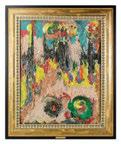



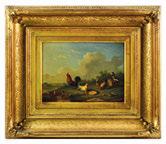






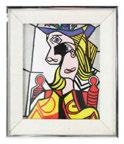



















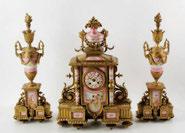










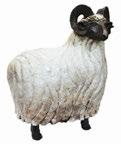






Friday, August 16th at 10 am
Previews:
Sunday, August 11th, 10 am - 5 pm
Thursday, August 15th, 10 am - 5 pm
Friday, August 16th, 9am - end of auction
Monday, August 12th; 9 am
Tuesday, August 13th; 9 am
Wednesday, August 14th; 9 am
Previews:
Sunday, August 11th, 10 am - 5 pm
Monday, August 12th, 9 am - 5 pm
Tuesday, August 13th, 9 am - 5 pm
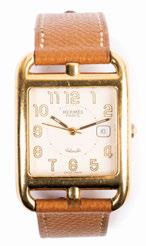

Michael Jordan Framed and Signed Jersey with Upper Deck authentication.

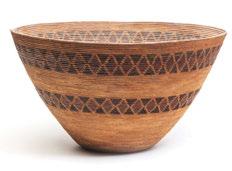

Wednesday, August 14th, 9 am - end of auction
To view a catalog or to download Michaan’s app to bid online visit bid.michaans.com.



Upper Deck authentication number ‘BAF01380’ badge to jersey matches






















FRIDAY, AUGUST 16, 2024















Merrill’s Auctioneers and Appraisers is pleased to offer items from the estate of Hester Fearing Black (1933-2023) of Stowe, VT, the daughter of George Richmond Fearing, Jr. and Vera Whistler Howell Fearing. Many objects descend from George R. Fearing (1839-1920) president of the Knickerbocker Club during the Gilded Age, and builder of “The Orchard” one of the oldest Newport, R.I. mansions, as well as other consignors, to include Early American Furniture, Paintings, Prints, Books, Photographs, Civil War material, Oriental rugs, Glass, China, Silver, Jewelry, & Accessories.
This sale features an important watercolor seashore landscape “The Sea Grey & Silver” by James McNeil Whistler, descending directly in the Whistler family with accompanying family history. Of note is an important early 20th c Russian painting of 3 women and a baby by Philip Andreevich Maliavin (18691940). Also of interest is a life size bronze sculpture of a young horse “Pecos” by Canadian sculptor Joe Fafard (CA 1942-2019).
This sale also features an important archive of letters to Mrs Sarah Fisher Ames (1817-1901, sculptress of busts of Abraham Lincoln & Civil War Battlefield Nurse), including a Jan 5, 1865 letter from President Abraham Lincoln to the Surgeon General “The bearer of this, Mrs Ames, wishes to go anywhere she can to minister to our wounded, and I shall be glad for you to give any facilities you can, consistent with the services”, also letters from Generals, Cabinet members, & authors, including Oliver Wendell Holmes, Henry Wadsworth Longfellow, & John Greenleaf Whittier.
The sale also offers a fantastic pair of 18th c Chinese cache pots decorated with horses, a fine 18th c portrait of a young girl by Francois Hubert Drouais (Fr 1727-1775), & three large sporting watercolors of grouse by A Lassell Ripley (1896-1969).


Preview in person THURSDAY, August 15th from 1 to 6 pm, & FRIDAY, August 16th from 8 am until 9:30 am sale time, or by prior appointment. Please review our catalog through our online selling platforms – LiveAuctioneers, Invaluable, & AuctionZip. Payment can be made with a credit card over the phone, secure billing provided for online purchases.

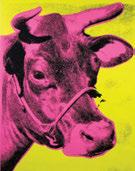















We are pleased to offer all items in this auction without reserve.
Nine pieces of Adirondack furniture #6 Shaker rocker; mid19th Century 2-drawer blanket chest; mid-20th Century chair & ottoman; sculpture trophy for USS Hawk 1914; dog andirons; a fire hydrant; wicker pram w/umbrella; dress forms; 6 pc painted pine bedroom set; stoneware; crocks; jugs; old sand pails; child’s size sleigh; a lot of 45rpm records; pocket knives; hunting knives; “Not a Bolt” folding stove; green Depression, pink Depression glass; Oriental chargers; head vases; costume jewelry; some sterling; Spanish American War uniform; US Army Air Forces flying trousers; baseball jerseys 1940s; 1940s detective comics & Westerns; 1960s-70s Galaxy I Science Fiction mags; painting of steamship w/masts in battle; 2 vol set “The Soldier in the Civil War” and “Army Military Equitations Bleaking Horses” 1778 by Pembroke; several VT in Civil War books; 1819 “Geography”; large Gene Autry poster; many prints & lithographs; 19th Century tilt top game table; WWI posters; some old toys; wooden shaft golf clubs; Liberty blue china; 100s of purses & scarves.









— Over











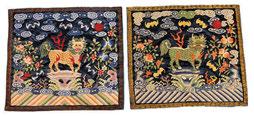










































914-882-7356 • E-mail: mag2715jag@aol.com www.midhudsongalleries.com
SATURDAY, AUGUST 17th at 2pm
Exhibition: Friday, Aug. 16th Noon-3pm & Day of Sale Noon-2pm 179 Temple Hill Road New Windsor, NY 12553
ARTWORK: Florence (Griswold) Woodward Blanche Lazzelli; Kaiko Moti; Ariside Mailloi; Edward Dykes; George C. Landis; Amelio Schwicker; A. C. Boyd; George Morandi; Agnes Weinrich; 20thC. American Modernist Mixed Media - Provincetown 1944 Signed WORKS ON PAPER Miro lithograph, Romain (Erte) De Tirtoff LARGE COLLECTION OF TAINO ARTWORKS, RAREST COLLECTION OF CAST IRON DOORSTOP incl. very difficult to find HOLLYWOOD & CELEBRITY PHOTOGRAPHS AND ORIGINAL NEGATIVES (Thousands) Being sold in large lots. Many unsorted lots. MORE Many bronzes incl. Art Deco in the manner of Chiparus, Preiss, Milo, Poertzel etc.; antique leaded domes and shades; 15.70 ct. yellow sapphire; Swarovski figures and snowflakes 1995-2021; Hummel figures (50) being sold in large lots; Sports memorabilia; military memorabilia incl. 1942 Colliers magazine with Hitler cover; toys incl. 1930’s Flash Gordon Rocket Fighter, Daisy & Red Ryder Air/BB guns; clocks. Very diverse auction, a treasure trove of large lots for


and collectors.
































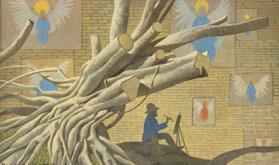

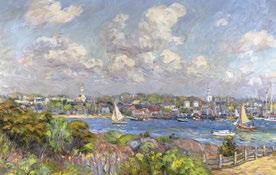








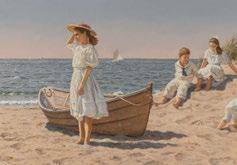










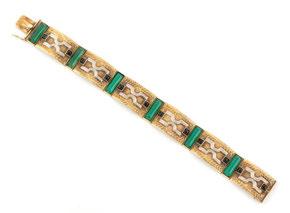


















August 17th, Saturday, 11:00 AM 15 Mt Carmel Rd, Danvers, MA 01923
Kaminski Auctions will feature a range of notable items from the chapel, including large multi-sectional stained-glass windows, an elegant marble altar, various lighting fixtures, chalices, candlesticks, and monstrances, alongside exquisite garden statuary. Interested parties are encouraged to a end to experience the remarkable beauty and cra smanship of these items firsthand. With selected additions. Auction to be held at the monastery, 15 Mt. Carmel Rd, Danvers, Massachuse s. For more information, go to www.kaminskiauctions.com
Please note that buyers will be responsible for the removal and associated costs of transporting purchased items. Kaminski Auctions will provide recommendations for two experienced companies specializing in glass removal and transport to facilitate this process. Bidding is available in person, by phone or absentee bid, and online with KaminskiLIVE, our online bidding platform.
Preview for this exciting auction is August 14-16th, 2024, 9:00 AM-5:00 PM at the monastery.




















FLOWER FAMILY COLLECTION – THE GRAND FINALE
This auction includes 225 lots of fine majolica from the Flower Family Collection including many rare pieces of Minton, George Jones, Wedgwood, Holdcroft, Avisseau Palissy, Hugo Lonitz and much more.
THIS IS AN IN-PERSON LIVE AUCTION WITH INTERNET BIDDING.
TUESDAY, AUGUST 20, 2024, Starting at 10am


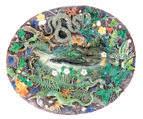

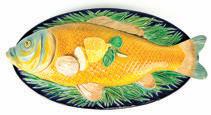





Preview: Monday, August 19 from 4 to 6 pm Located at the Strawser Auctions Facility – 106 E. Dutch Street, WOLCOTTVILLE, INDIANA Visit our website for a link to our online catalog, www.strawserauctions.com TERMS:




Michael G. Strawser, Auctioneer
332 | Wolcottville, IN 46795 | 260-854-2859 | michael@strawserauctions.com | www.strawserauctions |

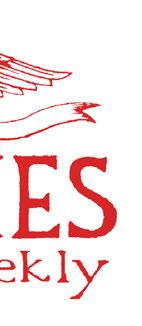





















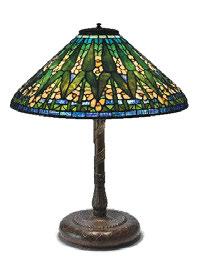

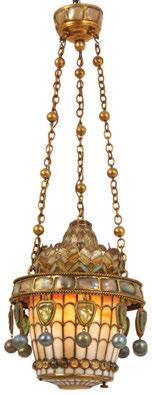


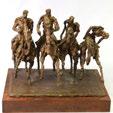





Fine jewelry, silver, contemporary bronzes, paintings, prints, period furniture, lighting, clocks, vintage toys, pottery, glass, stoneware, American country antiques, Oriental, Navajo & hooked rugs, large African Yoruba ceremonial beaded tunic, automobilia gasoline porcelain & enamel signs, advertising. Included is a large selection of lots from the collection of Brimfield collector & dealer, Ron Rainka of Warren, Massachusetts, rare early Telephones & more.




















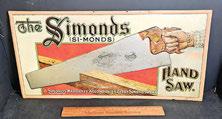


Tuesday, August 13th 2024 @ 5pm
Preview 3:30pm at 3605 South St., Madison, NY
Just 2 miles east of the Madison Bouckville Antique Shows
We are pleased to be selling without reserve great collections of fresh to the market items.
As always, this will be the auction not to miss. Expect surprises. Info: 315-893-1883.
(Please note day & times!)
Absentee Bids must be completed by 5pm on Monday, August 12th. No phone bids. No Live On-Line Bidding!
New This Year! – Full Catalogue on www.madisonauctionservice.hibid.com, July 6th & Absentee Bids may be left though HIBID.
Signs: Hampden Paint, Beacon Feeds, Coca Cola, Pepsi, Hudson Feed, Gaines dog Food, AAA, Bell Telephone, Smith Corona, Octagon Soap, Bixby Dressing, Petroliana: Penzoil, U.S. Royal Tires, Champion, Kendall, Mobil, Gulf, Trico, Chrysler, Plymouth, Oil Bottles. Tins: Coffee, Tobacco. Brewery: Schlitz, Anheuser-Busch, Old Barbee, J.H. Cutter, Central. Store Displays, Toys; Mechanical Banks, Cast Iron, Wind Ups, Banks, Board Games, Thermometers: Prestone, Cigar, Pepsi, Coca-Cola, Arbuckle’s. Misc: Adv. Clocks, Stained Glass Café Windows, Store Display Cases, Dye Cabinets, Manikin Displays, Coffee Grinder, Heinz Firkins & Jars, Copper Roasted Peanut Display, Water Sprinklers, Advertising Boxes, and Much More.


















